Heads up! The 2020-2021 Smart Trainer Recommendations Guide is now up! Go check out that one, instead of this stinky old 2019-2020 guide!
The trees are turning colors and the leaves are falling. Except if you live in Australia. But for those of us in the Northern Hemisphere you’re probably thinking about spending more and more time indoors on a trainer, and perhaps looking at a new trainer.
Of course, over the last few years we’ve seen a shift towards year-round indoor training. Certainly many people trained at least part of their workouts year-round indoors, but with apps being more and more engaging (and driver interactions getting worse and worse) – people are simply spending time even on sunny days indoors riding.
Now in years past I’ve covered all trainers, from $70 units up to $1,600 trainers. But for this year’s post(as with last year’s), I’m really going to focus only on smart trainers. Specifically ones that transmit some sort of ANT+ and Bluetooth Smart signal (dual/concurrently), and allow control of the trainer itself (via ANT+ FE-C and/or Bluetooth Smart FTMS). In other words: A company has to follow the well recognized standards to even be considered for this list.
In any case, we saw new smart trainers (or indoor bikes) from virtually every major brand this year, as well as some smaller brands. Some of them made big jumps, while most made more incremental bumps in specs and features. Evolutionary – not revolutionary. And some of them just issued moderately big firmware updates adding new features.
At this point almost every trainer announced this season has started shipping. There are some exceptions though, and as such – I’ll note why those aren’t on the recommended list and where they might stand on a provisional list until I get them in-house to test. Generally speaking, I’m not going to recommend something unless I have a unit in the DCR Cave (exceptions are noted as such). So for things that are still outstanding, it’s tougher for me to recommend them at this time. I have notes at the bottom of this post for all my caveats and why-nots.
Finally, for indoor bikes – specifically the Tacx NEO Bike, Wahoo KICKR Bike, and WattBike ATOM, I have a separate shoot-out post coming up next week that tackles that individually.
How I Make Trainer Recommendations:
First and foremost, I only recommend trainers I’ve actually used. Certainly, there are some trainers that were announced this year that aren’t yet available – you won’t find those recommendations here unless I have a unit on-hand. An example of this being the Elite Tuo – I think it could be a stand-out option in the budget wheel-on category. But my only experience is a couple of minutes of pedaling a prototype at Eurobike. So it’s hard to judge things like accuracy or total ride feel until they’ve got production units (apparently within a few weeks). So in the two specific examples where I think it could be a solid contender but don’t have full testing time, I’ve listed them as ‘Provisional inclusions’. In other words, it’s worth placing a pre-order you can cancel later if my full review finds they fall flat.
When I look at recommendations across all products I make, I try and recommend products to you in the same way that I’d do to friends and family. I keep it simple and explain exactly why I feel a given way.
My goal is NOT to make a roundup of every trainer on the market.
Though I will briefly discuss why I didn’t include some trainers in this piece at the end. This is, again, my *recommendations*, not the holy grail of everything ever made by everyone. Still, I’m lucky enough to have been able to try almost everything made by all the major trainer companies this year, at least at the mid to upper end (I don’t tend to review the 112 different models of trainers from $75 to $200).
Price Ranges & Currencies:
Over the last few years we’ve continued to see major shifting in price vs feature-set combinations. For example, functionality and accuracy that used to be reserved for $1,200 trainers has slid down to $900 trainers and even $700 trainers. I had to change my price bucketing last year to account for this (again). My purpose isn’t so much moving the goalposts, as it is making the groupings more logical. Meaning, someone looking to spend $599 is probably OK spending $699, and someone teetering at $529 might be OK spending that $699 too if the benefits make sense.
Meanwhile, someone looking for a $599 trainer isn’t likely the same person as one looking at a $1,199 trainer. So, here’s the 2019 buckets, aligned to the trends of trainer pricing in 2019:
Budget – Sub-$500: Most of these (all of these?) are wheel-on trainers that have basic smart trainer functionality (including replicating climbs, setting specific wattages, and working with apps). However, they tend to be less powerful trainers and may not be as accurate or as realistic feeling.
Mid-Range $500-$700: These tend to be units that have everything of the price bucket below it, but usually with just a bit more accuracy and a bit more power. Often with that slightly better road feel.
Mid-High End $700-$975: This category exists because there’s a clear line in the sand between the flood of sub-$599 trainers, and the flotilla of $700-$800 trainers. I just don’t think it makes sense to put them in the lower-priced category, though the case could easily be made that they compete with the $1,000+ trainers (and are almost universally a better buy). The key difference here tends to be accuracy and road-feel, once again stepping it up a bit.
High-End $999+: These are the high-end trainers, and primarily distinguish themselves from the mid-range by increasing durability, reducing noise, increasing road-like feel, incline/wattage increases, or just being expensive for the heck of it (i.e., legacy branding/marketing).
Now – you’ll notice the dollar signs, which in this case is implying US pricing. I call this out specifically because the whole pricing business has gotten kinda wonky, especially in the differences between US and European markets. There are specific cases where something may have a price gap in one market (i.e., KICKR vs. NEO in the US), yet be nearly identical in other markets (some European countries). Similarly, the European markets generally get a better deal on European-made products (Tacx/Elite), while US consumers tend to get better pricing on US-made products (Wahoo). All of which ignores the reality of MAP (Minimum Advertised Pricing), which exists in the US and doesn’t exist in Europe.
Next, be wary of purchasing trainers outside your home country (meaning, if in the US, buying from a retailer in Europe). This is because if you have a problem, you’ll be on the hook to pay for shipping of the trainer back across the pond for service. As one who does that regularly, it’s @#$#@ expensive. If you don’t believe me, go and look at the older 2015 trainer recommendation post, and see the river of tears for folks who have had to deal with cross-Atlantic shipping of cheap trainers they bought when things went wrong. By all means, if you understand the risk – buy where it makes sense. But do understand it’s a very real risk.
And finally, note that I tend to focus on trainers that have some element of technology in them. It’s not that I think that all non-technology trainers are the same (cause they aren’t…well…except that most are), but it’s because that’s just what I happen to review the most here.
Things to Consider:
There’s a lot of things to look for in a trainer – but some are applicable across the board from a sub-$100 unit to a $1,500 unit.
First and foremost, it needs to be sturdy. The more plastic involved, the less likely it’s going to last over time – at least on vulnerable and load-bearing components/areas. Take for example, the old CompuTrainer, otherwise known as the rock. A tank really. I’m certain I could throw that in front of a semi-truck, and it’d probably be fine. As such, those units last 10-15 years (or more). In fact, I don’t know anyone who’s ever broken a CompuTrainer frame (ok, ignore the flywheel). Some electrical components eventually wear out, but the frame is astoundingly sturdy. I find the Wahoo KICKR in that same camp. It’s a beast component-wise. In many ways, the KICKR SNAP frame is the same way – as are the Kinetic frames too.
Inversely though, while the Tacx NEO series shell is made of plastic, directly under that layer is a metal frame. And nobody is kicking the side of their trainer randomly from that angle. Frankly, looking at anything on this list there’s no durability-type issues. The ‘worst’ durability type issue we’ve seen is the stickers (chevrons) on the back of the Wahoo KICKR/CORE trainers flying off the flywheel. Which I feel is almost a badge of honor that you put out that much wattage.
Second, look at the attachment point to your bike. I’ll start with the ones that leverage a skewer of some sort and don’t require removal of the wheel. In these cases, try to find one that has a ‘quick-release’ mechanism for quickly locking the trainer into place. One that doesn’t require you to endlessly spin the tightening lever and try to find an exact spot each time. See below for an example of a quick-release lever on the mid-range Tacx options:
In the case of trainers that you attach your bike directly into a cassette mounted on the trainer – called ‘direct drive trainers’, be sure that it’ll be compatible with your bike frame. There are only a few edge cases where an incompatibility occurs (primarily higher-end bikes, usually of the triathlon or disc variety), but just be aware of them. Many trainer companies have printouts on their support sites where you can double-check frame compatibility on your bike.
And if you’ve got a disc-brake equipped bike, ensure that the trainer you’re purchasing includes the adapters for that. Generally speaking, most trainers include 130/135 x 5mm & 142 x 12mm adapters, but require you purchase extra adapters for other sizes. Beware if you’re looking at an older unit (like 3+ years old), as many of these didn’t support thru-axle natively, or even at all. These days in 2019 it’s less of an issue.
Speaking of fancy, if you’re going with something like SRAM’s AXS 12-speed bikes, be sure that your trainer works with that. Most companies have adapters (and in many cases finally just released them in the past few months), but not always. I *strongly* encourage you to e-mail the company in question and ask them about your specific bike and the specific trainer to validate compatibility.
Third, look at how stable the platform is. The smaller the base of the trainer, the more likely it is to tip over (and you along with it). And while tip-overs are extremely rare – they are a problem on lower end trainers ($50-$150) where the base is really small. This can be further compounded when the trainer mounts the wheel higher up – meaning a higher center of gravity. It’s not hard to get a situation where you try and reach for a TV remote control, or something off to the side, and fall over. None of the trainers I’m recommending have this issue, but in general, keep it in mind.
Fourth, direct drive or wheel-on? If you went back 3-5 years ago, only the most expensive trainers were direct drive and the rest wheel-on. But these days direct-drive smart trainers are down to $699, and that’s great for consumers. Wheel-on trainers mean that you mount the entire bike, inclusive of your back wheel, to the trainer. Whereas direct-drive trainers mean you remove the back wheel and attach the bike directly to the trainer (via a cassette on the trainer). This means that you generally don’t get any tire slip on direct drive trainers, and for many models you can also get away without having to do calibration/spin-downs.
These days my preference is overwhelmingly direct-drive, but I also totally get that such a trainer may be out of the ballpark of one’s budget.
Fifth, how do you move it around? This might sound silly – but if it’s a heavier trainer (which is most mid-range and above trainers), then is there some sort of handle to move the darn thing around? Most of these trainers come in at nearly 50 pounds (about 23KG) – so they’re beastly.
Again – virtually everything on this list has already taken into account all of these considerations. But still, it’s worthwhile thinking of them and how they factor into your decision-making process.
Technical Considerations:
Ok, we’re almost to the recommendations. But we need to all be on the same table when it comes to some of the technical terms that we’re going to talk about. Notably, the protocols and communications side of how trainers talk to apps.
In the sports world there are essentially two camps: ANT+ & Bluetooth Smart. Virtually all devices use one or both of these low-power technologies to transmit and capture information such as heart rate, power, speed, cadence, and more.
In the trainer realm, that means trainers tend to support two types of things over these protocols. The first is simple broadcasting (one-way) from the trainer to the app/device that you’re using. This is done for the following on trainers:
ANT+ Broadcast: Power, Speed, Cadence
Bluetooth Smart Broadcast: Power, Speed, Cadence
Compatible devices, such as a Garmin/Suunto/Polar/Wahoo unit can pick up these signals and record them. The same goes for apps like Zwift, TrainerRoad, or Rouvy. Almost all trainer companies now broadcast dual on both protocols concurrently. No trainers in the 2019 guide fail to meet this requirement, to me it’s considered a baseline specification.
Next, for control there are basically two semi-standards that allow trainers to be controlled via apps:
Open/Standard Communication Channel: Via ANT+ FE-C (all trainers use this today) or Bluetooth Smart FTMS (most trainers have this today as well).
Private communication channel: Prior to FE-C and and FTMS there wasn’t a standard. So each company did their own thing. Wahoo, CycleOps (now Saris), Tacx, Elite, Kinetic, etc… Most of these companies now support the ANT+ & Bluetooth Smart standard versions, but some of them also support their older variants to help out older apps.
For ANT+ FE-C, devices such as the Garmin and Wahoo cycling units support controlling the trainer straight from your head unit. This also means you can re-ride your outside rides (elevation changes and all) without any other software.
Meanwhile, for Bluetooth Smart, there’s FTMS, which is basically the same thing as FE-C when it comes to trainers. It’s not quite as widely adopted yet by trainer companies, but is by app companies. On the trainer company side only Elite, Saris, and Kinetic support it across the board. With Tacx having it on some but not all units, and Wahoo having it on no units (but all Wahoo and Tacx trainers support private Bluetooth Smart with all major apps anyway).
Ultimately, almost all major apps support all companies’ Bluetooth Smart implementations (whichever variant they’re on). Where the issue matters more is smaller apps that may not have the time to implement all the variants. Nonetheless, here’s where things stand.
Elite: ANT+ FE-C and Bluetooth Smart FTMS on all 2019 smart trainers.
Gravat: ANT+ FE-C and Bluetooth Smart FTMS on all 2019 smart trainers
JetBlack: ANT+ FE-C and Bluetooth Smart FTMS on all 2019 smart trainers.
Kinetic: ANT+ FE-C and Bluetooth Smart FTMS on all 2019 smart trainers.
Minoura: ANT+ FE-C and Bluetooth Smart FTMS on all 2019 smart trainers.
Saris (CycleOps): ANT+ FE-C and Bluetooth Smart FTMS on all 2019 smart trainers.
STAC: ANT+ FE-C and Bluetooth Smart FTMS on all 2019 smart trainers.
Tacx: ANT+ FE-C on all ‘Smart’ branded trainers (except Satori). FTMS on some models (mainly non-NEO series). For remainder of trainers there’s still Bluetooth Smart control that all apps support.
Wahoo: ANT+ FE-C on all smart trainers. Gives developers access to private Wahoo Bluetooth Smart control.
This all matters when it comes to apps – but the thing you need to know is that you want your trainer to be dual capable, and it should ideally support if you want resistance control across a broad number of apps. But ultimately, if you buy any trainer from this guide, it’ll be some variant of dual.
Budget Smart Trainers (sub-$499):
There’s once again been almost no appreciable shift in this category this year, so things stay basically the same as last year. And, there’s really only a few entrants in this category anyway. Only Tacx, Elite, and BKool compete in this realm from a legit smart-trainer standpoint (ones where you can control resistance).
But let me be clear – there are TONS of trainers out there for less than $500 that don’t have any smart electronic gadgets in them and work just great. Really, there are. But there’s only a few units in this price range (again, looking at USD MSRP) that have ANT+ & Bluetooth Smart broadcasting of speed, power, and cadence…AND…control of the incline/wattage.
Lastly, this is the one category I don’t have a ton of riding time on either of those units. Both of them have been at trade shows or the like.
The two options that I can recommend are as follows:
Tacx Flow Smart – 239EUR/329USD: This is without question the least expensive smart trainer on the market, though it mostly is only available in Europe (some European companies may ship to the USA). This tops out at only 6% inclines and 800w. The 800w piece probably isn’t too challenging for most people, especially triathletes, but the 6% gradient may be tricky (of course, if you leave defaults on Zwift, you’re unlikely to notice). GPLama/Shane Miller has tested this in a video, and it’s definitely worth a watch. I certainly wouldn’t recommend this for heavier riders, but it might work well for lighter riders that are mostly doing ERG work (structured workouts). Finally, the accuracy spec is only +/- 10%, which is the least accurate unit of the entire bunch. Still, for the price, as Shane says – you get what you pay for – but definitely watch his whole video. Oh, and the Flow supports both ANT+ & Bluetooth Smart and all the goodness you’d expect.
BKool Smart Go – $399USD: This is three years old now, but still a unique option. The unit replicates up to 8% grades and 800w, so pretty similar to the Tacx Flow, but with an oddly unstated (or findable) accuracy specification. Most others have found it fairly variable. I haven’t done a full review of the Smart Go, but have done the other BKool trainers and have things a bit variable. Since it’s ANT+ FE-C controllable, you’ll be able to have 3rd party apps control it like most of the higher end trainers. Note that I do get mixed reviews from folks on BKool service, so I’d probably be more likely to recommend this to someone that’s confident in their retailer (and their return/support policies). Also note that I’ve ridden it at trade shows, but haven’t spent a ton of time on it outside of those venues.
Mid-Range Trainers ($499-$700):
While this is a very specific price bracket, it mostly captures the entire mid-range market. And to be perfectly clear: They’re all about the same, except one. There are minor nuances between these trainers, for which you’ll want to look at closely, depending on your needs. Specifically, look carefully at these four areas:
A) Maximum incline
B) Maximum wattage
C) Which protocols/standards/types they transmit on (i.e., power, but not cadence, etc…)
D) Flywheel weight
That’s about the only real tangible differences between them. They all have about the same road feel (and each company will tell you their road feel is better). They all have ANT+ FE-C and Bluetooth Smart control, and they all work with Zwift and TrainerRoad.
The flywheel weight, in theory, gives a more road-like feel, but the thing is, at these weights, it’s all kinda wimpy to begin with. I know a lot of folks want the most road-like feel, but my brain can’t really separate out the fact that I’m still inside looking at a wall going nowhere. I’d rather have greater accuracy and more app support than the mythical road-like feel. Still, at this level it’s definitely different between these $500-$600 trainers and those a $1,000+.
Now this line-up has mostly remained the same. However, Elite has introduced the Tuo, which based on my brief Eurobike testing seemed to have far better road-feel than I expected at this price point. But it isn’t shipping yet and I don’t have a unit for real testing yet. Last year Elite also had Zumo included in the list provisionally, assuming they worked out some kinks. They didn’t work those out until this past summer (for real). And in fact, it was only this morning that I finally got on a unit with updated firmware to get it tested on two rides. Good news – it’s solid (finally)!
Meanwhile, there’s also 4iiii with the new Fliiiight (previously by STAC). That too was announced at Eurobike and I think it’s super compelling, but I don’t yet have a unit in for testing and they haven’t started shipping yet. It seems to have righted most of the quirks with the original STAC Zero virtually silent trainers (they use magnets instead, it’s cool if you haven’t seen it). But again, definitely provisional until I can get it in to test.
There are also very minor differences in how you mount your bike to each one in terms of the clasp/lever, but that’s too a wash. About the only notable difference here is that the Saris Magnus/M2 has a nifty resistance knob that makes it easy to ensure your bike is at the same resistance setting each time. It’s actually kinda brilliant.
But no matter, all of these will require calibration about 10-15 minutes into a ride to ensure accurate numbers. With that in mind, here are your lower-priced options:
4iiii Fliiiight $599 (provisional inclusion)
Elite Zumo – $699 (if you’re looking for direct drive at this price bucket)
Elite Tuo – $499 (provisional inclusion)
Kinetic Smart Control Road Machine 2018 Edition – $569
Saris (CycleOps) M2 – $499
Wahoo KICKR SNAP – $499
Last year I included the Bushido Smart, but it got kicked off the island this year as its price stayed static at $620 despite everyone else going lower, I don’t see any reason to pick up the Bushido Smart at that price. And similarly, the Vortex Smart is at $520, but spec-wise it just doesn’t compete with the others above from a simulation of incline or accuracy standpoint.
I know a lot of folks will want some sort of concrete answer on which of the aforementioned trainers to pick, but the reality is that they are just so darn similar. That’s obviously on purpose, the companies have largely modeled them after each other, and thus the end-state is basically the same. I’d be happy with any of these four trainers. I think the KICKR SNAP is probably the most robustly built of the bunch, whereas I think the Magnus/M2 is the most accurate of the bunch (plus it has up to 15% incline resistance, which along with the Bushido is the most of the bunch). And the Elite Zumo is the only direct drive trainer of the bunch – which is super appealing.
If I were to really narrow it down, it’d probably be between the Elite Zumo and the Wahoo KICKR SNAP. The SNAP has better road-like feel, while the Zumo has the convenience and accuracy of a direct drive trainer (in that you don’t have to worry about tire pressure. Accuracy of power numbers is equal, but in different ways. I find the SNAP slightly more variable on the whole, whereas I find the Zumo can clip some sprints (meaning, it shorts you a bit). Overall, roughly a wash. Keep in mind though with the Zumo you’re still gonna spend another $50 for a cassette to put on it (and another $20 for tools if you or a friend don’t have them). Which means you’re within a few Starbucks visits of the $799 that is the Elite Suito – a more powerful trainer with better road-like feel that includes the cassette pre-installed. And heck, you even get free 30 days of Zwift, FWIW. More on that in the next category.
Here’s some nifty tables that might help narrow it down. Remember, you can make your own comparison tables here.
[Pop-open a new window to see all 6 trainers here]
| Function/Feature | 4iiii Fliiiight | Elite Tuo | Elite Zumo | Wahoo KICKR SNAP (Current edition) |
|---|---|---|---|---|
| Copyright DC Rainmaker - Updated November 17th, 2024 @ 5:42 pm New Window | ||||
| Price for trainer | $599 | $580 | $699 | $499 |
| Trainer Type | Wheel-on | Wheel-on | Direct Drive (No Wheel) | Wheel-on |
| Available today (for sale) | December 2019 | Yes | Yes | Yes |
| Availability regions | Global | Global | USA | Global |
| Wired or Wireless data transmission/control | Wireless | Wireless | Wireless | Wireless |
| Power cord required | No, 2hrs battery capability | Yes | Yes (no control w/o) | Yes |
| Flywheel weight | N/A | 2.5kg / 5.5lbs | 4.2KG/9.2LBS | 10.5lbs/4.8KG |
| Includes cassette | N/A | No | N/A | Resistance | 4iiii Fliiiight | Elite Tuo | Elite Zumo | Wahoo KICKR SNAP (Current edition) |
| Can electronically control resistance (i.e. 200w) | Yes | Yes | Yes | Yes |
| Includes motor to drive speed (simulate downhill) | No | No | No | No |
| Maximum wattage capability | 2200w | 1,250 (40KPH)/2,050 (60KPH) | 1,150w @ 40KPH | 1,500W @ 40KPH |
| Maximum simulated hill incline | 7% | 10% | 12% | 12% | Features | 4iiii Fliiiight | Elite Tuo | Elite Zumo | Wahoo KICKR SNAP (Current edition) |
| Ability to update unit firmware | Yes | Yes | Yes | Yes |
| Measures/Estimates Left/Right Power | No | No | No | No |
| Can directionally steer trainer (left/right) | No | No | No | No |
| Can simulate road patterns/shaking (i.e. cobblestones) | No | No | No | No | Motion | 4iiii Fliiiight | Elite Tuo | Elite Zumo | Wahoo KICKR SNAP (Current edition) |
| Whole-bike physical gradient simulation | No | No | No | With KICKR CLIMB accessory |
| Can rock/tilt side to side (significantly) | No | No | No | No | Accuracy | 4iiii Fliiiight | Elite Tuo | Elite Zumo | Wahoo KICKR SNAP (Current edition) |
| Includes temperature compensation | Yes | Yes | Yes | Yes |
| Support rolldown procedure (for wheel based) | N/A | Yes | Yes | Yes |
| Supported accuracy level | +/- 1% | +/- 5% | +/- 3% | +/- 3% | Trainer Control | 4iiii Fliiiight | Elite Tuo | Elite Zumo | Wahoo KICKR SNAP (Current edition) |
| Allows 3rd party trainer control | Yes | Yes | Yes | Yes |
| Supports ANT+ FE-C (Trainer Control Standard) | Yes | Yes | Yes | Yes |
| Supports Bluetooth Smart FTMS (Trainer Control Standard) | Yes | Yes | Yes | Yes | Data Broadcast | 4iiii Fliiiight | Elite Tuo | Elite Zumo | Wahoo KICKR SNAP (Current edition) |
| Transmits power via ANT+ | Yes | Yes | Yes | Yes |
| Transmits power via Bluetooth Smart | Yes | YEs | Yes | Yes |
| Supports Multiple Concurrent Bluetooth connections | No, just one | No, just one | No, just one | |
| Transmits cadence data | Yes | Yes | Yes | No | Purchase | 4iiii Fliiiight | Elite Tuo | Elite Zumo | Wahoo KICKR SNAP (Current edition) |
| Amazon | Link | Link | Link | |
| Backcountry.com | Link | Link | ||
| Competitive Cyclist | Link | Link | ||
| REI | Link | Link | Link | DCRainmaker | 4iiii Fliiiight | Elite Tuo | Elite Zumo | Wahoo KICKR SNAP (Current edition) |
| Review Link | Link | Link | Link | Link |
Mid-High End ($700-$975):
This is a tricky category, and where the vast majority of ‘innovation’ is occurring. Though, not necessarily product innovation, but rather just price innovation. Companies continue to pack more and more features and power into sub-$1000 trainers. Especially trainers in the $799-$899 price points.
And in some ways, these companies are slicing and dicing really thinly. For example with Tacx you’ve got the Flux S ($749) and Flux 2 ($899) both in the market. And Elite has the Zumo ($699), Suito ($799), and Direto X ($899). In the case of Tacx, they’ve quietly refreshed the Flux 2 this year to rid it of issues from last year around ERG mode (it was horribly inaccurate). That includes a bunch of internal shifts that actually make it a trainer worth buying, though I haven’t tested one yet and don’t have one here to put through its paces.
But then there’s the KICKR CORE. That came out last year when Wahoo basically took a full 2017 KICKR and made it silent. They then lopped $300 off the price. This meant that you got what up until last summer was one of the best trainers on the market that was loved by most, for $300 cheaper – and now it didn’t make any tangible noise. Well, until it broke. But I think those issues are almost entirely behind us these days for people going out and buying new trainers. I sure as hell wouldn’t touch any used 2018 Wahoo trainers though, god no.
In any case, that pretty much decimated the value prop for the Elite Direto at $899 or the Tacx Flux 2 at $899. Elite dropped their price to $849, though I still don’t think that really does a ton. Instead, they launched the Suito this year at $799 with an included cassette. And I think that’s hitting a bit of the sweet spot. Or, Suito-spot. You get a direct drive trainer that requires zero assembly – pull it straight out of the box, plug it in, and you’re riding. And doesn’t cost anything more. With all the other direct drive trainers in this category you’ll still need to do some assembly as well as adding that $50 cassette (+ $20 in tool costs if you don’t have them).
Wahoo KICKR CORE:
There’s really no surprise this trainer is here. Now, it definitely had a rough winter with after-sales issues that crept up and caused, rightfully so, lots of upset people. A combination of noise issues and electrostatic discharge issues that killed units with merely a single touch. But as we stand here in October 2019, the complaints about those issues for people buying new units have evaporated. Wahoo continues to sell those units in higher volumes than ever before, so given that combination – I think this is solved.
In any case, ultimately, the CORE is essentially a 2017 KICKR that’s been muted. If you had told someone early last summer that they can buy a quiet KICKR for $300 less, albeit with no ability to adjust height – people would have scrambled for it. And, that’s what happened.
Finally, the CORE is compatible with the KICKR CLIMB. The fact that the CORE is compatible with the KICKR CLIMB means that you can get a CORE + CLIMB for $1,500, versus just a KICKR FOR $1,200. Said differently, you can justify to your significant other that you’re saving $300.
Elite Suito:
Next, we’ve got Elite’s pretty darn smart plan of simplifying the end user experience – rather than just throwing another trainer into the $700-$800 mix. With the Suito you get the cassette pre-installed on the trainer. The only other trainer that has that is the full Wahoo KICKR (at $1,199). Heck, Elite even saves you $5-$10 by tossing in a front wheel riser. All while giving you a fairly capable direct drive trainer. Finally, it folds up easily for storage and comes entirely pre-assembled.
Now the key difference between the Elite Direto/Direto X and the Suito is the lack of power meter within it (called OTS by Elite). But keep in mind, having a power meter in it doesn’t really matter. What matters is whether or not it’s accurate. After all – neither the Tacx NEO or Wahoo KICKR series have power meters in them, and are just fine with accuracy (in fact, Wahoo even ditched the power meter in theirs years ago due to accuracy issues). Of course, nobody is saying the Direto-X isn’t accurate. It is. It’s incredibly accurate.
But with the latest Suito firmware update that I got last week, it too is pretty darn accurate. I have no issues with it from a Zwift or TrainerRoad standpoint, meaning no issues in regular riding, sprints, or doing ERG mode 30×30’s – all of which can be demanding. That said, Elite does seem to be going through some teething pains with the Suito production – with a few people reporting early units back in September having uneven flywheels and other quirks. The number of complaints seems to have tapered off in recent weeks, and Elite seems to swap out any units pretty quickly if people have issues. It wouldn’t keep me from buying it from any reputable dealer.
All in, I think the Suito is this year’s best value for a trainer, especially if you aren’t really sure what you need or want. Sure, the Wahoo CORE has more inertia and thus slightly better road-feel. But the Elite Suito will basically save you $150 once you factor in the cassette cost. Oh, and the Suito does also include a 30-day free Zwift trial, which is oddly hard to get otherwise (Zwift themselves only offers 20 kilometer free trials, for realz). So again, if you don’t really know what you want, it’s an ideal option to play the field.
Tacx Flux S:
Sitting at $150 cheaper than the CORE at $749, the Flux S is basically just the 2016/2017/2018 Flux 1 with a bunch of internal changes and support for longer derailleur cages. And by basically, I mean, that’s all it is. But that’s OK. The Flux 1 was incredibly popular and for good reason. It was the first direct-drive smart trainer below $1,000 when it came out, and supported all the apps people wanted. Thus, it’s an easy pick.
Now between this and the Elite Suito, it’s a tough call. It’s basically a wash price-wise once you factor in the required cassette. Form-factor the Suito wins because it can fold its legs for storage, though the Flux is a bit beefier in terms of stability. I feel like the Flux has slightly better inertia than the Suito, though I also think the Flux sounds a bit more ‘rough’ than the Suito does (a bit more gravelly, if that makes sense).
Neither the Flux S or Elite Suito is silent in the same way the CORE is. But ultimately, all those trainers make some amount of noise once you put a bike on it. After all, there’s still a drivetrain of metal on metal. No doubt the CORE is very quiet, but once you turn on a fan – all of these trainers are quiet in comparison.
| Function/Feature | Elite Suito | Tacx Flux S | Wahoo Fitness KICKR CORE |
|---|---|---|---|
| Copyright DC Rainmaker - Updated November 19th, 2025 @ 3:55 pm New Window | |||
| Price for trainer | $799 (incl cassette) | $749USD | $499 |
| Trainer Type | Direct Drive (No Wheel) | Direct Drive (no wheel) | Direct Drive (No Wheel) |
| Available today (for sale) | Yes | YEs | Yes |
| Availability regions | Global | Global | Global |
| Wired or Wireless data transmission/control | Wireless | Wireless | Wireless |
| Power cord required | Yes (no control w/o) | Yes | Yes |
| Flywheel weight | 3.5kg/7.7lbs | 6.7kg (simulated 25kg) | 12.0lbs/5.44kgs |
| Includes cassette | Yes (11 Speed SRAM/Shimano) | No | No | Resistance | Elite Suito | Tacx Flux S | Wahoo Fitness KICKR CORE |
| Can electronically control resistance (i.e. 200w) | Yes | Yes | Yes |
| Includes motor to drive speed (simulate downhill) | No | No | No |
| Maximum wattage capability | 1,900w @ 40KPH / 2,900w @ 60KPH | 1,500w @ 40KPH | 1800w |
| Maximum simulated hill incline | 15% | 10% | 16% | Features | Elite Suito | Tacx Flux S | Wahoo Fitness KICKR CORE |
| Ability to update unit firmware | Yes | Yes | Yes |
| Measures/Estimates Left/Right Power | No | No | No |
| Can directionally steer trainer (left/right) | No | No | No |
| Can simulate road patterns/shaking (i.e. cobblestones) | No | No | No | Motion | Elite Suito | Tacx Flux S | Wahoo Fitness KICKR CORE |
| Whole-bike physical gradient simulation | No | No | With KICKR CLIMB accessory |
| Can rock/tilt side to side (significantly) | No | No | No | Accuracy | Elite Suito | Tacx Flux S | Wahoo Fitness KICKR CORE |
| Includes temperature compensation | Yes | Yes | Yes |
| Support rolldown procedure (for wheel based) | Yes | Yes | Yes |
| Supported accuracy level | +/- 2.5% | +/-3% | +/- 2% | Trainer Control | Elite Suito | Tacx Flux S | Wahoo Fitness KICKR CORE |
| Allows 3rd party trainer control | Yes | Yes | Yes |
| Supports ANT+ FE-C (Trainer Control Standard) | Yes | Yes | YEs |
| Supports Bluetooth Smart FTMS (Trainer Control Standard) | Yes | Yes | YEs |
| WiFi or Ethernet | No | No | No | Data Broadcast | Elite Suito | Tacx Flux S | Wahoo Fitness KICKR CORE |
| Transmits power via ANT+ | Yes | Yes | Yes |
| Transmits power via Bluetooth Smart | Yes | Yes | Yes |
| Supports Multiple Concurrent Bluetooth connections | No, just one | No, just one | Yes, 3 Concurrent |
| Transmits cadence data | Yes | Yes | Yes |
| Bridging or re-transmission | No | No | No | Purchase | Elite Suito | Tacx Flux S | Wahoo Fitness KICKR CORE |
| Amazon | Link | Link | Link |
| Backcountry.com | Link | Link | |
| Competitive Cyclist | Link | Link | Link |
| REI | Link | Link | Link | DCRainmaker | Elite Suito | Tacx Flux S | Wahoo Fitness KICKR CORE |
| Review Link | Link | Link | Link |
High-End Trainers List ($999+):
Ahh yes, the vaulted space of the super expensive trainers. While the upper-mid tier of trainers gets closer and closer to these units in specs, the distinguishing aspects of the high-end trainers tends to be road feel and resistance ceilings (and to a lesser extent these days, accuracy which is equal/better than +/- 1%).
This category has largely remained the same for the three previous years, (both winners and non-winners alike), but finally, Saris manages to join the ranks of the recommended units list here with the H3. Still, the Wahoo KICKR 2018 and Tacx NEO 2T remain incredibly close – both are silent (save the drivetrain), while the Saris H3 isn’t. It’s quite a bit quieter than the Hammer 1/Hammer 2 were though, thankfully. And, it got a lower price. All three of these are accurate (notably so for me with the latest Tacx NEO 2T firmware 0.31).
Essentially though, you’re left with comparing some minor nuances in features (and entertainment/experience/distraction ‘features’).
By that, I mean that we’ve got what I’m going to call the ‘Move it’ addendum. With the Tacx NEO series that’s the ability for the trainer to simulate cobblestones and other road surfaces. It’s pretty cool in a geeky way, albeit without a ton of specific training value. Meanwhile, with the Wahoo KICKR (and KICKR CORE/SNAPv2) you can add their $600 CLIMB accessory, which simulates climbing by lifting the front of your bike up. The Saris H3 doesn’t move by itself, though you can spend an extra $1,200 for their motion platform. But that’s compatible with all trainers.
Tacx NEO Series:
You’ll notice I said ‘NEO Series’, and not just the NEO 2T. Because frankly, all of them are still really solid. The NEO 2 added some minor internal hardware over the NEO 1, and eventually Tacx plans to release Garmin Cycling Dynamics to the NEO 2T and NEO 2 based on that. Whereas the NEO 2T got substantially increased power from an internals standpoint.
With that, Tacx got rid of the low-speed slip-sprint problem of the NEO 1/2. That sub-second issue was rare for most people, but basically occurred if you were at very low speeds (like going up a steep hill, or just easy pedaling on the flats waiting for your buddy) – and then instantly sprinted hard. It would feel like the trainer ‘slipped’ for a fraction of a second. It never really bothered that many people with the NEO 1/2, but either way, it’s gone now. And…that’s it in terms of end-user differences.
Ultimately the NEO 1 and 2 trainers were usually the trainer I turn to when I’m not testing other trainers. It’s my go-to. And for good reason: It requires no calibration, it’s really damn accurate, and it just works. Oh, and it vibrates. Everyone likes good vibrations. Technically they’re cobblestones or what-not on Zwift, but you get the point.
Still, I think I value most the accuracy pieces. I just don’t have to think about it. There’s not even an option to calibrate it – and nobody has seen any reason for them to include one either. It just works. It also folds up relatively small, though the lack of a handle is fairly awkward in the event you’re trying to move it frequently and for long distances. Did I mention it also looks like a ship from Star Wars? Cause seriously, that design is worth something (though, slightly less so with the new blue bottom on the NEO 2). I had some issues with the NEO 2T as I noted back in August when it was first announced, and finally last week they issued a firmware that I’ve been putting through its paces and it’s pretty darn good. I still have some very minor things I can nitpick on (oddly enough, I think it’s actually too powerful in certain cases), but realistically I can nitpick at this level on all these units.
But of course – its biggest asset it just how quiet it is. It’s silent. About the only sound you’re going to hear is your drivetrain and a slight hum. If you want both the quietest and most accurate trainer on the market (and most powerful), this is it. If you want the most road-like feel…this might be it. It’s debatable. Everyone who has ridden this and the KICKR differs on which is more road-like. I could put 10 well-respected cycling journalists in a room and blindfold them and ride both trainers and they’d likely even have differing opinions ride to ride.
Wahoo KICKR 2018
Now here’s the thing. I consider both of these top two options somewhat equal, albeit at different price points and for different people. If you’re planning on buying the KICKR CLIMB, then obviously, get a Wahoo unit. The CLIMB doesn’t work with non-Wahoo trainers. But yes, the CLIMB is fun to ride.
The KICKR 2018 got an increased flywheel size over the KICKR 2017. Additionally, the KICKR 2018 became silent over the previous models. I suspect most people can’t feel the flywheel size difference between the 2017 and 2018, I know I can’t. And GPLama/Shane Miller has said the same. Perhaps in certain scenarios it’ll manifest itself, but I haven’t seen said scenario. And as such, I don’t notice any difference in feeling between a KICKR CORE and KICKR 2018.
Still, if you want the ultimate in upwards/downwards indoor trainer movement, the KICKR 2018 + CLIMB is where it’s at (well, technically the KICKR BIKE has a greater range). Not to mention the fact that unlike the more expensive Tacx NEO, you actually get a cassette included here. Why on earth the NEO doesn’t include a cassette is (still!) beyond me.
Finally, like the KICKR CORE above it – the KICKR 2018 also experienced a rough winter last year. But also like the notes I made about the CORE, I think these issues are largely behind us for any new purchases. But again, I sure as hell wouldn’t buy a used KICKR CORE/2018 off of anybody (Updated note: This does not apply to Wahoo’s own refurbed units. While initially I was skeptical of these, in talking to Wahoo and their specific procedure for handling these, I’m not worried about one of these. They carry the same warranties as new KICKR’s – 1 year in US, 2 years in EU, and while they don’t go back to the factory, they are run through a complete refurb process and functionality check by Wahoo. Which in my mind basically makes them no different than new KICKR’s, except these might have scratches/dings on them.)
Saris H3 (Hammer 3):
Going into this season, I wouldn’t honestly have expected that the Saris H3 would have made the list. After all, it’s always fallen short in years past with the H1 & H2. But this year the company made some minor technological tweaks, but also substantially reduced the price. And that combination put it over the edge.
First up, from the technology side, they reduced the noise. I remember last winter Des of DesFit was at the DCR Cave doing a workout a few days after the Open House, and he curiously picked the then CycleOps H2 trainer as he wanted to give it a whirl as he hadn’t tried it yet. Well, the rest of us that day certainly remember it – because it was so darn loud echoing around the concrete box that is the DCR Cave. Thankfully, Saris did a bunch of work to dramatically reduce that noise with the H3. It’s not as quiet as either the Wahoo KICKR or Tacx NEO, but it’s basically below the noise levels of most people’s fans.
Next, from a technology standpoint, they fixed the sprint overshooting issue this summer. In fact, both the H1 and H2 trainers got that firmware update – but it meant this was more accurate now.
However, the one strength of the Hammer series has always been just how darn good it is at ERG mode. If TrainerRoad were ever to acquire a trainer, I’m pretty sure they’d acquire the Saris Hammer series. Seriously. There’s no trainer that works better on TrainerRoad than the H3. Period. If you live in TrainerRoad, then you’ll love just how good the H3 feels. So smooth, so purposeful as it shifts between intervals. If I wasn’t so lazy moving around trainers, I’d probably ride the H3 anytime I rode TrainerRoad.
Finally, the last thing they did was reduce the price down to $999. This makes sense. They can’t compete on brand recognition with Wahoo or Tacx these days, and they can’t compete on silence. So…you’ve gotta compete on price. $999 is priced perfectly.
| Function/Feature | Saris H3 | Tacx NEO 2T Smart | Wahoo KICKR V4/2018 |
|---|---|---|---|
| Copyright DC Rainmaker - Updated November 15th, 2025 @ 7:06 am New Window | |||
| Price for trainer | $1,099 | $1,399 | $1,198 |
| Trainer Type | Direct Drive (no wheel) | Direct Drive (no wheel) | Direct Drive (No Wheel) |
| Available today (for sale) | Yes | Yes | Yes |
| Availability regions | Global | Global | Global |
| Wired or Wireless data transmission/control | Wireless | Wireless | Wireless |
| Power cord required | Yes | No | Yes |
| Flywheel weight | 20lb/9kg | Simulated/Virtual 125KG | 16lbs/7.25kgs |
| Includes cassette | No | No | Yes (11 Speed SRAM/Shimano) | Resistance | Saris H3 | Tacx NEO 2T Smart | Wahoo KICKR V4/2018 |
| Can electronically control resistance (i.e. 200w) | Yes | Yes | Yes |
| Includes motor to drive speed (simulate downhill) | No | Yes | No |
| Maximum wattage capability | 2,000w | 2,200w @ 40KPH | 2,200w @ 40KPH |
| Maximum simulated hill incline | 20% | 25% | 20% | Features | Saris H3 | Tacx NEO 2T Smart | Wahoo KICKR V4/2018 |
| Ability to update unit firmware | Yes | Yes | Yes |
| Measures/Estimates Left/Right Power | No | Yes | No |
| Can directionally steer trainer (left/right) | No | No | No |
| Can simulate road patterns/shaking (i.e. cobblestones) | No | Yes | No | Motion | Saris H3 | Tacx NEO 2T Smart | Wahoo KICKR V4/2018 |
| Whole-bike physical gradient simulation | No | No | With KICKR CLIMB accessory |
| Can slide forward/back with movement | With Tacx NEO Motion Plate (Accessory) | ||
| Can rock/tilt side to side (significantly) | No | Very barely | No | Accuracy | Saris H3 | Tacx NEO 2T Smart | Wahoo KICKR V4/2018 |
| Includes temperature compensation | Yes | N/A | Yes |
| Support rolldown procedure (for wheel based) | Yes | N/A | Yes |
| Supported accuracy level | +/- 2% | +/- 1% | +/- 2% | Trainer Control | Saris H3 | Tacx NEO 2T Smart | Wahoo KICKR V4/2018 |
| Allows 3rd party trainer control | Yes | Yes | Yes |
| Supports ANT+ FE-C (Trainer Control Standard) | Yes | Yes | YEs |
| Supports Bluetooth Smart FTMS (Trainer Control Standard) | Yes | Yes | No, but supports most apps |
| WiFi or Ethernet | No | Data Broadcast | Saris H3 | Tacx NEO 2T Smart | Wahoo KICKR V4/2018 |
| Transmits power via ANT+ | Yes | Yes | Yes |
| Transmits power via Bluetooth Smart | Yes | Yes | Yes |
| Supports Multiple Concurrent Bluetooth connections | No, just one | No, just one | Yes, 3 Concurrent |
| Transmits cadence data | Yes | Yes | Yes |
| Bridging or re-transmission | No | No | |
| Race Mode (High Speed Data) | No | Purchase | Saris H3 | Tacx NEO 2T Smart | Wahoo KICKR V4/2018 |
| Amazon | Link | Link | |
| Backcountry.com | Link | ||
| Competitive Cyclist | Link | Link | |
| REI | Link | Link | Link | DCRainmaker | Saris H3 | Tacx NEO 2T Smart | Wahoo KICKR V4/2018 |
| Review Link | Link | Link | Link |
The Why I Didn’t Include It List:
First and foremost, this isn’t a list of bad trainers. If you take that away from this section, then you’re mistaken. In fact, there are some awesome trainers in here. Instead, this list is to save me time answering the same question 327 times below for each trainer as to why I didn’t include them. I’m keeping these explanations short and sweet. In many cases, I’ve detailed out longer answers in posts related to those products.
Elite Direto/Direto X: Look, this is a great little trainer – and the *only* reason it’s not in the above list is purely because of pricing. At $899, it sits $150 more than the basically equal Flux S (in terms of specs), while the far more capable (and silent) Wahoo CORE sits at $899 – the same price. Obviously, in Europe the pricing game shifts a bit. But it’s hard for me to track Euro pricing as it shifts about every 8 seconds based on whenever a given retailer decides to go even lower. So ultimately, I’d say you can kinda figure out what you value here in terms of price to features. But certainly don’t shy away from a good deal on the Direto or Direto X – it’s solid for the right price.
Elite Drivo II: This is a fantastically accurate and relatively quiet trainer. Really, it is. The only challenge is that it’s up against two also-accurate trainers that aren’t just ‘relatively’ quiet, but actually silent (Tacx NEO 2T & KICKR 2018). Also, they’re up against two trainers that both have unique features (CLIMB compatibility for Wahoo, and road-feel/no-calibration for Tacx NEO 2).
Gravat: Distribution is the main factor here. It’s largely only available in Asia, and while they do actually make some good trainers (see my review on it previously), it’s just hard to include when the majority of the world can’t get it.
Kinetic R1: Oh Kinetic. You had so much potential with the R1. Unfortunately, this unit continues to sit downstairs boxed (it’s been there for months). As GPLAMA found in his review, it’s horribly inaccurate in sprints. And unfortunately, Kinetic has confirmed with me that hasn’t changed. I wish it would. They wish it would, and they’re still working away on the firmware. Until then, I simply can’t recommend it.
Minoura Kagura DT (Not Direct Drive): While this almost made the cut for the mid-range trainer bucket last year, the accuracy was just a bit beyond the price point I’d expect. I think they’re getting closer on it, and depending on where you are (specifically, Japan), this may be a very good option based on the costs of other trainers being more expensive.
Minoura Kagura DD (Direct Drive): Is it even shipping yet?
STAC Zero: This made the cut last year, but I’m pretty sure it’s being phased out. If you can pick up a unit at like sub-$400, then definitely consider it. Check out my review on it from the past. Of course, this unit is being phased out because 4iiii acquired STAC and is now making the 4iiii Fliiiight, which I’ve provisionally included in the $500-$700 bucket.
Tacx Flux 2: This originally came out last year, and after my testing I found ERG mode (such as for TrainerRoad) horribly inaccurate. Like 10-15% inaccurate. Tacx confirmed this was the issue, but weren’t able to fix it. At Eurobike 2019 in early September they quietly released the Flux 2.1, which fixes those issues through a combination of software and internal hardware changes. I have not tested it yet, but I think it’s a harder pitch given it’s still the same price as the KICKR CORE, but is noiser and doesn’t have as good a road feel (anywhere near it).
CompuTrainer: They went out of business (or at least stopped making them) three years ago. I generally don’t recommend products that don’t have a sustainable support path. I do think if you can get a used unit under about $400, and know exactly which apps you’re using and if they’re compatible – then go forth.
LeMond Revolution Pro: The company has folded and ceased operations many years ago. Like CompuTrainer, they’re out of business.
Trainers FAQ:
Most of this is from years past, but I wanted to repeat it for this year. I’ve tweaked things where appropriate and/or where they’ve changed.
What about specific trainer tires?
I commented on trainer tires a long while back in a Weekly Mailbag post, so here’s what I said then – which still applies today.
I train every day on the stock wheels and tires that came with the bike. Just normal tires and normal wheels. In fact, I don’t even bother to swap out for a separate trainer tire. Why? Well, my thinking is that I spend 3+ days a week on a trainer, and the last thing I want to deal with is swapping tires or wheels every time I go inside to outside or the inverse (I’m kinda lazy that way). Further, when you step back and look at the total cost of triathlon or cycling, and the total cost of simply getting a new tire each year due to wear – the new tire is pretty low (between $30-45).
Now, if you’re riding race wheels with expensive race tires – you’ll have to balance the much higher cost of most race tires.
Do trainer tires make it quieter?
Nope, actually, not at all. And I proved this as part of my Tacx Genius review way back when – some actually make it louder. I’ve then further confirmed this with a few other tire companies as well. Most of them kinda silently laugh at the fact that people actually buy expensive trainer tires. Hint: Just use last season’s tire and toss it at the end of the winter.
The only benefit of trainer tires is that some tires will slowly shred tire specks over the course of the winter, depending on both the specific tire and the specific trainer. Not ideal in a carpeted living room, but not even noticed in a garage.
Why didn’t you recommend XYZ trainer or software instead? It’s waaaaay better!
As noted above, it’s likely because I haven’t used it. I’m pretty strict in that I don’t recommend things I haven’t used or know a lot about. I know magazines love to, but I don’t. Sorry!
Any tips or suggestions on where to place remote controls/jelly beans/bike computers/etc. while on a trainer?
Yup, you’re in luck. I’d recommend either a simple 4-cup OXO measuring cup (silly, I know, but it clips onto almost all road bike bars and triathlon bike aerobars – awesome). Or, you can build your own like I did here in this post.
What about that desk you use on the trainer?
Ahh yes, that desk is awesome. More on that here in my in-depth review.
Do you use a trainer pad/mat (floor protector)?
Sometimes. You can find endless numbers of them online or at your local bike shop – usually around $30. You can also just use a towel, just be sure that if you’re on carpet that you change the towel regularly, otherwise it’ll eventually stain the carpet below (sweat going down into it). Here’s the thing, don’t overspend on this – that’s silly. You don’t need a $70 trainer mat. As long as it’s waterproof (thus, sweatproof) and offers some padding to lower sound profiles, that’s really the key thing.
What’s the quietest trainer?
It’s basically a wash between the 4iiii/STAC Halcyon/Zero trainers, the Tacx NEO 1/2/2T, and the Wahoo KICKR/KICKR CORE.
How do you test for accuracy? Or, how can I see if my trainer is accurate?
Simple – follow my full post here where I go into both testing and troubleshooting your trainers and power meters for accuracy.
What about generic rollers, any thoughts?
I don’t have a ton of experience on rollers unfortunately. I have recently tested the InsideRide solution with the floating fork, and I found that super compelling. But it’s hard to recommend that for most people given the accuracy and price limitations.
In any event, I find that the cross-over between people who really like riding rollers and the people who really like the technology aspect tends to be rather small. Said differently, roller people tend to be more purists who don’t want technology in the way (not all of course, but most).
What about one of those bike protective thong cover things?
Do I look like an Instagram supermodel? No (especially given how little I post). Thus, my bike isn’t either – I don’t cover up my bike. I’ve spent A LOT of time on my bike, pouring a lot of sweat – many multi-hour rides. But you know what? I’ve never seen any adverse issues due to it. Perhaps I’m lucky, perhaps it’s not normal. Either way, I don’t use one. That said, Tacx released a cool one that actually has a cell-phone holder built in (with a protective plastic cover). Kinda neat.
Buy Now, and support the site!
If you’re looking at any of the above devices, you can support the site by making purchases through any of the below links. Here’s a handy table of everything mentioned above that I have a review on. Thanks for reading, and thanks for considering to do your shopping through the links on this website.
| Product | Amazon | Competitive Cyclist | |
|---|---|---|---|
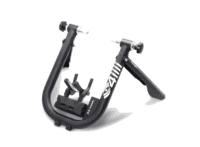 | 4iiii Fliiiight $599 | Amazon | |
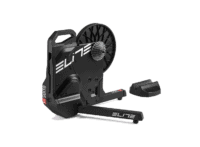 | Elite Suito $799 (incl cassette) | Amazon | Competitive Cyclist |
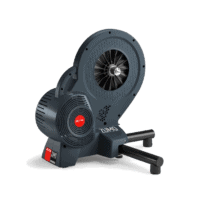 | Elite Zumo $699 | ||
 | Fisher-Price Smart Cycle $89-$299 | Amazon | |
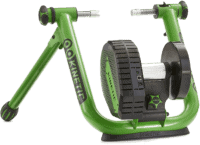 | Kinetic Smart Control 2018 (Road Machine/Rock & Roll) $569 | Amazon | Competitive Cyclist |
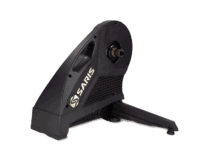 | Saris H3 $1,099 | Amazon | Competitive Cyclist |
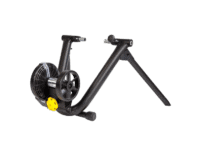 | Saris M2 $499 | Amazon | Competitive Cyclist |
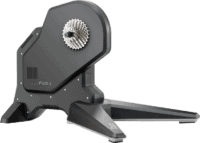 | Tacx Flux S $749USD | Amazon | Competitive Cyclist |
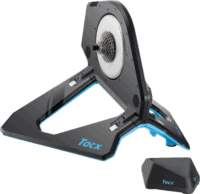 | Tacx NEO 2T Smart $1,399 | Amazon | Competitive Cyclist |
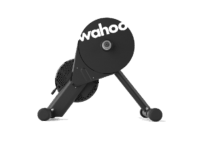 | Wahoo Fitness KICKR CORE $499 | Amazon | Competitive Cyclist |
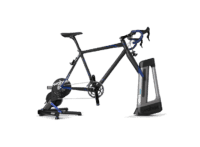 | Wahoo KICKR + CLIMB Bundle | ||
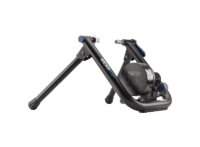 | Wahoo KICKR SNAP (Current edition) $499 | Amazon | Competitive Cyclist |
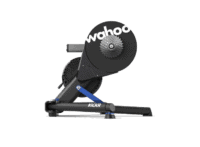 | Wahoo KICKR V4/2018 $1,198 |
Thanks for reading! And feel free to drop any questions below, I’ll be happy to answer them.

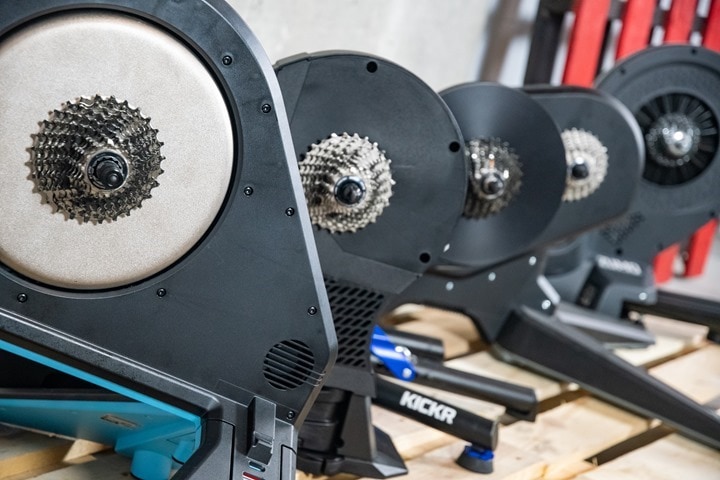
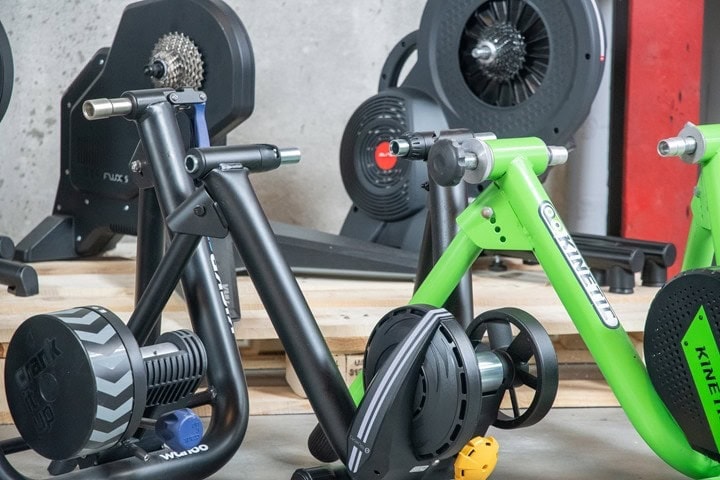
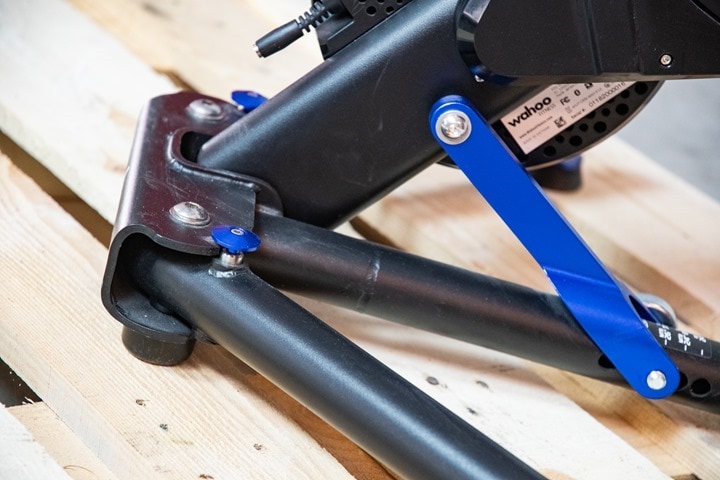
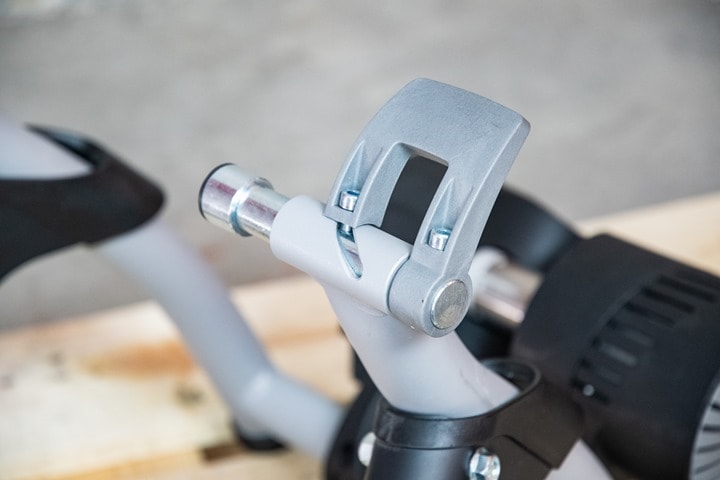
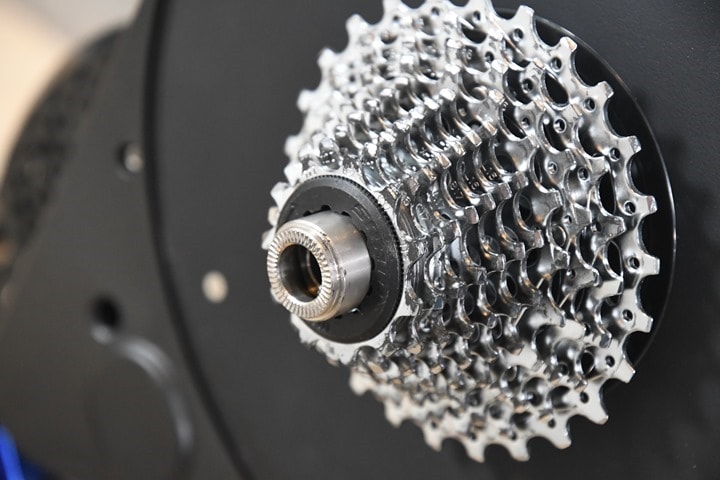
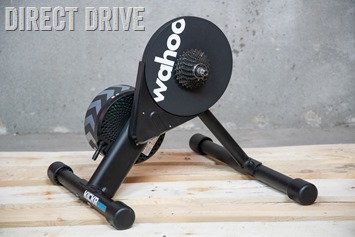
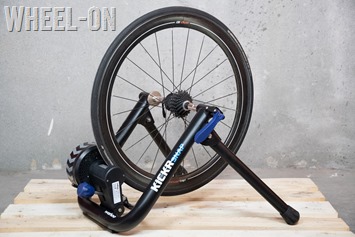
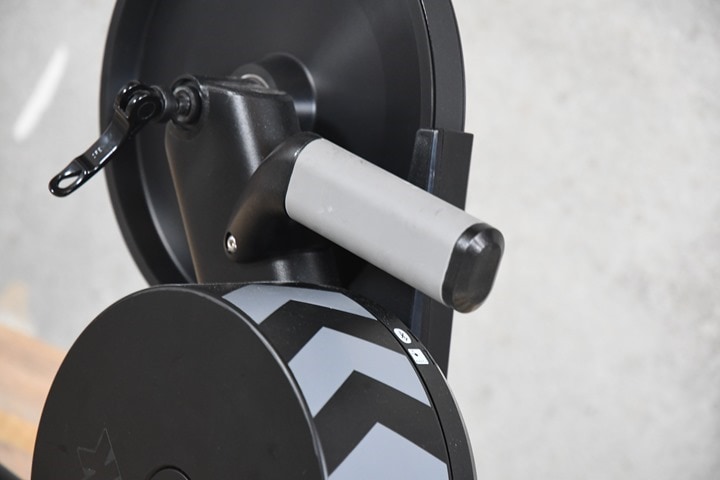
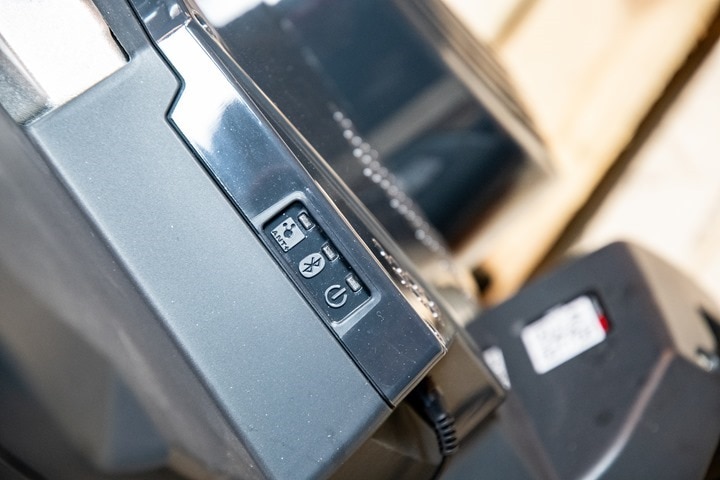
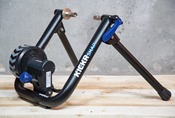
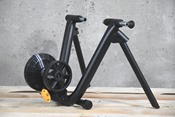
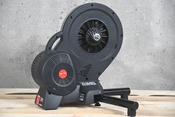
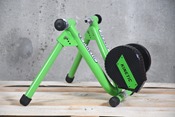
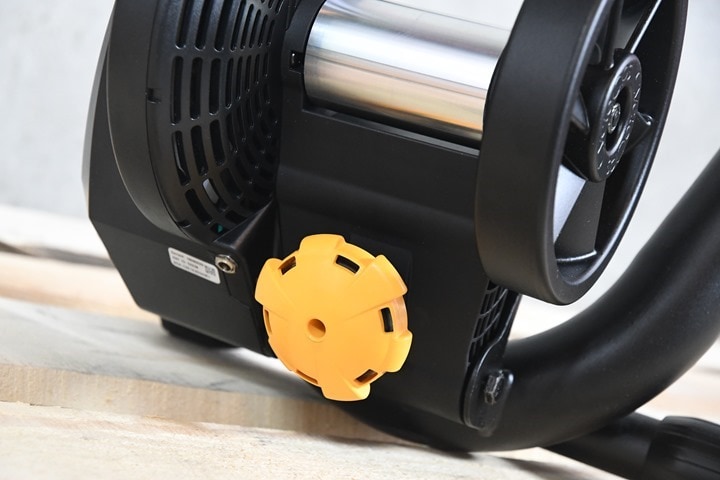
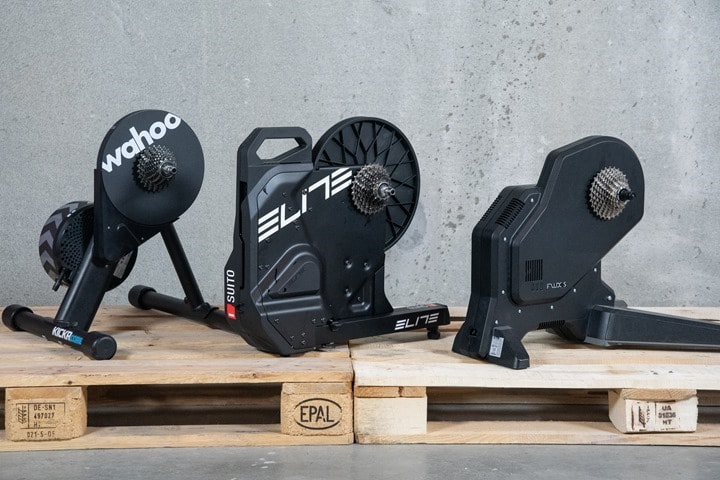
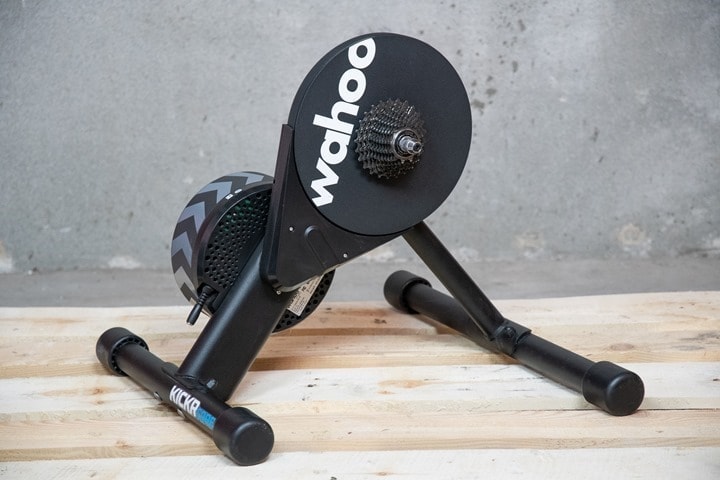
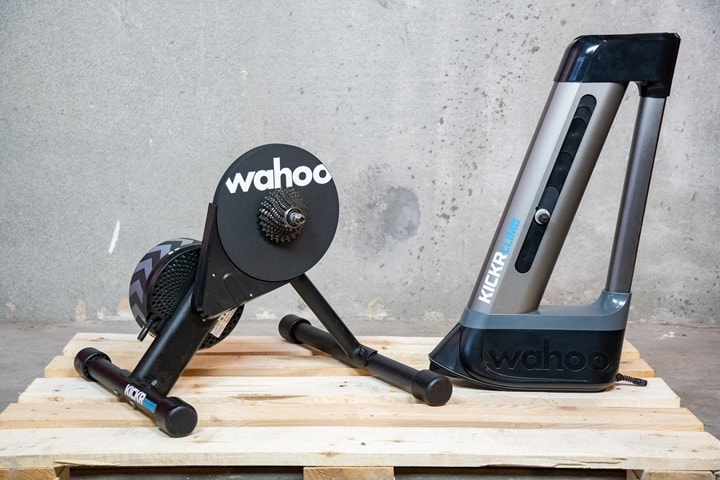
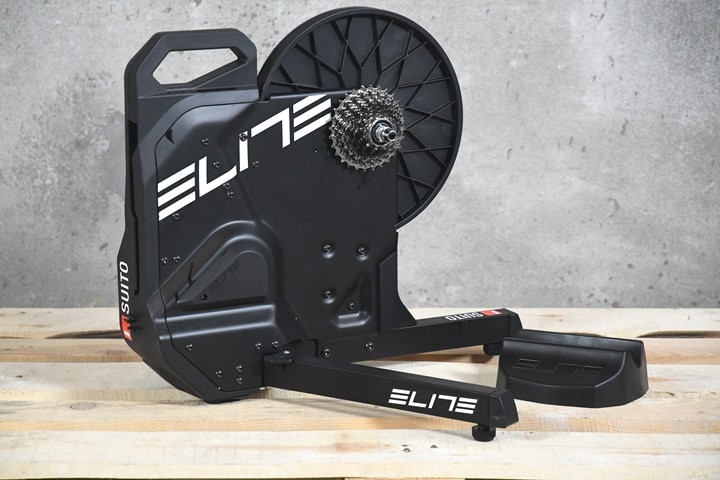
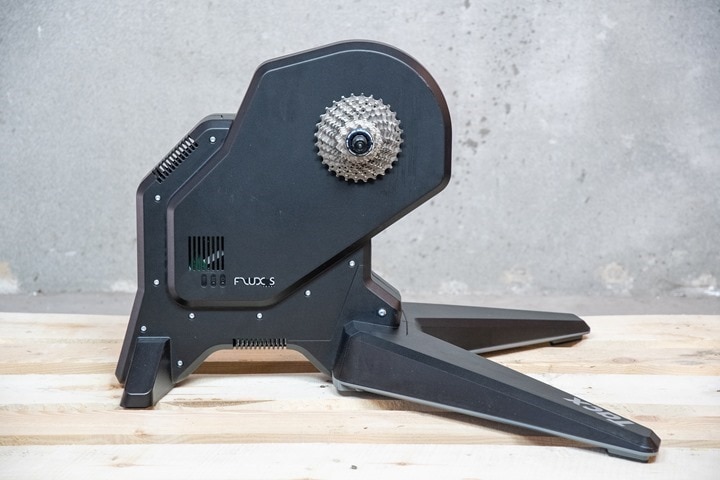
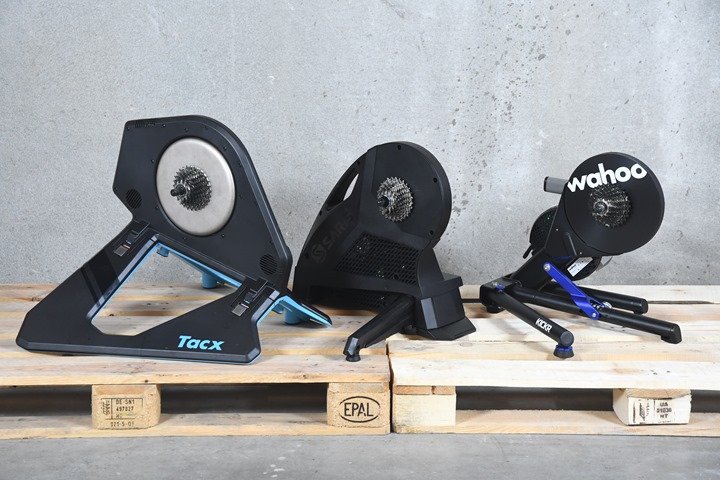
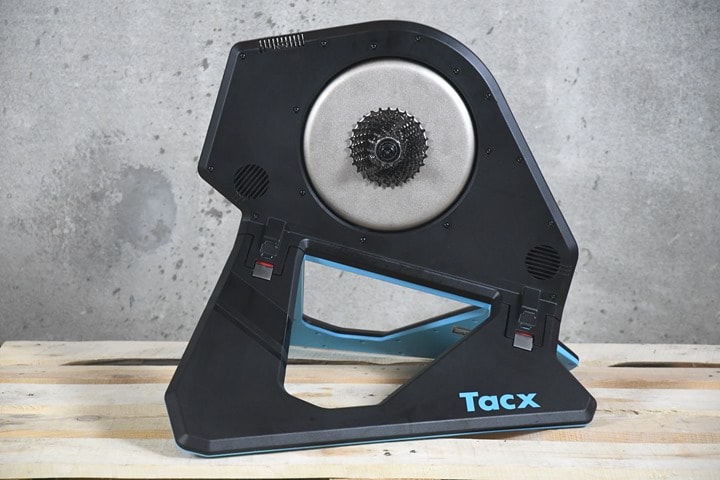
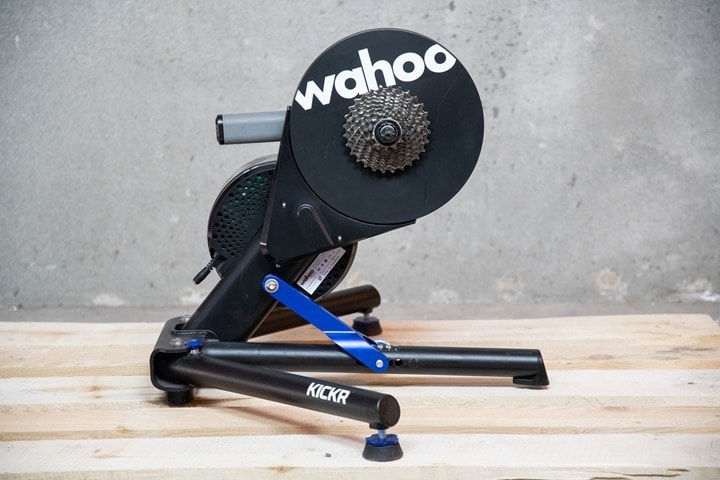
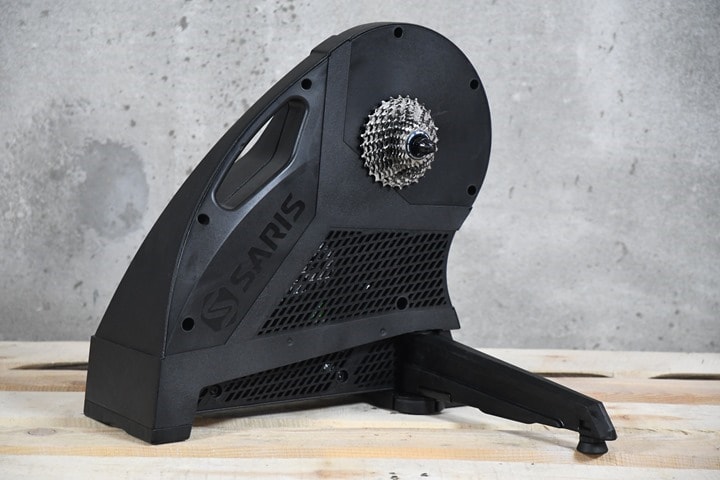
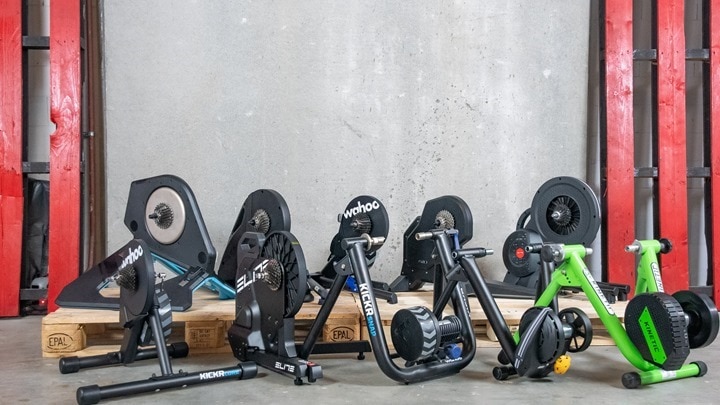











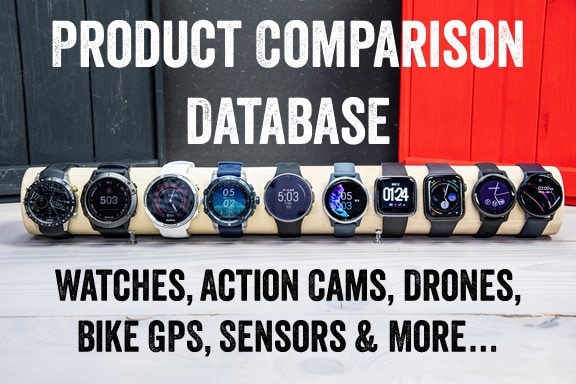
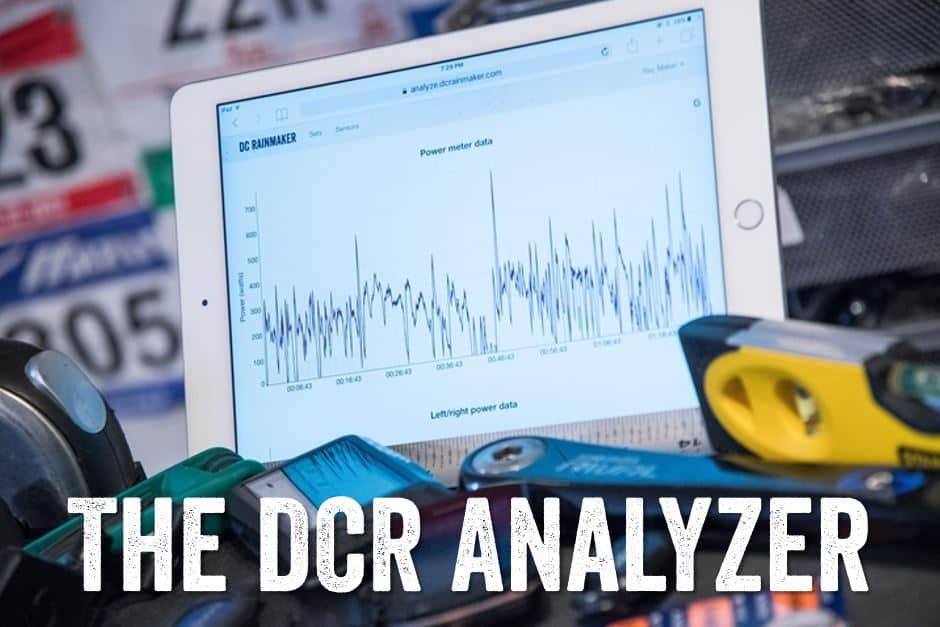


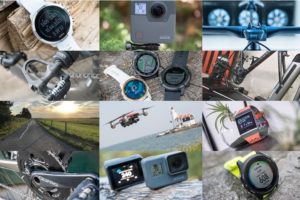




Gotta throw in a nod for an Elite Qubo Smart + mag. It’s not great, but it is $100 cheaper retail than Tacx. It works, it’s not smooth, but it works. Spend the extra money on the Snap or Saris M2, but it works. It uses soviet era tech and does the job, but you’ll return it….
Haha…I generally try and aim slightly better than: ‘Ok, it mostly works, it’s ugly, and it’s not all that accurate, and almost discontinued.” ;)
To be fair, there were a lot of Qubo’s used by the Women’s Pro Teams this year at the Giro Rosa. Though that’s mostly because that’s what Elite sent them. In talking with Elite about it, They’re looking to go into 2020 with basically standardizing most team sponsorships on the Elite Suito.
I pointed out there’s little point in doing ROI type sponsorship’s on older equipment that nobody’s going to buy. The point of doing these sorts of sponsorship’s is to drive awareness of your products you want people to buy. They agree.
Oh, and here’s that post: link to dcrainmaker.com
Thanks the for podcast shoutout!
There is something to be said for it being the very cheapest interactive trainer out there by$100 (street). IMO that something that should be on your list- what’s the cheapest thing that will get the job done – trainer that can Zwift via virtual power, adjustable resistance, and interactive.
We were all starting to worry you’d given up on trainers :)
Just about. This was a rough year in that respect.
I feel like it finally all came together in the last week, with three units (Zumo, Suito, NEO 2T) all getting firmware updates that address blocking issues. If only Kinetic could have joined the party.
“If only Kinetic could have joined the party”
All the empirical evidence is that Software just ain’t in Kinetic’s DNA. From once-great-to-now-bargepole-territory is, consequently, how I view them. Run a mile if offered one.
I saw your comment on the Zumo firmware update which is good news. I have a Zumo and want to confirm if I have the upgrade or not. Can you confirm what the firmware version is for this update? I have version 168 using the Elite Upgrado app. Thanks for all the info!!
I’ll check the exact Zumo firmware version on Monday when back in the office. My understanding from them is that units from roughly July would have had a variant of this firmware baked in (not quite as good, but in the ballpark). So, if your unit was from prior to then, then it won’t have it (good news for you).
All Zumo units except for apparently a few hundred of the first production units last fall (2018) will get this firmware update next week. Whereas that first batch needs a different firmware due to some tweaks they made, so they’re working on that still.
Specifically this firmware version includes the ERG mode fixes as well as the sprint accuracy fixes. As noted above, it still seems to clip the sprints a bit, though, not as bad as before and in the same ballpark as what I see with other trainers at that price point for accuracy.
Thanks! I have a Sept 27 2018 unit based on the date code on the unit. I’ll keep looking for the firmware update from Elite as it sounds like my unit may be one of the early units.
I still get excited to see this post go up every year, even tough I have a pretty good idea how things shake out.
Do we set aside four hours to discuss this in the next FIT File Podcast? I’m sure we can fill that time with trainer talk, if I cut it down a bit after recording. ;)
I – like a lot of readers, I expect – have been monitoring this page almost daily for the last month, so I suspect you won’t need to dedicate a whole podcast to it! I’ve been considering the Neo 2T as my first trainer, so I’d be interested in hearing yours and Ray’s opinions on the firmware updates and if there are any potential hardware issues as a few people have shared (the trainer keeps spinning after ending the session, or the unit locks up).
If I’m gonna fork out a bit of cash, I hope to get something good which will last me for many years.
“if I cut it down a bit after recording.” *lol*
Why only four? Surely you can go longer. I’m sure you both can change diapers while recording.
The FIT file is one of the few podcasts I have set to play back at normal speed rather than accelerated. You guys already talk fast…
It’s turned out to be our longest episode to date! Eeks!
For the record, I can still make my 2T slip, but only when doing it on purpose (as was the case on the 2 for me). I find the 2T to be louder than my Kickr too due to the slight judder of the magnets which makes the unit vibrate, which makes the floor vibrate and make noise. The Kickr I have is truly silent, although I concede I got lucky there as the Kickr core I used to have vibrated like a kangaroo! The slightly gravelly, juddery feel of the Neo magnets, and the way the flywheel operates make me prefer the road feel on the kickr, which is definitely smoother and “rolls” more like a real bike. Definitely nitpicking there though. Finally, I don’t trust the power number on the Kickr as far as I could throw it, but the Neo 2T (and 2 before it) is bang on all day every day. The Kickr adds 30 watts at high sustained outputs. I don’t have the energy to deal with another trainer swap so I’m just going to keep the Kickr and enjoy winning for a change :)
Dang, I can’t make mine even hint at slipping – even as I try and throw down almost 1,000w. Huh.
Granted, there are people that can put out a lot more power than I.
To be fair I weigh 100KG and I was on Alp D’Huez in TDA so loads of resistance. At 45rpm if I suddenly stamp down it slips every time but recovers faster than the 2 did. As I said it’s not realistic usage so I’m not worried by it, but the Kickr doesn’t have the issue since you’re physically turning the wheel. It’s a hard call between the two as you say. I also find the flex of the Kickr to be nicer for sprints for some reason I can’t explain. I have a DCAnalyzer file showing the slips if interested, you can clearly see the Vector losing power as I was messing about and stamping :)
Newbie question. I’m leaning toward the Saris H3 when I purchase my 1st smart trainer in a couple of weeks but have seen on YouTube that the cadence from it can be kind of wonky under certain situations when using TR or Zwift. Since I have a Garmin crank arm cadence sensor on my bike can I pair that with TR or Zwift use the output from that instead of the trainer supplied cadence?
Yes I believe you can, whether you would want to may be determined by which platform you are using to connect to zwift. If using Apple TV you only have the ability to connect two concurrent Bluetooth connections (plus remote) so trainer might take up one and hr strap the other, in this scenario you will miss cadence if you don’t take it from the trainer, which is why trainer companies have started doing this. If you’re using ANT+ though and have no issue with the number of connections the standalone cadence sensor should work better based on Ray and Shane’s findings.
Thanks Pete Parfitt. Initially, I only plan on using my MacBook Air and will be getting an Ant+ dongle and USB extension cord for it. Maybe at a later date I’ll upgrade to an Apple TV & display. But I’m in an area where I don’t have access to broadband internet and will need to check out how data intensive programs like Zwift are to see if my internet connection can handle it without choking. If they can be run at lower resolutions like 480i it can probably handle it.
Just a heads-up regarding the Vortex Smart – you can buy it on sale at Chainreaction in the EU for 250€.
I haven’t received mine yet, but assuming no issues – I’d say that makes it a winner in the low-end category?
Definitely a good deal at that price. I try and do the recommendations for global availability, so it’s tougher with things like that were the pricing and availability of the lower end Tacx units are so wonky globally.
(Which is something I’ve brought up numerous times to Tacx’s management.)
Thank you for this great annual guide.
I just bought an Elite Suito two days ago. This guide confort my choice and I can’t wait to try it.
For me, the compact size and the handle of the Suito are a huge advantage for me living in an apartment. It’s too bad you never mention the total weight of the trainer. It should be usefull to add this into the comparison table in addition to the measures folded and not folded. Some people don’t care about 2% or 3% accuracy but care about transport and size like me.
I have an other interrogation. You live in Europe, like me (Sorry for my English if there are mistakes in my comment). It could be interesting to link Amazon fr, de, it, uk, es because when we live in Europe, it’s easy to order on each of these website and there are often great deals.
It could be awesome too to support https://www.dcrainmaker.com by buying on Clevertraining Europe but you have no partnership. Is there a reason?
Finally, I want to thank you for all your amazing work. I never miss a day visiting your website. Thank you
Hi Cédric-
In theory, it’ll automatically re-direct you to the correct Amazon EU website based on your location. So Amzaon.FR if in France, DE in Germany, and so on. It’s messier for folks like myself in the Netherlands where we tend to do Amazon.de, but sometimes .FR and like yesterday – .co.uk.
As for Clever Training EU/UK, I do have a partnership there. For any trainers that they stock, they’ll show up automatically in the listings. Though right now they seem to be missing some of the new 2019 ones on the UK/EU side. I’ve poked to see what’s up there. And, you’ll save the 10% there too!
Hi, good to know about your partnership on Clevertraining Europe too.
Thank you
Amazon.com never redirect me to correct Amazon Eu store. I can go independently on both of them without beiing redirected
Grr…thanks for the heads up – I’ll look into it. France I presume?
Yes. For example, Elite Suito:
– US: $799.95 (link to amazon.com)
– UK: £642.99 (link to amazon.co.uk)
– FR: Unknown (link to amazon.fr)
– ES: Not available (link to amazon.es)
– IT: Unknown (link to amazon.it)
– DE: Unknown (link to amazon.de)
Amazon websites URL are nice because we just need to replace the extension from the domain by those from the country and we know if the product exist.
Regarding the mid-range choices – is the Elite Zumo really a thing? I had the impression that it was quietly forgotten? From what I can tell, it’s not possible to buy one and Elite don’t show it on their website?
Thus, you’re left with the Snap (or a discounted Tacx if you can get it).
What makes this segment interesting, is what happens with the 4iiii and Tuo. But I guess it’ll be a few months before that situation is clear…
Yeah, it’s finally a thing…again. I’ll cover a bit of the history in my in-depth review. Heck, I even have almost the entire thing written from last fall. Gotta go digging!
It’s a weird one in terms of distribution though. Only certain retailers are carrying it due to profit margins. Though, I agree it should at least show up on their website. I’ll ask why.
A webshop here in the Netherlands (Mantel) is offering the Flux 1 for 489 euros. About the same price as a Kickr Snap. I’ve been trying to compare the two, but as the flux is a relatively old model it’s quite hard to get a good idea of how they stack up in terms of feel and reliability.
What would you reccommend?
I’d go Flux 1 over KICKR SNAP easily.
One of my favorite posts of the year! On the point about dealing with customer service and remembering the costs of shipping, where is Tacx these days? I suppose I mean that literally. Like, I know that Tacx itself is still European, but are they still European within the Garmin universe? If you have a problem with a Tacx trainer, do you have to send it to the Netherlands or Kansas?
Tacx support is being ingested into Garmin right now. I know this as I’ve just used them and had some comms issues. The team are on the Facebook group though and active on Twitter so not a problem. I had to send units to Netherlands which is a pain but they cover shipping costs and arrange everything. Overall support ended up being good for me :)
Yup, Dave nailed it. The support integration between the two has quietly been getting better by the day. I think the biggest benefit is probably for non-EU people to be honest.
My understanding is at this point if you’re in the US you can simply call Garmin support and they have dedicated trainer folks there handling it now.
Awesome Ray! Very helpful. Now – any thoughts to updating the trainer app post for 2019? Thanks!
Yeah, it’s on the November list. For realzy this time.
I was waiting for this review, thank you for this!
I’m in for the midmarket segment and the Suito looks really a good option. Certainly from a price point of view.
But on the other hand, if you look at the comments on your review page of this trainer, there are still a lot of complaints going on. This is really holding me of for the moment.
Luc
Luc, don’t forget that people rarely post when they are happy!
I have beenusing tacx neo for two years (3 or 4 x week) without any issue and I am very happy with the progress I made using a home trainer + trainer road combo!
Yeah, I think a lot of the earlier comments were on-point. I had actually in September at note at the top of the post saying beware.
I think at this point the early manufacturing teething issues (which were basically units made in July) are gone (or, in someone’s hands), and now things have been refined a bit. Unfortunately like most companies…
I don’t see that at all, I see on instagram that most shops have been just receiving stock of the suito, started shipping, units arrived in the last week pretty much, and the complaints about the suito are higher than ever before, as stock has being increasing a lot, availability still not in peak, but certainly many more units available, and many more complaints online here on this website, on youtube, on zwift forums. Not sure how this unit is recommended specially when it just arrived now, and everyone and their brother too, is having problems with it, bot physical problems with noises, watts very imprecise, erg issues, etc…
Units arrived in the US the last week of August, and into Europe the next week. People have been using units since then.
And again, the firmware fixing the accuracy issues were noted above (which includes ERG mode). Further, the physical issues were noted as well – and I think we’re largely past those, and those seemed to be from units shipped back in August that arrived to people early September. It’s now almost November.
Again, timeframes matter, and understanding distributions and shipping timeframes matters.
are you planning on updating the 2T first look with your findings from the latest firmware. I’ve been holding off until now. Seems to have taken much longer than Tacx initially promised.
Would like to know about the pedal stroke analysis thing too ….. need more data in my life. My experience of Tacx over the years is that they promise lots of things but are slow to deliver and buggy. Firm/Software hasn’t always their strong point – meaning the acquisition by Garmin was a match made in heaven :)
It’ll be just straight into a full in-depth review for it. So I’ll have near-term:
1) NEO 2T In-Depth Review
2) Elite Zumo In-Depth Review
3) Elite Suito In-Depth Review
I want 1-2 more rides on each of them with the latest firmware, despite the gazillions of rides on previous firmwares. But the two ‘core’ rides I do on every trainer (Zwift Titans’ Groove route and TrainerRoad 30×30 ERG workout) are done on all those and they passed.
Looking forward to the two Elite reviews, they are available at reasonable prices in the UK at the moment, particularly the Zumo.
Very reasonable, I just picked up a Zumo from Halfords for £405 (£450 -10% for AA members). I have a Neo as my main trainer. This is to replace mu Tacx Flow that I have at home, clearly it won’t be as good as the Neo but it should be much better than the flow and at that price I reckon a bit of a bargain.
With British Cycling discount the Zumo is £405, the Direto £495 and the Suito is £585 (but has a cassette obviously). Decisions. Decisions. Need to wait for final reviews I feel.
So the Neo 2T power accuracy issue that you posted in the hands-on review is resolved on final firmware?
Yes.
I bought a Zumo at the weekend – with British Cycling discount it is currently £386 from Halfords. I was attracted to the Zumo due to price and the “Power Meter Link” function. I have tried it both with and without tmy Quarq power meter linked but so far it is unusable. In Zwift the power readings it supplies are close to my Quarq, but unfortunately the resistance is set to (or stuck at) max and I can barely turn the cranks (400 watts in my lowest gear for a cadence of 45 rpm). The MyETraining app would not run without workarounds as MacOS Catalina treats it as untrusted software. The IOS version appears to be buggy and so far support from Elite has been poor to non existent. When I get home tonight I will try the firmware update tool mentioned above but if that does not make it usable I will return it for a full refund.
I’d start by turning off the power link. In my testing, the accuracy is good enough you don’t need it.
Next, do a calibration by the Elite app on iOS – I haven’t had any issues there (never tried the MacOS version). Or, use Zwift to do the calibration if you want. I’ve found calibration is important for Zumo.
The wattage stuck though sounds an awful lot like another app/device is controlling it. Any chance you have the app loaded on your phone and connected to it?
Thanks for the response. Ill try the calibration with the iOS app when I get home but my understanding is that the trainer needs to be used for t least 10 minutes prior to doing the calibrartion and I simply not capable of pushing 400watts for that long (let alone at a cadence of 45rpm)…
I have seen a post on the Zwift forums from people experiencing similar issues after owning the Zumo for a while and it going wrong after performing a ‘spin down’ calibration. The solution was to exchange the device on Elite’s advice so perhaps the firmware is buggy, see:
link to forums.zwift.com
Interesting, it’s actually somewhat similiar to an issue I saw this weekend from Zwift and the Zumo, except mine auto-resolved itself the next time Zwift sent the next workout segment command. Check out my post on it: link to dcrainmaker.com
I checked the firmware and according to the Elite Upgrade App it is apparently up to date. I have turned off “Power Meter Link” asn used my Gramin to view the power+cadence from the Quarq while Zwift was configured to show the readings from the Elite Zumo.
I managed to calibrate the trainer from Zwift and it is slightly better; I can now “spin” in the lowest gear 34-28 at 100 RPM for 200 watts. The ride feel is like pedalling through glue though and my old Tacx Flow (wheel on, basic/dumb trainer) feels 100 times better.
I noticed that the cadence reported by the turbo is hopelessly inaccurate, the Garmin showed 95-100rpm and the turbo was reporting around 75rpm.
I also noticed that the power reported by the turbo lags the power reported by the Quarq by quite some margin (approx 5 – 10 seconds).
I tried the iOS app which allows manual power adjustment and it does adjust, but the lowest setting is still way too high. On the road I would normally use the 50-17 gear combination for 200 watts at about 95rpm, the 34-28 combination is only needed for steeper hills…
I can only assume that there is an internal issue with the trainer. I’ll see what Elite say if they respond and report back.
Thanks for your help.
Ray:
As always, an excellent review. Given your recent posts on the Tacx and Wahoo Smart Bikes, do you think that a smart bike is that much better than the high end smart trainers to justify the cost differentia? I am not talking about cost savings for someone whom the actual cost is a factor, let actual cost not be a factor, rather are smart bikes actually that much better than high end smart trainers to warrant their price?
The more I use all these bikes, the less optimistic I get on spending money in 2019 on these bikes. I just don’t think on the whole they’re super polished yet. At least not to the price point noted.
However, I’ll tackle that all next week in the shoot-out.
THANK YOU very much for your honest, as always, appraisal. It is your honesty and integrity that makes your website so very valuable. THANK YOU again.
Hi Ray,
That is interesting statement :-). I mean… I have recently placed probably my fourth order of NeoBike (not that I ever got any delivered, but orders were cancelled – and now it seems not to be as promising once again). But at the sametime I do not know if it is a right decision. The biggest plus I see with the Smart Bike is the multiuser capability. At the moment we have Neo2 and some sort of compromise older bike mounted on it to allow me and my wife ride it; idea with the NeoBike was that it would be much more adjustable for either of us to get closer to “perfect fit”. So is your comment more about “it works as it should, but one could expect a bit more features for this money” or “it is not worth the money, because what they promised is not 100% delivered”?
Cheers
Marek
Hi Ray!
Thanks for the wonderful post! I’ve been planning on getting a trainer (probably a Kickr Core) for a while now. Can we expect the CleverTraining VIP 20% discount anytime soon?
The annual fall VIP 20% sale is planned for mid-November. Stay tuned!
Will that be clever training US only, or EU as well what with MSRP etc in Europe being different
Awesome! Thanks for the reassurance!
Ray, does the 20% sale include Garmin/Tacx and Wahoo, or are those excluded the same as they are with the normal VIP discount?
Historically they’ve been included in the sale.
As always, thanks for the info!
I just purchased a refurbished KICKR Core directly from Wahoo. (I have yet to use it as I am waiting on the cassette to arrive).
Based on your comments above do you think it’s a good purchase and that the “issues” you spoke about went away in the refurbished process?
Thanks
I’m undecided on that specific example (the refurb units from them). In fact, I e-mailed them yesterday to ask exactly what the process is for those units.
For example, if I look at Garmin’s refurb units, I understand end to end what happens to those units. They all go back to Taiwan to Garmin’s original factory and get entirely overhauled and put back through the same exact tests as any new unit – with any parts replaced as required. I have zero issues with buying a refurb Garmin units.
However, I don’t (yet) understand the Wahoo process. Are they sending them all back to Thailand/China/Vietnam to the same factory to get re-worked to eliminate any issues? Or is there just a warehouse somewhere near Atlanta with a bunch of interns there fixing them? Which isn’t a problem per se, I just don’t understand it. Yet.
My comment above was specifically targeted though at picking up a random unit off of eBay or Craigslist, or even your friend Billy. Never trust Billy.
I purchased one of them too. Still in the box though! IT would be interesting too see what their process is. But as they carry an “as new” warranty I am not too concerned. Wahoo seems to be one of those companies that strive to make it right for their customer.
Interesting about the Garmin refurbishing process. Do you know if the watches go through the same refurbishment as well?
If physio true up was working for my F3HR, I would have kept it, but am thinking about an F5 or F6, after i situate myself for the trainer.
I’ve been using a refurbed Kickr Core from Wahoo for 3 weeks or so coming off of their random sale they had. (Before I saw Ray’s comments on TR forum about not purchasing them) Tough to beat $630 shipped. I’ve had no problems other than having to restart it a couple of times and some powermatch issues with my L stages and Trainerroad which TR said is a known issue. So impressed with ERG mode! I was on old school rollers with a towel before the core;). Thanks again Ray for all your work…I chose the Core based on your recs.
Will I had the same feelings about ERG coming from a non-smart trainer. Its amazing. I purchased a Core right when they came on sale last year, went through 2 replacements, and finally have one that has lasted ~3000 miles without a single issue. I am optimistic that Wahoo finally figured out what was causing the issues with them (of course it probably just broke after typing that last sentence).
Rob, Hopefully my unit is like your current one with 3k on it!
RE: Garmin refurbs-
They go back to Taiwan – everything does. Even if someone just returned it because they didn’t want it or decided the color wasn’t for them. Everything goes back to Garmin’s own factories there (a rarity) and back through the assembly line.
RE: Wahoo refurbs
I’m still waiting clarification on that. They said they were going to get it by end of day yesterday, but I haven’t seen it yet.
Awesome to know. Thanks Ray! I may actually look for a refurb F5 after all.
Hi Gary,
Tyler from Wahoo here just to add a bit more information on your purchase. The unit you purchased is a refurbished KICKR Power Trainer that carries a full 1 year warranty. Our team of KICKR support technicians go through a 47 point comprehensive checklist to ensure that the KICKR meets our factory specification. Each KICKR goes through complete functionality testing, genuine replacement parts, final quality inspection and certification, brand new box with accessories and cables. Cosmetically, there might be some scratches or nicks.
Thanks,
Wahoo Tyler
Hello Wahoo Tyler,
I am curious if your checklist contains performing a spin down with a bike and listen for grinding noises?
In this thread there are 2 customers with grinding KICKR Core now counting 4 units. I wonder how this can happen.
Best regards,
Cypher
Hi Tyler,
have a look at my feedback on Core trainer review: link to dcrainmaker.com and today’s update here: link to dcrainmaker.com
I wonder how this matches the process you describe.
Best,
Oliver
I like that the Tacx Neo has a slight side to side movement. Sure not a rocker, but enough give to take the edge off. I am a sub 1000W rider so I have never been able to get my Tacx Neo 2 to slip. AFAIK the Tacx Neo is the only direct drive trainer without a belt or chain to drive the flywheel.
If buying a trainer with an included 11 sp cassette, can the cassette be replaced with a 10 sp cassette with a spacer, typically like most 11 sp freehubs?
Yup, all these trainers are designed for 9/10/11 speed cassettes. So you can just swap it out as you see fit.
I’m finding it hard to decide between the Flux S and the Suito. I don’t need to pack the trainer away and don’t think I can justify the extra cost for the Kickr Core.
I just went back to check out the accuracy details of the Flux S and compared them to Suito, very similiar. I think there might be some slight advantages to the Suito in accuracy, but incredibly slight if that at all.
I’d say the main advantages of Suito are portability, not having to buy a cassette, and sound (it’s quieter). Inversely, the Flux S is a bit more beastly of a base, so it’ll be slightly more stable.
If the Flux S is possibly more stable that might be they one as I’m a bigger rider. Seeing the price of the Elite Direto below, that’s also tempting.
I have an H1 + Power Pedals
I don’t see anything “new” that would beat that combination so I will stay put until next iteration :)
Saris Hammer H3 not in the final list?
I mean this in the nicest possible way, but you might want to read the post. It’s there.
Elite Direto OTS 2 £550 in the UK at Halfords, extra 10% discount for British Cycling members. I have no affiliation, just looks like a decent deal
link to halfords.com
Interestingly was in Halfords at the weekend and they had a shelf sticker saying that the Suito was the same price but didn’t appear to have any on show. Interested which would be better at the same price, my guess the Suito, but my guess is also that it was marked up in error.
Regarding your statement about Strava in the section about “Technical Considerations” (regarding how to record the signal), Given that Strava is removing their capability of recording ANT+/BT, you should probably remove it from the recording options.
Good catch, thanks!
(Though, I guess we’ve got three days left).
Hey guys, stop doing out of the saddle sprints on the trainer. The main reason people are getting hardware issues is they are pushing the units too hard. Avoid Zwift races or just sit up when it comes crunch time.
I don’t follow?
Not a single trainer company has *ever* said that’s an issue (out of saddle sprints). Nor has a single trainer company *ever* said that’s causing hardware issues.
I guess Stac has more Halcyon trainers. But the at the current price, is a hard sell. Other than the longer battery life, I dont see any advantage over the new version of it which will have a lower price, plus no need for weights.
Hi, I need a recommendation from somebody who has tried some smart trainers. Brands advertise their products with a lot of data and most of them are useless features for me. I don’t need 2500 W power output, I don’t need power meter – I use my crank power meter outside and want to use it indoor to have the same device to measure my power. I want to buy a mid-high end trainer and I’m only focus on very good ERG mode and road feel as well as it can’t be noisy. Core, Suito, Flux S, Direto X, should I consider anything else? which one to choose? Thank you in advance for any advice that meet my needs.
Realistically if you want the quietest of that group, it’s CORE. But practically the others are pretty quiet, with the Suito probably being the quieter of the remainder of that group.
Thank you Ray for your recommendation. Great article as always. One more thing, I’ve heard that road feel is the best on Core – the biggest fly wheel – and you say the quietest one, so should be the best from this range I’m interested in. I’m from Europe and Elite trainers are cheeper for me, so maybe I go for them. You say that Suito is very quiet, but are road feel and ERG mode on the level of Direto X or Tacx Flux? Thanks again.
Been waiting for this! :D Just ordered a new Flux (1) for just below 570 US. As the S was just minor updates that i didn’t need.
Thanks for a great article as always!
Is there an outcome on the Flux 2 Erg mode issues and the promised firmware fix? I know you mentioned in the article that they quietly changed the hardware/model but what about those who bought before that. And how do we know if we have an old or new!
I have always felt there was an issue with mine but without a separate power meter I’m just comparing feel on a TrainerRoad workout from when I had a Flux 1 (returned on warranty, but that’s another story) and I can notice a difference in perceived effort.
I’m a bit fuzzy on that exact piece. I’ll try and get to the bottom of it. Internally and to some retailers it’s roughly known as the Flux 2.1, but I don’t know if there’s a specific different SKU on it.
I know they were getting about half-way there on fixes with software, but I think some of it required new hardware due to a substantial change in how much power it can provide resistance for at specific speeds.
Thanks Ray, that would be very much appreciated.
I’m losing confidence in Tacx, but loathed to return it as I got a bargain price. Just want the confidence that I have a multiple hundred dollar trainer that actually works and is accurate. Too high expectations maybe? ;)
sonehow I missed this part? what’s ex exactly the issue? I do have the feeling my flux 2 reports lower wattage than my vectors…how can we verify or test this?
In short, the Flux 2 in ERG mode was way off – like 10-20% off. Horribly bad.
Oh. Not good. I was wondering already…i guess this is something for the support then…
In the budget/cycling as a secondary sport category, do you have any recommendations on what prior trainers have held up over the years?
Essentially, what trainers to look for used?
For me, I like the idea of a direct drive trainer but struggle to justify the cost when precision and isn’t necessary (and it will only be used a few times per month).
I’d have no issues picking up a KICKR 2017 for cheap – that’s aged really well. Same goes for a new-in-box Flux 1 (but I’d be hesitant on a used Flux 1 due to early teething pains). The Direto series (original and otherwise) has also aged super well.
Thanks Ray for the great article. For the moment it is possible in Belgium to buy the Elite Direto X for only 70€ more then the Suito. Does that make the Direto X a better buy ? Tx
It’s a mix. The Suito actually has faster ERG mode responsiveness than the Direto or Direto X, oddly enough. Though, the Direto/Direto X has the internal power meter and in this case has very strong accuracy (and has for years).
With the Direto/Direto X remember you’ll still need to pickup that cassette and tools if you don’t have it. Meanwhile, it seems to be past any teething issues – so you’re unlikely to run into that.
Great guide as always, thank Ray.
I’m waiting until the Clever sale starts in a couple of weeks. Have been leaning towards the Saris H3. This will be my 1st smart trainer. I’m guessing TR will be my choice since I’m looking at something to help me increase my fitness (within the limits of age) and am not really into the gaming culture. It appears to be a good bet for TR. Still, the Neo is temping with all of its features and not having calibrate it.
Hi Jim, If you are looking at the H3, Cyclops and Sirius are selling off H2 at the minute for 50-60% of the price of the H3. Or cheaper than a kickr core.
If your not bothered too much about sprint accuracy I’d recommend that.
Fwiw – both the H1 & H2 actually received a firmware update back in August that fixed (finally) the sprint accuracy issues.
So more or less it just comes down to noise.
Tom. Thanks. I’ve considered that but from all the reviews I’ve read the H3 really cuts the noise down almost to the Kickr/Neo levels. I think I’d rather pay the extra for the H3 since for whatever reason I’m somewhat noise sensitive. If I can pick one up for 20% off in a couple of weeks it isn’t a huge amount of money over the H1 & H2 and something I’m willing to pay for. But I appreciate your suggestion.
Thanks again Ray! If I didn’t pick up a Core last year, I think the Suito would be at the top of my list for the handle alone – moving the Core is actually a huge pain in the butt! I just had my Core swapped by Wahoo for a new unit due to a very loud low RPM squeek that developed late last winter and got a lot worse once I started putting in watts. I must say that despite the issues the original Kick Cores had, Wahoo’s customer service is fantastic. They also happily sent me new chevrons last year when I blasted them off the flywheel into the stratosphere!
Your measuring cup idea phone holder just saved me from an expensive trainer table purchase; genius!
After more than a decade, I finally managed to break that measuring cup two weeks ago actually. I just pushed too hard without thinking, and snapped it right off. Still, that’s an impressive duration to last!
Will the fliiiight be available in Europe/ The Netherlands, can’t find it in pre-order. As I will be using it in an apartment, no sound, no vibrations will be nice.
My understanding is that it’s supposed to be, but timelines are all fuzzy.
I own a tacx vortex smart, I want to upgrade, and I was waiting for this post and for the suito final review. The kickr core is the other option. Now, what strucks me is that the internet is full of unhappy people who ordered the suito, and this has a ton of problems. It pretty much just started shipping really, and there is a new video of a faulty suito each day on youtube, each day, same with the comments here in the suito hands-on article. i´m not sure who this device is recommended, when it’s such a huge gamble, not still reviewed, the new firmware was released pretty much yesterday, and there are so many hardware issues that no firmware will fix. I also read that Elite does not cover any misaligned flywheel, they say it’s a feature!!!
I don’t know man… The Kickr core has fixed the static electricity issue for real. I read some people is in their third unit and still with problems… very weird market, seems still inmature and makes me want to stick with the vortex smart until the suito is reliable, or the Suito X is released.
Funny thing is that, even yourself write “I sure as hell wouldn’t touch any used 2018 Wahoo trainers though, god no”… Well, those trainer were actually highly recommended last year, therefore, you nailed it, yes, why anyone follow any of these recommendations???
So in the 2020 guide you will write “The new Suito X is wonderful, hit all the right spots, not like the awful and faulty 2019 regular suito, that had issues left and right… ” when the suito is recommended in 2019.
Frustrating market, and even more frustrating the media working on this field.
I’ve written multiple times on the rough but changing landscape of 2019 trainers. I’ve talked about it repeatedly in the podcast too. It is what it is.
But, timeframes are also important. I’ve had the Suito firmware for near 10 days now. Firmware is a very black and white thing, either it works or it doesn’t. Waiting another 10 days doesn’t change that. Also, I’ve had the Suito since July – so again, adding another day doesn’t change that.
Meanwhile, the firmware was only published out to the public on Wednesday afternoon. And it seems most people don’t even realize it yet. So I’m not sure where you’re seeing all these reviews about that.
As for not touching the KICKR 2018 trainers that are used off people you don’t know, you’re not realizing the most important reason for that advice: Wahoo requires original proof of purchase for service. If you don’t have that, you’re SOL. Further, we’re not at 13 months since shipping those trainers, so depending on the warranty, you’re even more hosed if you’re out of the warranty period and not the original owners.
You can twist what you want, but there’s no perfect answer here.
I repeat it again, as it seems not clear to you yet, or you try to ignore the obvious; the suito has proven to be not a bad trainer, but a big piece of shit so far, which is much worse. It’s a big piece of junk. Reported on every corner of the internet. Wobling flywheels, knocking sound, no firmware related at all, much worse problems.
So my question is, my concern, what I notice weirdest is; why do you recommend such crap? perhaps because you were lucky and your unit is not broken yet?
Because with such
Because with such level of measuring things, why would anyone bother to follow any recommendation for a thing that just came to market and so far it’s being called crap by every one who got it.
I think this all answers itself, no need to waste more time really.
So which is it? Your previous comment said there were tons of firmware issues and now you say never firmware issues?
I’m not sure what your angle is, but given you don’t have a unit it basically just sounds like you’re here to stir the pot.
As always, the recommendations are based on my actual testing as well as looking at trends from all the comments I see – not based on cherry picking opinions from corners of the internet to meet a narrative.
It sounds like somehow despite never using a Suito, it’s really offended you. In which case – there’s plenty of other trainers out there to pick from for you. Not sure why you want to get so nasty about it.
I don’t know what is your interest on such denyal, but anyways here you go, your recommended trainer:
link to youtube.com
link to youtube.com
link to youtube.com
link to youtube.com
link to youtube.com
link to youtube.com
link to youtube.com
link to youtube.com
link to youtube.com
There you go, your recommended trainer. And keep denying.
All these videos uploaded the last week. And wait until more suitos are delivered. But yeah, keep denying brother, keep denying. Way to go for sure, denial.
Nice, I’ll see what Elite has to say on the knocking sound shown in those videos.
And that’s just the knocking sound and wobbling flywheel, the ERG issues and other kind of errors can’t be recorded via video so easily and directly, owner should talk and explain it, people don’t like to do that on youtube, but it’s also reported and documented. The amount of comments about these issues is endless. I mean, read your own website comments for the Suito hands-on article.
The questions I would ask Elite are;
– Did you sell any Suito that is not broken?
– If yes, how many, apart from the version for reviews? 0.5% are working? maybe 2% are not crap?
– Do you plan on continue selling such crap?
– If yes, for how long do you plan on selling such crap?
– Until when?
Okey doke…and, after your private e-mail telling me to “[expletive] off”, we’re done here.
I don’t know what Elite apparently did to you, or why you’re so upset about a trainer you don’t have, or what I apparently did to you, but eventually you cross the line. And tonight you found that line. There’s plenty of other sites on the internet you can browse. Folks can have all the disagreements with me they want to in the comments section as long as its civil. You flirted with that today above numerous times, despite that, I let you continue posting. Now, that’s the end of it.
As for the actual issue – I’m happy to raise it with Elite for the benefit of others, and will certainly circle back. But again, it doesn’t seem like you want a resolution there, or the actual data. It just seems like your angry.
Ray, no clue how you manage to stay so calm and collected. Cheers for you and keep up the good work.
With regards to the point he is trying to make: Interested in what Suito has to say, since I’m eying on a Suito in the near future too.
+1
Ray, very cool and professionally responsive
Hi,
What would be interesting is how many people have a smart trainer and a power meter. Because I can´t imagine I´m the only one who got so many problems with smart trainers and accuracy. My take on this is, that most people that have a smart trainer, don´t have a power meter and because of this the accuracy is not known.
I had an Tacx Genius replaced 3 times (because of massive accuracy problems) and the third one was even dead on arrival :(
I then changed to the Wahoo Kickr Snap. This one is super accurate (according to my power meter), but has developed a strong vibrate problem after some weeks. The first replacement I got, was super quite, but also super inaccurate (100W avg after 10 min and the trainer said it was 120W).
And yes I always used the trainer for at least 10 min and then did a spindown. But this did not help on the 2nd Snap and also seems not needed on my 1st Snap.
I have a Snap (1st version…I bought soon after it came out) and P1 pedals. I use the pedals to control the trainer via the setup in the apps (I use BKool and Rouvy; Zwift can do this also). I think I have spun down once in the last 2-3 years. When Ant+ FE-C came out, and I use, I could no longer connect to the Snap via BT from my Android phone. I have to disconnect FE-C and then I can usually connect. What a PITA. So I do not bother.
My numbers seem fairly repeatable using repeated routes and comparing the AVG PWR and Normalized PWR. The few times I have let the trainer control the resistance the P1 vs Snap are usually within 2-3 watts on AVG out of 160-180 watts and a 45-60 minute ride. Close enough for me. I do not race or otherwise compete. I am looking for increased fitness/strength over time.
Hey Ray –
I know you mentioned to be wary of sued KICKRs. Would you say the same for a used TACX Neo? I believe the one I am looking at is over a year since purchase (so out of warranty) and has been well cared for and lightly ridden. I am looking at possibly picking it up for less than a new KICKR Core.
Thanks for all your detailed reviews and sharing your expertise.
Sorry….”used KICKRs”
Zero concerns about a used NEO. For the most part, looking at historical issues for NEO’s, anything that you’d find, you’d find on like Day 0 usage. Almost all NEO issues (or for that matter, really all Tacx hardware issues) have been QA related, and almost always discovered if not the very first ride, than within a few rides.
So if you go to pickup a unit and can at least put your bike on for 30 seconds and it doesn’t sound like its dying, then you’re good.
Thanks Ray!
Thanks for the review.
I am getting ready to purchase my first trainer. Looking for Tacx – high end.
Am I better in purchasing the Neo2T and deal with bugs that need fixing or the Neo2 (older but bugs, hopefully, figured out)? For service/replacement purchase it from Garmin or from local bike store?
Garmin will support it either way.
As for the NEO 2T vs NEO 2, I’d say if you can get a good deal on the NEO 2, go for it. The 2T takes care of that tire slip issues, but years of people never cared/noticed it. Some did, but most didn’t.
Just my two cents.
Just ordered a suito today.
Let’s see in the next week’s how this unit is.
Just 600€ for a suito with an ant+ dongle was a good deal to take the risk and test it.
L
Hopefully it’s all good! If not, like Wahoo and Tacx, Elite sounds like their customer service moves pretty quickly to iron things out.
I think that’s the issue we’re seeing in 2019: There’s no perfect answer here. Every trainer and trainer company seems to have rushed this year or last year. Making it all that much more important to purchase from a company that has good customer service, and via a retailer/shop/whatever that does as well.
Luc, how’d this order go? Any issues with your Suito? I’m also eyeing this
I got a recertified Kickr when it was on sale for $629 last week. First one they sent me had a scraping noise. Replacement seems to be working well, but maybe I’ll regret not waiting the extra week to see your annual recommendations including “sure as hell wouldn’t buy a used KICKR CORE/2018 off of anybody”. Oh well, at least I have a 1 year warranty.
Reconditioned Kickr Core*
Yeah, my specific concern there is purchasing from someone that you don’t know and that voids the warranty.
While I’m lukewarm at best right now (until I understand more) on purchasing reconditioned units that were obviously previously broken ones, at least they’re from Wahoo and have likely gone through some process to fix them. And most importantly, they’ve got the warranty.
I’ve had two Hammer H3 now, both had the same issue, when sprinting they both made a loud grinding/clanking noise. The initial Saris App was also poor, no calibration of trainer – I think that has now been added.
I’ve since taken delivery of the latest Kickr, it’s great, really quiet and responds to power changes very quickly.
Bummer indeed, I remember 1 or 2 people early that ran into some weird noise issues. I don’t think I’ve seen any complaints on the H3 since around then. :(
It was a shame as I mostly use TR and wanted that ERG ‘on/off’ for intervals. However, twice bitten is enough. Only took delivery of the Kickr today, but I’m very pleased with it so far.
I’ve been using a SNAP for the last few years, that has performed faultlessly.
Great podcast this week btw. ?
Is there a leading option for mountain bikes? My XC bike (Orbea oiz) has SRAM Eagle with 12×148 boost spacing. I got a kickr core about a month ago and put an NX cassette on it. This is supposed to be compatible, but the spacing between the cassette and drive side drop out is wider than when the wheel is installed. This means I have to change not just cable tension but also the limit settings every time I switch between indoor and outdoor. Does anyone know if there is a direct drive trainer that is more compatible with this setup?
11 or 12sp Eagle? That’s honestly going to be your limiter. If you’re 12sp and need an XDR hub I don’t think the H3 supports 12spd XDR yet. Wahoo just added support back in August, and Tacx already has it. I can’t remember off-hand on Elite.
For your CORE issue, it honestly sounds like there may be an extra spacer in the wrong spot on the trainer. They should match. I find when they don’t match, it’s because I stupidly left the thin spacer behind.
It’s 12 spd. The NX cassette actually fits on a standard hub which makes it a very affordable option. My problem is that the space between the cassette and drop out is a few mm wider than when the wheel is installed. I’ve actually wondered if that thin spacer should be taken out to make the gap smaller. Maybe the problem is related to the difference in hubs. I’ll reach out to wahoo support.
So despite being assured prior to purchase by Wahoo support that the NX cassette would be compatible, I’m now being told that to solve the tuning problem I should try installing an XDR hub and GX cassette. That’s a $300 investment above the $100 I already spent on the NX cassette. They were unwilling to send me one of their hubs to test for free. They say that since I can adjust the limit screws and cable tension to make it work, it’s technically compatible. I disagree that I should have to spend 10 minutes tuning my bike every time I take it on/off the trainer. Between that and the inconsistencies I’m getting between my power output on the kickr compared to my crank based power meter (and 10 minute spin-down procedure), I’m thinking of trying a Tacx neo 2T and returning the Kickr.
I wanted to post an update since switching to a Tacx neo 2T. I’ve now got 2,400 (virtual) km on it and have been very happy with it. First, I’m using this with a full-suspension (locked out) XC mountain bike (2019 Orbea Oiz). The first benefit I noticed over the kickr is that the adaptors for a boost thru-axle screw into the trainer. This makes taking the bike off and on much less of a hassle compared to the kickr whose adaptors fall off when the axle is removed. Ultimately, I decided to lose the NX in favor of a GX cassette. I could never get the NX to shift well or line up with the derailleur when the derailleur is tuned for the GX cassette on my wheel. With the GX cassette, the shifting is perfect and there’s no retuning when transitioning between trainer and wheel.
Otherwise, the 2T is an awesome trainer. It doesn’t require spin down/calibration, pairs quickly and never loses connection. I like the extra “immersion” features of the powered freewheel (accurate sensation of coasting) and simulated road/trail surface vibrations. I also like that the trainer uses the power generated by my riding to power all the electronics when unplugged (eg. you can do a zwift ride with no outlet with all features except powered coasting). Slight play in lateral motion is also nice.
One of your complaints about the Neo trainers is that they don’t come with a cassette. Unless I’m missing something, that makes a lot of sense. Not everyone has the same number of gears on their bike, right? I have an 8-speed, so if the trainer came with a different number of gears, the cassette would be useless – my shifter wouldn’t work with it. Even the same number of gears might be different enough that it wouldn’t work.
I’m still learning about the maintenance/configuration of bikes, though, so perhaps I’m wrong. I’ve just figured I’ll need to buy a duplicate cassette when I get my trainer.
It’s true, if you don’t have an 11sp you’ve basically got a cassette, but overwhelmingly most buyers do have one. And I tend to put myself in the camp that if 95% of people need that cassette and only 5% don’t, then the 95% camp kinda wins in terms of ease of access.
Eventually we might see 12sp catch-on, but at the moment I figure anyone dropping $3K+ for a new AXS groupset can probably afford to buy the 12sp cassette anyway. ;)
Hi Ray
Do you train with your normal (triathlon) racing bike in winter or do you have an older racing bike for it?
I’m a little worried about rust from sweat and that the forces on the roller are not good for a carbon frame. I suspect that the stationary roller could cause higher lateral forces than on the road.
I always have used my normal bikes.
There’s no real-world issues with using your carbon bikes on trainers or rollers. It’s mostly old-school thinking that some bike companies have perpetrated. And in fact, we’re slowly seeing bike companies come around to realizing this and starting to support their bikes on trainers openly. For rollers, it’s an even better story – since there’s nothing different there.
Thanks
I am so glad I snagged my Direto from Clever Training back in July, $575 was an absolute steal! First smart trainer, and while I love the idea of have a Wahoo so I could one day add a Climb, I am happy for now.
Yeah, that was a steal!
Hi Ray,
Thanks for all your input. Do you know if Elite have fixed the ERG mode fluctuations experienced in the old Direto?
Thanks
It’s roughly the same there for the Direto X. It’s a tiny bit better because the speed of the motor is slightly better, but it’s still a bit wobbly. Whereas interestingly the Suito is much faster there for ERG mode.
First off, thanks DC for the annual review, I’ll probably be purchasing a new smart trainer soon, see below.
Anyone else experiencing problems with the latest Wahoo Fitness app that is used to control the Kickr?
Ever since the last app update I’m unable to turn-off the following choices when paired to me Kickr Snap:
Control w/ANT+ Power meter
ERG Mode Speed Simulation
ERG Mode Power Smoothing
As soon as I move the slider control, the selection immediately turns blue selected. Simply cannot turn off the choices
Apparently with Control w/ANT+ Power Meter selected, the Snap is not sending correct power numbers to Zwift in workout/ERG mode. So when riding on Zwift during a workout, the power constantly fluctuates +/- 200 W. Making the workout mode useless.
I have contacted Wahoo support, and was told that a limited number of users have experienced this issue and I tried all the suggestions they provided, and unfortunately none have successfully fixed the problem.
Having spoken with two different Wahoo support techs, I have low confidence that Wahoo will be able to resolve this issue. One tech said the problem is a bug in the app and an update would be released soon.
Unfortunately, nothing yet. The second tech said the problem will be resolved in the next firmware release in the near future, which to me does not seem plausible, since everything has worked perfectly for over two years using the Kickr SNAP, and the began immediately after the Wahoo Fitness app updated. I even asked if they could send the previous version of app and was told it would be impossible, which seems unlikely.
Questions, anyone else experiencing this problem, and
anyone have suggestions and how I could resolve this issue on my own.
Thanks in advance
I have a Kickr core and experienced the same issue after the app updated. Wahoo support told me there is a bug in the app and that is already escalated with their developers, hope and update to the app will come soon. So to me it is not related to trainer firmware.
Hi
As of yesterday, Monday October 28, 2019, the iOS version of the Wahoo Fitness app update was released. The release notes stated the inability to toggle/ on/off the settings was fixed. I downloaded the update, and everything is now working as intended.
Not happy about losing the time on the trainer, But out here in SF Bay Area, weather has been quite nice and was able to get some good rides after work. Definitely getting dark earlier though.
What about the software that comes with these trainers? Is it possible to use the units to it’s full just with what comes included without any extra cost, or do you need a subscription even for software from Tacx or Bkool?
In the case of Wahoo they provide a basic app to control the trainer, which you could use. Tacx and Elite both have basics as well.
Ultimately though, very few people use those apps. So few that I’ve honestly just stopped talking about them. :-/
Hi Ray, thanks for this great analysis. As others have said, this is the post I watch out for every year!
One question I have is around response times in ERG mode. I use a Gen 1 Elite Drivo and it really struggles to hit the target wattage quickly, making short sprint reps virtually impossible.
Is that problem expunged from all the latest trainers, and do you have any quantitative analysis of the speed of response for the various trainers?
Regards
Mark
Actually, I do have those speed results! :)
You can look at my TrainerRoad account, which is almost entirely 30×30 tests – the same test for every single trainer. In short, the Drivo 1 was known for having a slower stepper motor, specifically around big ERG jumps. So, the rate of change was slow. The Drivo 2 sped that up by 3x according to them (and that seems to match my testing).
Here’s that ‘open’ workout for anyone to use, which is basically just all my tests: link to trainerroad.com
The exact trainer used is specified just below in the notes, along with any firmware notables. If firmware isn’t listed, it’s simply whatever was most up to date on the day of that test.
Perfect, thank you!
Great piece as always.
I’m still deciding what to upgrade too
Was torn between core and kickr.
Not sure if the kickr is worth then extra.
But then if you go the whole hog why not consider the Tacx too? You make a good point. Not overly fused about getting a climb so spend lots of money on Tacx or go with core? Upgrading from snap
One of my top concerns is trainer durability. Obviously that can not be addressed in a product review on new products because time is the only true test. My questions – is the NEO less likely to have durability issue because of less moving parts (like belts)? Help me out here, this would be a really good selling point to the better (much better) half!
Honestly, virtually everything here is super durable – way more than wheel-on trainers of the past.
I haven’t seen any long-term type issues with the NEO though (even my older ones). Some small maintenance stuff you can do, GPLAMA covers some of that on his channel.
Awesome write up!
Which would you recommend between the Neo 2T and Wahoo Kickr for use in racing, in particular responsiveness and top-end power accuracy?
That’s a tough one. Both seem very similiar in both categories when used stand-alone.
It might be a fun test side by side when GPLama is here next month to see how quickly they respond in-game with two people that sprint at the exact same second.
I guess I just need to up my sprint game.
Hold you to that!
I was actually about to buy the Neo 2 until I heard you and Lama discuss the ‘bite’ issue, it being too responsive. I presume this is something that will be resolved in firmware?
I like smooth transitions around the draft, but responsive attacks/sprints. I guess we all do!
I suspect we’ll see them tweak the firmware.
Note that’s only in ERG mode, not regular Zwift SIM mode (as you’d use in racing and such).
Wahoo KickR Core
All issues sorted out in 2019? Nope.
First one has an issues. There seems to be an unbalance of the flywheel that leads to noise and vibration. Could easily be recognized when doing the first spin down.
Second unit. The same.
First time being unhappy with a Wahoo product.
I don’t think an unbalanced flywheel was one of the common two issues though. So that’s odd. The specific KICKR CORE ‘known previous issues’ were ESD killing it, and then a weird sound coming from it.
Odd.
Dear Ray,
this is nothing like the issues from last year I saw on your channel.
I made a short video but it is hard to capture the audio in a way you hear it in real person.
For me both units sound the same even if iPhone and Sony AS50 capture quite different sound.
Video: link to youtu.be
Would be nice to hear from you or other KickR Core owners if their Core is doing the same.
Yeah, something in there is definitely rubbing. Like you said, not related to the common issues of last year/earlier this year. Even more odd that you’d get two in a row that do the same. :(
I don’t have any good advise there except reaching out to Wahoo support and having them replace it a third time. :-/
Thanks Ray for your feedback.
I already reached out to Wahoo support.
First feedback from them based on the Sony AS50 video was that this is in within normal tolerances :-(
Send them the video also (with the iPhone footage) because this is not ok for me. I would be very unsatisfied when I hear this rubbing when I stop pedaling.
Hi Cypher,
I’ve received my replacement Kickr Core yesterday.
Unfortunately it makes the same sound than yours, I already added videos to my ticket at Wahoo and ask for another replacement. My previous Core was totally silent.
Let’s see what they will do. I’m still in 30 day test period so I hope they get it fixed, otherwise I will return it.
Best,
Oliver
Yeah, I’d push back again. That’s not acceptable in my opinion. Which region?
My two were shipped from Netherlands warehouse,
Bought my first one from a shop in Germany.
My replacement unit came from the Netherlands too.
Hi Olly,
Just out of curiosity: why did you need a replacement?
So we have 3 of them on two people.
Could they have a quality issue slipping through?
Best regards,
Cypher
My girlfriend made me laugh.
She said that Olly just got my old as a replacement ?
So hope your serial number doesn’t end with 266
Hey! Well, my first replacement was due to a wrong board was installed, the one of Kickr ’18. I spotted it when looking at firmware version. The second is not yours :-) But I wonder if it’s related to production. The “roaring” one has serial 401xxxxxxxx. The silent first Core 402xxxxxxxx.
Both of my KickR Core are 401xxxxxxxx. So that is an interesting fact.
I would expect that it is related to production.
So, ready for round #3.
KickR Core is packed and ready for pickup. Hope that the next one will be without this issue. ?
My #3 arrived Saturday.
While looking at accessories I spotted that spacer for 9/10 cassettes is missing. No big deal as I have it from units #1 and #2.
Before doing setup I just unpacked the core Core and spinned the flywheel manually. Even at low speed “louder” than my #1. Same grinding than #2. Didn’t give it a try at higher speed, packed immediately and reported back to Wahoo. Let’s see what they offer.
I’d like to keep my #1 as it “just” contains a Kickr ’18 board instead of a Core board. But it works as expected and is silent.
What kind of mess is this?
Grinding recognizable even by manually spinning the flywheel?
I mentioned that there is at least one other case with the same problem. Also I asked them if they might have a QA issue that have to look into. No comment from Wahoo support to this.
Did you mention my case to Wahoo support?
Is it a 401 serial number again?
Do you still have your #1?
Because I only get a new one after old one has been picked up.
Number 4 is supposed to come by end of the week :-(
What a sad story of a refurb’ed Core.
@Cypher: I always ask to send a new unit upfront, I’m not willing to lose a day.
Same issue here. My first Core had this. Today got my second and same issue again. This one also makes an electronic buzzing sometimes.
I believe the serial start with 40 followed by 19 for the year and then followed by the weeknumber. First one was 401930xxxxx and second 401931xxxxx.
Shop where I bought it wants my to send it back first, so was without trainer for 1 week. This one will also go back and will ask for a refund. I’m done!! Probably will buy a tacx flux s now.
So if you are right regarding the coding of the serial number mine were produced in week 25 and 33 this year.
I still hope for a non faulty unit but if I will get 3 replacement units that were not ok, I will also ask for a refund.
You guys ordered the refurbished Kickr Core? Because mine wasn’t the refurbished, at least it was sold as a new one by the shop I ordered.
In case you are correct in terms of serial number: as all three I got are 4018… they are produced in 2018, so I got early units. Maybe that explains the issues…even I think they should be sorted out, especially for refurb’ed units which have gone through a QA according to @Wahoo Tyler.
Yes, I ordered a refurb’ed on purpose. I thought issues with early models would be solved when they are checked before send out as refurb’ed.
Did you manage to order your reconditioned one through a real shop. I figured I’d only be able to get one via their website.
I ordered from Wahoo’s online shop.
No, I ordered new units.
First from a normal dealer and second was a replacement directly from Wahoo.
#4 tested yesterday evening.
Surprisingly I got a new Core, no longer a refurb’ed one as replacement.
Silent as my #1. Just at “high” cadence (95+) and “low” wattage (150+/-) some sporadic vibrations, nothing serious. Maybe kind of vibrancy between trainer and bike drive-train.
That’s what I was hoping for from the beginning.
To mention it: pretty good support by Wahoo. Immediate replacements on express delivery, no need to return unit up-front, polite communication.
At least I’m expert in Kickr Core setup and cassette mounting/dismounting now :-)
Lucky you ;)
What is the serial starting with? Curious which week it got built!
Yes, lucky you!
Got Core #3 and it has the same issue like the ones before.
This again is from cw 25. Difference between the 2 from cw 25 to the 1 from cw 33 is that the vibration on the frame is much worse on cw 25 Cores.
Till now I only got up-front return. Communication was always polite. But I am fed up.
I could also make a tutorial about speed unboxing and build up of Kickr Core. I must admit at least this works very good.
Feedback from Wahoo is that they don’t understand it and want my Trainer “to exclude other causes”.
This also means that I don’t get any Trainer up front and have to wait till they excluded that I am the problem.
Did I mentioned that I am fed up.
So I got the fourth trainer now.
And surprise surprise it just works. No noise. Unbox, Setup and be happy.
Ok, the Tacx Neo 2 stands on a Wahoo mat but no rubbing noise and not being fed up with non acceptable Wahoo KickR Core quality.
Haha so the 4th trainer is the Neo 2 ?
I had similar experience then, after 2 faulty Cores, I also went for the Neo 2 ;)
Yes, the fourth trainer is a Neo 2.
If the customer is the problem after 3 KickR Core than they loose me (2x TICKR, 2x speed & cadence sensors, 2x Bolt, 1x KickR 2016 in the household) as a customer.
Thanks for this Cypher — I’m seeing issues and also on my 3rd replacement unit. Here’s my video, inspired by yours: link to youtube.com
First I am sorry that you ran into similar problems.
Since I am on my second Neo 2, I would encourage you to try with wahoo. It seems Trainer quality is a mess in general.
My Neo 2s have vibrations which makes the large chainring unusable. Currently Tacx tries to solve it by me installing a third or fourth o-ring on the axle. There are already two on the axle. Each is 1,75mm wide. For me this means tolerance issues in the Millimeter ballpark.
Dear Ray: maybe you should add a poll to your trainer recommendations and ask your readers an supporters for every trainer they have, if they have issues, find these acceptable for the price of the trainer and are satisfied with customer support. So we get some wider view about issues maybe Shane or you are not encountering,
Yeah, ultimately using open polls is really tough around support, since usually people who have no issues say nothing.
However, doing something specific to DCR Supporters might yield better results actually, likely for two reasons:
A) It’s a smaller group that I would potentially be proactively asking a question
B) It’s generally a group more in-tune with the stuff on the site
C) It’s generally a group that can discern more easily whether or not an issue is due to their own accord (e.g. a bike), or the manuf.
That said, if general ramblings is any indication – I’d say that overwhelmingly the comments are actually negative towards Wahoo these last years in terms of QC/QA type stuff. It makes the Tacx Flux issues of past look like childs play. Though, it does seem better in the last 6-10 months.
Maybe we try a DCR supporter poll this year and see how it runs.
I can also imagine that this would give a decent view.
My KickR 2016 still running like on the first day.
Tacx Bushido worked flawless for me nearly 5 years.
Just tested if a third o-ring would reduce the problem on my Neo 2 and it does.
But I must add the fourth one to maybe get rid of it completely.
As a guy in a technical/engineering business I am not happy with this solution. This means the flywheel (disc) of the Neo moves over 2mm on the axle and causes the vibrations when applying more torque. Is this top of the line trainer engineering? How long will these o-rings survive?
Hi Ray, I’ve an original 1st gen Kickr from around early 2016, do I upgrade or keep for another few seasons.
I run the Kickr’s power from my Vector 3s and I’m not bothered about the noise.
I’d like a Neo as it’s got inbuilt cadence but price is too much but read your review about the Suito and interested?
If you’re not bothered by noise (or compatibility for something), then honestly I wouldn’t bother. The ride feel isn’t appreciably different. And accuracy is the same.
I saw a rumor somewhere that some older KICKR’s are getting cadence, but I don’t know which ones, nor when, nor if that’s true. Maybe I’ll ask later today on a different volley thread with them.
I’m not sure I’d make the transition from full-KICKR to Suito, I think you’d be disappointed.
Hi Ray, thanks for that, I’m surprised as I was under the impression that the newer stuff would be better.
The Wahoo app does have a cadence button but don’t think it does anything?
The thermal drift on it’s own power meter without the Vectors is pretty bad, are the newer trainers dealing with this better?
Having a KickR 2016 and trying Cores at the moment I agree to Ray: if you are not bothered by the noise just keep it.
Ray,
Great reviews as always. I have the original Wahoo kickr in good condition and i have never had any issues with it.
i am trying to decide whether to upgrade and i am looking at three options
1. Upgrade to new kickr
2. upgrade to a wattbike atom
3. Upgrade to new kickr core
Non of the above and just keep the current model.
The advantage of number 2 is that my wife and two older kids (aged 12 and 10) could in theory use the wattbike atom. The downside is it costs £1500!
Space is not an issue and the room is sound proofed so sound is not an issue.
Is there any real benefit in upgrading to the new kickr models beyond the sound and cadence?
thanks
steve
Funny, I think I just answered a roughly similiar item above. But if you don’t really care about sound, the differences between KICKR’s aren’t really that substantial. In your case having an original KICKR, there is a bigger flywheel though – and while off-hand I can’t say whether or not that’d feel substantial (certainly noticeable, but not massive).
As for the bikes, tomorrow’s post is the full Smart Bike Shootout – so that might help a little bit.
I placed an order for the Wattbike Atom yesterday- I really like the all-in-one aspect of it.
It’s a shame I wasn’t aware of the upcoming smart bike post!!!
Hi Ray,
I have a question I can’t answer myself after your great article. I’m in the market for a “Mid-High-End Trainer”. The three highlighted trainers in your article are a wash featurewise. So I settled for the Flux and dug deep into the price comparison. I stumbled across three Flux models:
– Flux 2 (T2980) 799€
– Flux S smart (T2900s) around 599€
– Flux smart (T2900) around 499€
Is there any reason (quality,features etc.) not to go with the cheapest option if I want a trainer for structured workouts with TrainerRoad?
Interesting, I didn’t think they were still making the original Tacx Flux. But for TrainerRoad, no, there’s no major difference there. The main difference on those is how it can replicate climbs, and specifically the power floor. None of which are really applicable to TrainerRoad for most people.
Enjoy!
Thank you for your quick response. Looks like Tacx removed the Flux smart from their amazon shop but a lot of retailer still have it (at least in Germany).
Yes think they have stopped making the original Flux. The original flux has trouble with long cage derailleurs, so something to think about if that will affect you. Also isn’t very accurate power wise compared with my Favero pedals. They were selling here in UK last winter for 399gbp.
Mine is currently back with Tacx in NL as it developed some loud noises. Support has been very good though.
Well this post made me feel good about my refurbished KICKR I bought this summer. When I saw they gave the same warranty as a new one after they fix and tested it, I knew that was the way to go. It reminded me of Apple and their refurbished items a little bit.
Hey Ray, I notice the absence of the Flux 2 from the review here. Despite software updates, is this still a device you find yourself struggling to recommend? It’s been tough to clarify whether these updates are actually fixing the accuracy issue found in ERG mode?
Oh, good catch – definitely should have had a line-item in my ‘Why I Didn’t include it section’. Done!
In short, I still don’t recommend the original Flux 2 (yet), and may recommend the Flux 2.1 – but I haven’t tested on yet. And even if I tested one, I don’t really see how it competes with the KICKR CORE at the same price, primarily on noise and road-feel
Of the 3 “high end” trainers which is the most responsive in sim mode in Zwift? Which is the worst? I imagine some of the lag we experience in the “esses” and Titan’s grove may be due to Zwift rather than the particular trainer but it’s hard to know, as I don’t have multiple brands of trainers to compare. Thanks.
Funny, someone asked the same up above. I’ve got a good idea for a comparison shoot-out type video between the three top-end ones looking specifically at responsiveness. Gonna see if GPLAMA and DesFit are game when they’re here next month.
Or, perhaps I’ll just get bored some day and knock it out myself. We’ll see.
I suspect it’ll actually be a rabbit hole if I dare. For example – is it ‘faster’ to use an Apple TV or iPad (both using BLE?) Or is it faster to use ANT+ FE-C on Windows or Mac? I could see an extremely likely scenario where the differences there are actually greater than that on the trainers itself. In fact, I’d almost even put money on it.
Yes, I did see some comments above regarding ERG mode responsiveness and the one about Neo 2T vs KICKR in a “racing” scenario. I wanted to include the Hammer in that question… because that’s what I have. :-) You raise a good point about all of the variables from platform/OS to ANT+ vs. BLE. I’m on Windows using ANT+, for what it’s worth, and with the latest firmware (31.058) the response to gradient changes still seems sluggish on the Hammer. I should probably hit up a few local guys I know (KICKR and Neo owners) and see if they’d be willing to trade trainers for a week.
Ray, any ETA of an “in-depth” post for 2T?
Still cannot decide between 2 and 2T :)
By the end of next week. Trainer reviews outstanding are:
A) Smart Indoor Bike shootout (going out today)
B) Tacx NEO 2T (have most data/photos, just need to write text)
C) Elite Zumo (same as 2T)
D) Elite Suito (same as 2T)
And then there are ones I don’t have units in-house yet:
E) 4iiiiiiiiiiiiiiii Fliiiiiiiiiiiiiiiiiiiiight (arrives in the next 90 mins according to FedEx)
F) Tacx Flux 2.1 (arrives when I remember to e-mail Tacx asking for a unit)
G) Elite Tuo (expected mid-November)
Then there’s ones that are bigger beasts but have in-house:
H) Oreka trainer/platform unit (have in-house, to unbox)
I) True Kinetix (have in-house, to fully test)
J) Wahoo KICKR Bike (pending them shipping units to real people)
And finally, the ones that are on ice:
K) Kinetic R1 – Pending firmware update, till then stays non-recommended.
Looks like I’ve gotta lot of riding to do! Anyone want to pedal?
Tnx for the quick reply.
When you put it down like that I’m like: “Woooow! Maybe we souldn’t be so relentless, haha.” :O ;)
Thank you for your great work Ray! You’re awsome!
This is brilliant Ray! Thanks for the shoot out! I reckon there’s a lot of eracers out there like me who are keen to see how the Neo 2/2T compares to the Wahoo Kickr in an Xwing vs Tie Fighter style head to head!
Also will wait for that Neo 2T updated review. Really keen to get it, just want to make sure…..
Awesome summary, as usual. Thank you for that!
I am on the lookout for a “cheap” Direct Drive trainer and keep stumbling over the Elite Turno, selling for ~400€ in Germany, but cannot find anything regarding it on this site. Do you have any experience with the device, and how does it compete with a 1st Gen Flux (available for 480€)?
Thanks for a great roundup as always. I note the difficulty with Tacx’s pricing (comment #22). I’m looking to replace an old non-Smart Tacx Bushido so I can use online apps. since the unit has worked fine for me I’m considering a Bushido Smart. Tacx appear to have stopped making them – at least it’s no longer on their website – but lots of UK retailers have them at £275 (about $350 / €320). Should I be worried if it’s discontinued?
I bought Kickr Core about a month back and after registering it through the Wahoo Fitness app I got vouchers:
30 days Zwift
60 days Strava Premium
30 days Sufferfest
30 days Fulgaz
30 days Trainer Road
30 days Rouvy
60 days Kinomap
So there is no advantage over Elite Suito…
“So there is no advantage over Elite Suito…”
Except $100 + $50 for cassette + $20 for tools if you don’t have them.
I think everyone agrees the CORE is a better train in terms of technical stuff, but it’s not less expensive.
I guess I wrote it wrong. I meant only that part about Zwift free for 30 days.
For Elite Suito this is written as an advantage that is not written in the paragraph which is about the Wahoo Kicker Core although it also has a free Zwift for 30 days and much more…
It’s still possible to buy new Cycleops Magnus v1 under 400$ on Ebay. I think it’s the best budget smart trainer.
Great write up and thanks a lot for sharing! It’s always comforting to know what you’re getting with a big purchase like this.
I saw some comments in the discussion about a 20% sale coming soon on Clever, does anyone know of other seasonal sales that happen around this time of year? Black Friday sales perhaps? I’m anxious to pull the trigger on a new trainer after reading the comparison but want to make sure I get the best deal possible.
Thanks!
Hi,
What would you prefer as a campagnolo user – a used suito from august or a new tacx flux s? I would also like ti wait for the tuo but it Will be dalayed in december and i don’t know if It worth the waiting when you can buy tacx flux s or suito
Hello, I would like to ask you if you consider a 550euros Tacx Flux T2900 (not S) a good buy?
Also it would be great to have your review of bkool air.
Cheers
That honestly seems a bit high. I haven’t double-checked all the EU prices but isn’t a Flux S in that same price point? It’s got some minor improvements over the original Flux that I’d pick that up instead.
I wouldn’t buy the Bkool Air, it’s a bit of a mess, primarily from a software standpoint.
Hey Ray,
Great info as usual. Any word on an incline simulator like the Kickr Climb for Tacx Neo 2? I love that trainer but I’ve got a bad craving for an uppy-downy thing to go with it.
Coop
Nothing unfortunately. Wahoo had agreed with Tacx to allow Tacx to leverage the KICKR CLIMB with Tacx trainers, and then Wahoo backed out of that agreement (which was actually a public exchange in the comments section of my KICKR Climb Review between the CEO of Wahoo and the lead engineer at Tacx).
Sad panda.
Any idea if the Kickr Snap is getting a refresh anytime soon?
Chain reaction cycles have the Neo 2 at £899 in the UK at the moment if anyone fancies it. Seems reasonable although suspect it will become normalised when 2T hits.
Are Chainreaction still doing the 10% off with British Cycling?
No, it’s only £10 with orders over £150 now, it used to be 10% if you spent over £100 which would have made a nice deal.
“Budget – Sub-$500”, Ray are kidding? :)
sub 200-250
I see the Neo2 for around a 1000€ in at least a couple of places now, very tempting.
I have the elite drivo 2 and I love it. We are getting too crazy about noise. My fan is louder than the trainer.
Something that DC rainmaker didn’t talk is about warranties. Drivo is two year warranty. I have two friends one with the drivo and one with the kickr. Both trainers had issues after one year. The drivo provided a brand new replacement, wahoo provided a $300 bill to replace the bearings.
That’s a good data point, especially with all the returns we see mentioned in the comments here. So, from what I can find on the interwebs…
Elite: 2 years
Tacx: 2 years
Wahoo: 1 year (2 years in Europe)
Hello,
I’m very interested to buy my first Smart Trainer but I have a problem without respons inside all comments. What about limit weight for bikers? In my case, 275lb / 125kg. Only Wahoo say in some brouchure than there products are limited to 250lb, have you more information about limits for other brands?
I’m 1.90m and despite being overweight, I’m not a cow on wheels, should I forget to buy a bike trainer or can I use it anyway? More info about limits from Tacx, Elite, Saris, etc …
Thanks a lot
125kg for any Tacx trainer, 113kg for the Wahoo ones:
link to support.garmin.com
link to support.wahoofitness.com
Interested in Elites response as well, particularly the Direto/Suito. I think most of the issues point to stresses on the frame, wonder if that is dependent on frame material as well.
112 kg for the elite.
Thanks, interesting
Saris H3 – 300 lbs. (136kg)
Thanks
A Neo2 from Mantel in Holland it is then. Very close to buying a Core first, but not convinced Wahoo have solved their problems. Aside from that, quietness, no need for spin-down ever, actual instructions and cheap tools available (T2800.95 NEO Flywheel Puller) to remove the flywheel and clean the magnets tipped the scale in favor of Tacx. Mantel feels like a safer bet, when it comes to possible guarantee issues, compared to CRC, pending a possible Brexit.
So the Neo 2T power accuracy issue that you posted in the hands-on review is resolved on final firmware?
@DCRainmaker say YES, some days a go…
Some question about trainers with included cassette…
All trainer come with 11 speeds, normaly 11-28.
My MountainBike has Shimano XT 10 speeds, can I use it with this 11 cassette?
Any problems about syncro? or I need to buy new one obligatorily.
Hi Ray. You mention in the body of your article that Tacx Neo does not support FTMS at this time. In the later breakdown chart between the high end trainers, it’s confusing because BLE and FTMS are on the same line.
This may lead some Neo owners to be disappointed to learn they cannot use Kinomap or Xert with Neo / 2 / 2T.
Hmm, yeah, that is confusing.
Though, I’m pretty sure Kinomap works with the Tacx BLE standard just fine. I haven’t tried the NEO series with Xert, but it’s all the same there.
I need to figure out some method of breaking that apart. For 99% of consumers/apps, there’s no practical difference between the Wahoo/Tacx non-FTMS BLE implementations, since 99% of apps support those older BLE control implementations. So I don’t want to say it doesn’t work over BLE, because then folks will get confused. I also sorta want to avoid adding another row to the database that will probably also add more confusion.
Totally open for ideas on this.
I have an original Kickr that I purchased new in 2014. It is still working fine. I am considering buying a new Kickr Core for my wife so I can stop sharing my Kickr with her. Why would anyone spend 300 USD more on a Kickr as compared to a Kickr Core? What am I getting for that extra 300 USD besides a bigger flywheel, adjustable legs and a cassette?
Hello Phil,
I was at the same point and didn’t see any real reason,
More power and more gradient but I guess 1800W and 16% are still enough.
The Core is so much more silent than the older KICKR. So maybe you get a new one and your wife the old one.
Unfortunately at the moment I try to get a KickR Core without an issue.
There’s really no good reason. I mean, not practically speaking.
The only reason is if someone wants to increase/decrease the height of the trainer. But honestly, no other trainers have that ‘feature’ and I don’t think I’ve ever heard someone complain about lack of it.
Go spend the $300 on ice cream or something for her.
Do you have a 2019 Black Friday list coming out soon? :)
I will! It’s a bit early still for most sports tech companies to announce their sales.
That said, there will be a bit sale event next week to kick things off that I’ll post about. And then again the week of Black Friday I’ll do a specific Black Friday/Cyber Monday deals post like years past.
I really wished the Fliiiight was shipping and had actual reviews. Im giving myself until end of November in picking either the Kickr Core or the Flux S.
Im torn on what to pick. Upfront cost wise the Flux S will be cheaper as I got some type of a discount, but what’s more important to me is accuracy, longevity of the unit and ease of use (little to no calibration).
I dont think there’s anything out there that mimics the road. If I wanted that I’ll just ride outside in the cold.
So, if someone can make a case for the Core and Flux S Id appreciate it. My heart says Core but wallet says Flux S.
The Cycleops Hammer (Saris H1) is on sale for 699. What would you recommend between that ans the Elite Suito?
That’s a tough call. The H1 is louder than a jet engine in comparison to the Elite Suito. But it’s also largely a understood manufacturing type situation. And accuracy/ERG mode, etc…
Meaning, on paper the H1 is a better trainer, minus the sound. If you don’t care about operating an airport, then go H1. Alternatively, you could consider waiting a week to see what the sales bring.
Thanks for the reply! I see what you mean about the manufacturing process as there are many quality issues reported about the suito. Again, thanks for you input and putting together these guides, I enjoy reading and watching your reviews.
I am considering a smart trainer purchase. I currently have a Kinetic Road Machine “dumb” trainer.
I would prefer something that will use power data from my Garmin Vector 2 pedals, in order to maintain consistent power data inside and out. I primarily use TrainerRoad, but also use Rouvy (and would probably use Rouvy more with a smart trainer that adjusts resistance for elevation than I do with my dumb trainer).
I currently connect my vectors, HRM, and speed sensor to my laptop via an ANT+ dongle. I want something easy to use…”hop on and go” – I don’t have time nor desire to deal with “spin downs” and calibrations for every ride.
I’ve been looking at TACX, since they were purchased by Garmin, and I know Garmin stands behind their stuff.
Oh…I also have two bikes that I use on the trainer (my 11 speed Shiv tri bike in late fall, winter, and early spring….and my 10 speed Ruby road bike once it is warm enough to ride the Shiv outside in late spring, summer, and early fall).
Any suggestions for a smart trainer that would best fit my situation?
I’m in a similar boat and as far as I know, Tacx Neo is the only one that does not need a spin down calibration.
Is the Elite Suito internationally compatible? I’m looking to purchase one in Great Britain but will be moving back to the U.S. before terribly long so I don’t want to have to buy a trainer twice. And any idea when you’ll have its full review up?
Yup – it has a 110-240 power cord/box with it.
Cheers!
Great reviews!
I am considering a new trainer. I have been using the BKOOL Smart Pro (original) for almost 5 years, bouncing between the bkool simulator and zwift. I have come to accept that the responsiveness of the trainer is somewhat inconsistent but manageable when doing ‘normal rides’ on the zwift courses or bkool uploads.
ERG is an entirely different story and very untrustworthy when transitioning zones in a workout or just staying steady in a single zone. BKOOL assures me I have the latest firmware and it may be the connection via ANT+. I have a new stick and an extender to get the thing right next to the unit and the issue persists when connected via bluetooth on the phone as well. I am sure it is not a connection issue.
Anyways, I say all this to help level-set where I’m coming from….which I think is a very mediocre experience.
My question: Will my experience already be drastically improved with the Suito or should I definitely just go big and get a Kickr?
Money isn’t really an issue other than I try to be frugal when possible, specially with a luxury purchase. I have got to think even the mid-range will provide an entirely improved experience but if +$500 is needed to get a drastic improvement then so be it.
Thanks in advance!
I am in the market for a new trainer, but am looking for one that is able to rock side to side. Going through all the categories I did not see a single one listed…is there a reason for that? I’m hoping there are some quality options available and maybe there is a separate review post I missed that covers them.
The Tacx Neo has a good amount of lateral flex (not “rocking” exactly) that makes standing/sprinting more realistic.
From a noise/vibration standpoint, which would be the better choice?
CycleOps H2 on sale vs. Elite Suito?
Had the same question.
I almost broke my head during this decision.
As Suito has a pretty change of having a failure according to comments, videos, etc. I decide to grab a CycleOps H2 (from reliability point) even if the noise level is bigger then Suito’s.
In other case I believe Direct Drive would be much more quite then my current wheel-on Bkool Smart Pro.
Place an order couple of days ago and now will have to wait about 2-3 week to received it.
I have the Hammer and had a Direto. I don’t think mechanical changes were made with this respect…
The freehub on the Cyclops trainer is LOUD and spins forever. In motion, they are probably equal-ish (quieter than a fan). I’m put a soft mat under either for the vibes and some rock.
The H2 will be louder and with more vibrations, but will have a better road feel.
Thanks!
Eagerly awaiting the Suite review :)
OK, I’m a roadie for 40+ years in North Carolina where we can ride 12 months out of the year, but there can be stretches of bad weather in the winter when a smart trainer would be nice, so I’m giving the Elite Suito serious consideration. However, I’m confused on one issue. You say that most of these trainers don’t have a power meter, right? I don’t have a power meter on my bike. So are you saying that these things will not tell you what your power output is? If you want to do intervals at 200w, you just set it for that, but if you’re doing Zwift or some other road simulation, you don’t really know how many watts you’re putting out? Am I missing something?
Correct, they use math to determine the power (which, is often the case and easily just as accurate).
You’ll still get power output and everything else. There’s no difference to you – the metrics are the same as with a power output.
Ray – which of the direct-drive trainers are the smallest/lightest here ? I am thinking transportation-wise, be it in a car with limited space or by train. Neo seems to fold up well, but probably heavy. Wahoo Core, maybe ? Thanks !
The Suito is the lighthest/smallest by far here. The NEO is basically the heaviest and least easy to move around (doesn’t even have a handle – annoyingly).
The CORE isn’t as heavy as a KICKR, though does lack a handle and doesn’t move terribly easy due to the legs liking to close on your fingers).
Okay, now that all of the “sales” have presented themselves, the dust has settled and I can make my decision but wanted your take or anyones take. The Neo 2 is $999 at REI. The Neo 2t is $1,119 at REI. That’s a $120 difference. I was going for the Neo 2 when it was a $400 difference but now it’s only $120 and I’m right back to where I was a few days ago. Debating. Is the 2t worth $120 more than a 2?
Mike– keep in mind to include REI S&H, taxes & $20 for membership, which for me adds another $100 to the price of the 2T. So for me at CT the Neo2 is 956 v. 1400 at (CT) or about 1220 at REI (a $264 diff).
Depending on the variables as noted above – but for $100 I could see going with the 2T just for the sake of newness. Otherwise, they’re both excellent trainers.
I’d say if you want that NEO 2T deal, to jump on it though (and change your mind later). Hearing some things that may see REI remove that.
REI members get 10% store credit back on all purchases in the form of an annual dividend. So that’s $120 back in your pocket (to spend at REI). You can also ship to a store and pick up for free if there’s one in your area. Also, REI has a very lenient return policy. For trainers it’s 90 days no questions asked. They even took back a Garmin edge with a screen I scratched in a crash (not why I returned it).
Thanks for the replies. Helpful. I am already a member at REI so I save that $20 and am down the road from a store so free shipping to store. It really does come out to the $120 difference. I ordered. Going to return Kickr 2018 and CLIMB. CLIMB felt gimmicky for the price and I try to avoid hills (thanks for my 100kg build) so looking for a smooth accurate trainer. The no calibration I’m looking forward to as well as the “road feel”.
Well, the CT VIP sale dropped today and I dropped the $$ on the Elite Suito! Killer deal. Can’t wait to try it out, though I’m still hoping the majority of my winter miles will be outdoors!
I don’t know which to choose from the wahoo kicker core and the saris H3, at the moment both are almost the same price what would you recommend?
If you’re primarily an ERG mode person in TrainerRoad, go with the H3 if the slight added noise doesn’t bother you. Else, I’d probably go KICKR Core in case you wanted to add a KICKR CLIMB down the road.
This is going to be my first trainer, don’t know if I will be a erg person on trainerroads yet. Not looking to add the kickr climb in the future. This little added noise won’t bother me either.
Hi
Awesome price for the saris H3. Looking to upgrade my Wahoo Kickr Snap wheel-on trainer.
Can’t decide between the Wahoo Kickr Core and the Saris H3. Anyone have advice for me
ERG mode is important since my primary indoor trainer use is structured ERG mode based workouts, which I understand the H3 has the advantage.
What about power accuracy and the previous sprint power inaccuracy issues. Have they been resolved?
thanks for helping with my decision.
The Saris H3 is now on sale for $749…. would that be a good buy? Thanks
Definitely. Here’s all the trainer sales here: link to dcrainmaker.com
Thanks!!!!
Hey Ray,
I heard Tacx finally has a software update to correct the power discrepancy on the Tacx 2, is this true?
thanks
Has anyone tested the current version of the kinetic Road Machine (T-6400)/Rock and Roll (T-6500) Control trainers, to see if they have the same problem measuring power in sprints as the R1 does?
Thanks for the thorough review. What direct drive trainers work for a 12 speed SRAM force set up? It appears some of the trainers max out at 11speed cassettes
I am scared and confused. I had 5 kickr 16 (studio usage) and they were working fine though they had power vi of 10percent – I have a climb (bought it because the kickr was sold in china as 17 year edition, and it was kickr16).
I moved to Israel but often travel back and forth to Europe and Asia. and though about bringing a kickr or kickr core – the latest version have bad rep and I am afraid of the aftermath. I am also a little afraid of using the climb too much now. Contacted wahoo about what would happen if I had a faulty unit and they haven’t been very direct in answering. There is a local reseller that sells kickr only for about 50% above European price, and though this is certainly not nice – it still doesn’t solve my problem.
should I give up wahoo and sell the climb ? I wanted to enrich my indoor riding experience because I spend 4-5/6 rides indoors every week. But I’m just so overly confused.
Merlin cycles uk has the Bkool Smart Air Trainer for £700 down from £1100. Can’t seem to find your review of it. Isn’t any good? Comparable to kickr core?
Or tacx neo 2 for £900
Still not a fan of the Kinetic trainer? I also have a vector 3 power meter so not so concerned about power inaccuracies in sprinting. I’m guessing they’ll fix it before too long. Thoughts?
I am looking for trainer to help me rebuild after surgery, The Uk at the min has the flux s the elite suito and direto all around the £550 mark I can not make my mind up, this will be my first trainer can you recommend
Hi, another great set of guidance, thank you! Have you found Suito more responsive to gradient changes and therefore less lag than the Direto/DiretoX on the Titans Grove (and similar) sections in Zwift as think this is my final decider between Suito/Direto/DiretoX :) !
DCR – I ride a 2013 Cervelo R3 with a 10 cassette. Thank you for your very informative review. I am very interested in the Elite Suito or Kicker Core, but couldn’t find out if either was compatible with my bike. I know the Elite comes with an 11, would you suggest switching out the cassette, or going with the Kicker Core? As mentioned, I could find compatibility on either website, so I emailed them in hopes of hearing back.
I’m in a similar situation as you Scott, what did you end up doing?
Is it worth to upgrade an original KICKR (2014) to the new generation KICKR’18 or NEO 2T in terms of overall riding experience/felling? I believe that they are significantly quieter but other than that reason, is there any benefit from such upgrade? Not interested in KICKR CLIMB or cobblestone simulation ‘bonus’ features, just ERG mode structured training sessions (currently using TrainerRoad PowerMatch with PowerTap P1s to control the KICKR’14 as I found the trainer power a bit off – more as power increases).
thanks for all your input
Hi Ray been reading your recommendations guide and also waiting for the Black Friday deals to come out. I have seen that the Elite Drivo 1 is for sale in the UK at Halfords for £499 which seems an unbelievable price to me for the spec. At this price would you get it over the Direto or Suito which are more expensive and seem lesser specc’d?
Regards
DHunter
It’s a good price, but it’s also a much older trainer. Personally, I’d probably pickup a reconditioned Wahoo KICKR Core over a Drivo 1. I believe they’re 549EUR on Wahoo’s site. Just my two cents.
With Black Friday sales on this week-end, is down to a reconditioned KICKR CORE ($549USD –> $900 CAD delivered) vs. Suito (~$950CAD + tax). Seeing all the reported hardware failures is very disheartening, and realize none of these are going to be perfect unfortunately.
Which is the better gamble? Wahoo Support isn’t available on the week-end thus not sure how expensive multiple returns back to the US might be (anyone from Canada who has first hand knowledge, let me know if Wahoo covers shipping both ways on exchanges). Thing is, do I want to go down the path of having to exchange 3 or more units to find a good one? Even with the Suito, it appears there is a chance I may have to exchange that as well, though would have the convenience of the local MEC (like REI in the US) close by to stick handle.
My gf is looking for a trainer and we are wondering the same Core vs Suito, she’ll probably get the Suito it is 900 at Primeau Velo when she goes to Montreal. I see the reconditioned ones are out of stock now anyways. Though the Saris H3 looks like a good deal also.
Ended up choosing the CORE after a few more trial rides. There’s just something about the road feel that draws me in. Ended up getting from MEC at 15% off + an additional $40 in store credit. They also cover the cassette install so there’s $17 saved as well. Not quite the same deal but gives me more peace of mind going local with something like this. Hoping I got one of the good ones!
DCR – on direct drive trainers where the bike doesn’t have other than hub based power – I assume the smart trainer needs to be connected to online apps to get power measurements for all but those with a power meter in them like Elite
Direto? Even the Tacx 2T and other “high end” direct drive trainers don’t have their own power meter?
Thomas, to my knowledge – smart, direct drive trainers DO know how much power you exert, and they are also able to control the amount of power you exert in ERG mode. I recently purchased the Neo 2T, and it most certainly does this – I can see the watts in any application I use which is connected to my trainer.
Thanks John … yes, I was pretty certain of the power being registered once connected to Zwift etc, but just wanted to confirm that those programs are necessary (ie if one just gets on the trainer and does a workout without connectivity to cycling programs, no power will be detectable.)
There is an option to use headunits (e.g. Wahoo Elemnt Bolt, Garmin edge 520/530, etc.) instead of 3rd party apps.
In this case your watts will be displayed on the unit when trainer is connected.
You can also use TrainingPeaks to create custom structured workouts and download them to the headunit to run workout on it.
Tomas, along with what Egor said, you can use head units not only to display power, but also to control the power on trainers and do full workouts or re-ride a route which you previously road outdoors.
You don’t have to subscribe to Zwift or another service in order to use the trainer, in case that is part of your question.
Yesterday receive my brand new CycleOps H2.
Today I perform couple of test rides, free ride mode and workout mode (both in related Rouvy app).
What I can say … it is a big difference between my wheel-on Bkool Smart Pro in both modes.
Also I can tell that noise level is overestimated for H2 based on DCR video. It has some high sound, but it is not “jet plain” one.
The trainer is solid and stable
Definitely is a great update from wheel on trainer if you are on budget.
I cannot afford the newest….would you recommend buying the 2014 gen Wahoo KICKR? I have used the Wahoo KICKR Snap, but want to change to Direct-Drive. Would a used 2014 gen be a good investment, let’s say at $450?
For what it’s worth, I have a Gen1 Kickr that I got in the summer of 2014. It probably has close to a thousand rides on it at this point, and it’s never missed a beat. I have an itch to upgrade to something newer, but I just can’t do it when my Kickr is still humming along. (Speaking of humming, though, it is not particularly quiet, so that is one thing of which to be aware.)
Is something wrong with the Snap? Is there a real issue?
If not just keep it.
Why?
I had a Tacx Bushido which I used till I got a KickR 2016.
Since then my girlfriend used the Bushido and was absolutely happy (as I was before).
This year I thought that she needs a direct drive upgrade.
I wanted the KickR Core and thought after the issues last year it is a safe bet.
So I sold the Bushido in front (big mistake) and got a KickR core.
After 3 KickR Core units with the same rubbing, noise and vibration (see comments here for further infos) I was fed up when Wahoo support suspects the problem is me.
So I bought a Tacx Neo 2. Which just worked out of the box. First unit.
Now we run my KickR 2016 side by side with the Neo 2 and I must say that the silence of the trainer is overrated for me. If you switch on two fans and play some music it doesn’t matter that the Neo is silent compared to the KickR 2016.
If I haven’t sold the Bushido up in front I would have just kept it because it worked solid the last 5 years.
My 5 cents are to just keep the Snap if there is no issue with it.
@Cypher,
Totally understandable, nothing is wrong with the snap, I could definitely keep it – would give me two (one for son and one for myself). I could either A) buy a used KICKR snap for ~ $375 or B) purchase kickr 2014 for $450. Just was wondering if the additional $75 would be worth going with Direct Drive.
@Cypher,
Totally understandable, nothing is wrong with the snap, I could definitely keep it – would give me two (one for son and one for myself). I could either A) buy a used KICKR snap for ~ $375 or B) purchase kickr 2014 for $450. Just was wondering if the additional $75 would be worth going with Direct Drive.
For me it would depend on how I use the bikes and if I use extra trainer tires.
The advantage of a wheel on trainer is from my point of you that you can easily get the bike in and out.
My experience is that your normal rear tire wears down a lot so you might need another rear tire in spring. This might lead to a trainer tire and than to an extra wheel or tire change which destroys the advantage of easy in and out.
For the direct drive trainer you need an extra cassette or you change the cassette from the wheel to the trainer.
Do you have the tools to install/change the cassette?
So from the way you use your bike and what you have I would decide to go with which trainer.
I have extra cassettes I can use, plus I do have all the needed tools to put on/take off the cassette, thus that isn’t an issue.
Thanks for the replies and discussion, really appreciate it.
I got a kickr 2 years ago and now in order for it to work with my new bike wahoo support is essentially looking for me to invest an addtional $500 because the 2016 & the 2017 KICKRs are not compatible with a 12 speed cassette and the only solution currently available is for the KICKR 2018 which is crazy.
All this to simply ride my bike and train thru the winter. It is essentially the exact same unit…an appliance as expensive as the WAHOO KICKR should not be obsolete in under 2.5 years–how does one justify buy their products if there is a risk that it will become a very expensive paper weight.
VERY FRUSTRATING.
Huh? It’s not in any sense “obsolete.” Like any piece of equipment, the Kickr has certain specifications (which are transparently posted), and it can only work within those specifications. The only way it would be obsolete is if the only current option for bikes were 12-speed cassettes, but that’s obviously not the case. I’m no Kickr fan boy, but I think this post is unfair to Wahoo.
Thanks so much for taking the time to put this together – this is a great resource!
Any suggestions for a direct drive trainer that would work with a 2016 Trek Superfly 9.6 mountain bike (i.e this: link to archive.trekbikes.com)?
I’ve been looking at the Flux S/2 and the Suito. I had one bike store suggest that the Flux S/2 wouldn’t fit my bike – is that right? I have to admit figuring out all of the applicable dimensions is somewhat tricky so any help would be greatly appreciated!
Hello,
I have had ordered Tacx Bike in 2018, sold Neo to find out that bike was not coming. Bought Neo2 to sell it in October 2019 believing The Bike was finally coming. I ended up purchasing Wahoo Kickr + Climb. Yesterday I have got email confirming that Neo Bike is to hit my house next week Tuesday!
Long story short: Kickr + Climb are available for sale. I am based in Switzerland…
Cheers
Marek
What version of Tacx is Neo Smart T2800?
Its the NEO 1
Wahoo KICK has been there for two years now. I actualu like KICKR over Neo 2 (didnt try 2T).
Im on the market to get a new trainer (curently using Jet Black Z1 and Zwift).
After reading all the articules and reviewes Im a bit at lost.
Prepared to spend AU$ 1800 however Im not sure im not buying another lemon or being last one to buy an old model
before new one is just to be released.
Neo 2T is not due to be avaliable in Ayustralia till Feb 2020
What is your advise?
Bite the bulit and buy KICKR 18 now or wait for Neo 2T ar new release of KICKR ( Is there a new one to be
released soon – its been 2 years now)
At the momentthe only factor for me for Neo 2T is that it has Power L+R
(i have problem with left leg a bit and am curious how my performance L agains R is doing)
Please , please advise :)
I have to take minor issue with your statement that the Tacx Flow Smart is not recommend for heavier riders … by any measure I am one of those, weighing in at 125KG at the start of this year and still one at my current fluctuating between 99 and 101KG.
I have found the Flow Smart to be an excellent investment two winters ago and having already completed over 2600 “miles” on Zwift using it have not had a single issue with it (except that one time I calibrated it using the Tacx app and forgot to disconnect it before firing up Zwift … that was an interesting ride).
I can see how the max gradient of 6% and max wattage of 800 (which I still haven’t yet managed to hit, but am now within 100 watts when sprinting down “The Mall”) might be an issue for stronger riders, but for someone like me looking for a way to maintain and build fitness during the winter it has been probably the best £200 I have spent on cycling equipment.
Below are the trainers I am considering and their costs. Wondering which one you would choose considering their cost/value/ and if there are some you feel simply are much better than the other and would be worth the slightly higher cost. All $ in CAD the new options include the 13% tax. Thank you for any and all guidance you can provide.
OPTION 1) $800.
Used Kickr 1st Gen: $700 + $100 for new through Axle Kit for my bike.
OPTION 2) $1099.
New Tacx Flux S. $904 + $115 for through axle and $80 for Cassette. All costs included above.
OPTION 3)$ 850
New Kickr Snap 17. I have a tacx through axle adapter which I think will work on the snap.
OPTION 3) $ 1210
New Kickr Core. I think it comes with the through axle adapters so would just need the $80 cassette which is included in the above costs.
OPTION 4) $1,115
Used Tacx Neo 1. Would just need the through axle adapter $115. Included in cost above.
OPTION 5) $1,150
Used Kickr 16 of 17. Would just need the $100 through axel adaptor included above.
OPTION 6) $1,130
New Elite Suito. Through axle and cassette included.
As you can see all of these are around $1,000 CAD. It’s a hard choice for me as I don’t have much experience with them. Guys please kindly share your thoughts. Thanks!
I am in a condo. I need a super quiet trainer. I just need something better than the gym’s exercise bike! My ftp is around 180, so I need nothing spectacular. Don’t want to spend too much, just need to ride 45 min every other day. I would like to use my bike as it is setup for me. Don’t want to spend lots for a peleton.
Was looking at the Stac, but didn’t have the best reviews here. Would appreciate any comments on the least expensive quietest trainer. Thanks.
Hey Scott,
I have no experience with the Stac / 4iiii units. DCR was fairly complimentary in his review of the recently revised by 4iii Fliiiight trainer unit here: link to dcrainmaker.com
Outside the above, from the three widely used and well regarded nearly silent smart trainers:
– Tacx Neo 1/2
– Kickr 2018
– Kickr Core
The Core is the least expensive. Costing now down to $1,000 CAD in Canada.
This would be my pick for the least expensive near “silent” smart trainer.
However, from my limited experience riding other trainers between the $700 – $1K range, (Flux S, Kickr Snap, Elite Suito, they sound about the same – not silent but certainly not super loud, even in a condo setting, with reviews usually quoting a 20mph sound level around 70dB instead the 60dB or just under for the three nearly “silent” models above. Keep in mind that 70dB is twice as loud as 60dB.
Below $700 CAD smart trainers seem to pickup an additional 5-10dB. These are the Tacx Flow and Vortex for example. Even at 75dB – 80dB I personally would not call them unacceptably loud but mediocre.
If a smart trainer is not needed and you are looking for dumb trainers, all decent options seem to cost about $250-$500 CAD. Their quoted dB level is at about 70dB or about the same as the smart trainers in the $700 to $1K range. Magnetic and Fluid options would be best here and certainly not any air resistance units which are much louder.
Of course the dB levels as per DCR are very subjective and difficult to compare. Also, what is quite to me may not be quite to you. If possible, I do suggest you ride a number of trainers in the $700 to $1,000 range. If those are not quite enough for you than the Kickr Core or perhaps a used Tacx Neo 1 would be good options in my opinion for a quite and least expensive smart trainer. Hope this helps Scott.
Norbert,
Thanks for the great reply. I can’t really try them out. I do have a smart vortex, it is quite noisy, if I wasn’t wearing headphones and wanted to watch a movie, I have to really crank the sound to hear it over the trainer.
4iiii looks like it might do the job , at 499 USD. The Kick Core is going to be 50% more at least. Will do some more research on these, I like the fact that the 4iiii is really silent, as you said 70db is 2x as loud as 60. It is just for indoor riding, I can hook up to trainer road and be done. My biggest issue is that my wheels are old and probably way out of true, not sure how much the 4iiii can really handle.
Thanks again for the detailed post. Scott
Ray:
Do you have any idea when you will be doing a full review of both the Elite Two and Elite Suito trainers? You initial impression are teasing; however, a full on-analysis would help in decision making. Thank you as always for the wonderful work that you do and wishing you and “The Girl” a Happy New Year.
Hi Sabi-
I posted my full Elite Suito review here: link to dcrainmaker.com
As for the Elite Tuo, unfortunately I still don’t have a unit. Not sure what the deal is there. I guess it’s the delay gift that keeps on giving.
Cheers!
-Ray
Coming from computrainer. Narrowed it down to kickr or neo 2t. Based on this article, you would recommend neo 2t over kickr? This is what you normally use? Thank you so much for your help and all you do!
Totally personal preference. I’d be happy with either. I personally like the 2T mainly for the road feel elements in Zwift. But again, either is great.
Thanks for the quick reply! Just ordered it thanks to researching it and your awesome review! Thanks again for your help!
Just purchased neo 2t. What training mat do you use or recommend? There are sooo many options. Thank you!
Honestly, I wouldn’t spend too much. Some people spend a lot, I just buy generic $20-$30 trainer mats.
Here’s one for example: link to amzn.to
Cheers!
I detest video games and subscription services. However, I am tired of riding in foul weather and constantly cleaning my bikes (I ride every day). To that end, i am looking for a trainer that will provide me with the ability to ride local routes with GPS based data from my Garmin/RWGPS/Strava while providing me with cycling data (power/pedal stroke analysis/cadence) and accurate resistance based on terrain. Yes, I want my cake and be able to eat it too. What would be my best option at this time? Again, I don’t want a monthly subscription fee, if that can be avoided. I have looked at Tacx, Elite and Wahoo. While the latter is certainly a quality product, it lacks the features I believe it lacks the features I am looking for. Or have I missed something. The Elite seems to hit all the right marks, but I have read some horror stories about software issues and resistance problems. I may be answering my own question, but it would seem the Tacx Neo2T is the best option at this point. What about using it without any sort of subscription based service and still accessing all the features of a “smart trainer”? Thanks for any advice you can give me.
Read the section in the article called “Technical considerations”.
Whether you need a subscription has little to do with which trainer you buy, but which app you decide to use. Of course, some companies will give you a free subscription to their own app for a limited time, but if you want to use it for free permanently you’ll just have to use an app that offers what you need for free. Many apps have free features and premium (subscription) features.
If you have a Garmin Edge computer, you can connect it to the trainer and ride your local routes from the GPS data,. You can also create workouts (like intervals) in Garmin Connect and ride on the trainer. No need for a subscription. All smart trainers that support Ant+ can do this. Again, take a look at the list in the “Technical considerations” section.
When it comes to analysis, Tacx seems to be ahead of the rest, since they are about to offer Cycling Dynamics on their Neo 2 and Neo 2T trainers. Probably because they were bought by Garmin. The other companies will probably catch on down the road (like Assioma did with their pedals). You will get power/speed/cadence from all smart trainers.
Audun, thanks for the reply.
I noticed the Tacx includes: MOTOR TO DRIVE SPEED (SIMULATE DOWNHILL)
What is the benefit to have this “feature”.
(I’m considering the Elite Suito)
ty
When you’re going “downhill”, you don’t have to pedal to make “forward” progress, just like descending a real hill. That’s about it. It’s cute (I have a Neo 2) but not essential, like “road feel” which the Tacx also has.
I don’t think there is any physical benefit, but it adds a psychological benefit in that it keeps the flywheel moving just like your rear wheel would be moving if you were really coasting downhill. I have the Neo 2T and I immediately “got it” the first time it happened. I think it would be weird to me if everything eventually stopped moving as I continue to coast downhill. Or, maybe not.
Note that this feature only works when you have the trainer plugged into the outlet. I believe all the other features work without external power.
On my Tacx Genius, I suppose it makes downhill coasting a tiny bit more “real”, but I’d rather be without the extra noise. The Genius is a noisy wheel-on trainer though. Noise won’t be a problem on a Neo. Just a little extra wear on your bike’s drivetrain. I don’t really see how it increases reality when there’s no back wheel though…guess I’ll find out when I upgrade :-)
Forget what I said about wear on the bike’s drivetrain, obviously the chain doesn’t spin when you stop pedalling :-D
Space requirement ?
I’m still on an old kettler ergometer* – along with (my wifes) crosstrainer it does not take more than 1,75 x 1,75 meter. But i am considering making a dedicated “pain cave” as a room in the shed instead of having a room in the house smelling real bad …
* With ErgoK on an android it works as a smart trainer and I’ve ridden ~6000km and gotten to level 27 on Zwift – And it is great motivation.
With a new dedicated room i also expect to upgrade to a modern trainer, but how much space do i need for it not to be cramped ?
Ray: What is the distance from the wall with your 40″ screens to the back of the trainers in a typical setup
And all others – What would you describe as the minimum length for an optimal Zwift setup with a moderately big screen ?
HI DC, what about the Tacx Vortex Smart at 200€?
Hi John,
I have a similar doubt and I hope that some of the folks here have some experience with the Tacx Smart Flow.
I have read several complaints online about its reliability and build quality and I am not sure whether is worth 200 euro ( in the main European shops, the Tacxx flow has an average vote of 2.5-3 out of 5) or it is more convenient going up to buy an Elite Suito or Tacxx Flux S, which costs twice more and they are maybe a bit too much for my usage ( ERG 3/4 hours for week).
If anyone has direct experience and have some advice, I will really appreciate it.
Bests
I Have purchased the Vortex Smart at 206€ at Wiggle. I hope it’s worth it for the use that i will give. The other is more expensive.
Hi
Could anyone make a recommendation for downloading and simulating routes that I might create or import in Komoot or RideWithGps? Use those routes to control the smart trainer via an app on my iphone/ipad?
Is there a smart trainer thats better suited for this?
Hello Mr. Maker,
If you have to choose for the best training indoor.
Would you prefer a smarttrainer or a smartbike?
Like Tacx Neo 2T vs Tacx Neo T8000 bike (can be Wahoo also)
(expenses not considering, just the best way of training)
Thanks in advance
Niels
With all the sales going on, if you could get a Saris H3 or a Elite Suito for close to the same price which would you go with?
I’d go h3 every time I think, especially for erg mode. Also interested where you can price match those two
Agree. Enjoy!
I was just going back and forth on Amazon. Wish they had a way to compare side by side but just opened two windows. Thanks for the answer.
Did you check out the product comparison tool here (link to dcrainmaker.com) it helps do exactly that. :)
Strangely on the comparison tool the only real difference is the flywheel size and the maximum gradient, oh and $200 cost difference. I think in the UK though the price difference may be amplified as the Suito is correspondingly cheaper in places such as Halfords
Don’t buy your trainer from Clever Cycling. They don’t have them in stock but they will bill you without even emailing to tell you it’s on back order.
Below is my second cancellation request to them (the run-on sentence was intentional):
I attempted to cancel this order from you website but was unable to do so.
Please confirm cancellation of this order.
I’m sure you find it as annoying as I do when you buy something on a website, then you wait for a shipping confirmation that never comes, then you email them and they say it’s on back order, then you wait a little longer hoping they will come through (when their website should have showed the item being on back order to begin with), then you request a cancellation and you don’t hear from them.
Not to mention, you have already billed me for an item that apparently you don’t even have. Now I have to wait for that to credit before I can buy it from someone else.
This does not elicit good feedback and this is why Amazon is eating your lunch. Needless to say I will never do business with you again or recommend you to anyone else, please consider that the customer feedback that you have been asking for.
Dear Ray,
I have been reading your contributions on a wide variety of topics for some time and I think it’s great how good and how much time you spend on these topics
for readers understandably prepared. I usually try to make my mind about buying decisions through tests and reviews from several sources.
When it comes to smart trainers, however, I`ve reached my limits due to the many different opinions here. Therefore the following 2 questions:
1.Smart trainer with direct drive
Which device would you choose if you were given € 1,000? Criteria: reliability, durability, gradients up to 15%.
Noise, appearance, transport and various luxuries etc. are not so important to me.
Tacx NEO 2
Wahoo KICKR
Elite Drivo II
2. Saving a Power meter for outdoor use?
Maybe I can save money instead of buying a power meter (e.g. Stages Power L) for outdoor use, if I could use the build in Power Meter of the Smart Trainer to roughly compare my line values, to
Perform a FTP test or to “recycle” a saved track from my Garmin? So I could invest my saved money to a higher quality smart trainer? What do you think?
Thank you Ray in advance for a very short anwering my 2 questions!
Michael
Hi DC! Thanks for all the great content over the years. One question I didn’t see discussed in the comments is “How many watts does one need in a Direct drive Trainer?”. For example; Imma roadie/Triathlete, in my 50’s my average FTP is in the 250 space, I can sprint up to a peak in the area of 1200 watts. but I’m no pro and I’m not climbing or otherwise sustaining 4 digit watts. if I were in my 20′ and working at getting stronger maybe higher wattage (>1800w) trainer makes more sense? if I’m looking to sustain or minimize the losses maybe +/- 1500 is fine? if a person trains for more climbing vs riding tempo or flats does should that influence the selection of direct drive Trainer based on watt max?
I would have included the DRIVO II since it works GREAT with the included Elite MyETraining. This is a great training program for those that don’t care for ZWIFT-type workouts.
@Ray, Any chance we can see a “smart roller” option in this review line up? My partner cannot abide the trainer, what else is out there?
Thanks, The Brufallo
…
Anyone have intel on the Minoura Kagura LSD 9200? It has now shipped…and is the only direct drive left in my otherwise sold-out city.
I’m thinking about jumping into the smart trainer mix (to replace my decade old CycleOps Mag trainer) with the current sales on trainers. I like the Tacx Flux S for it’s price and now for the support of Garmin behind it. I don’t see the market being strong enough to support every manufacturer out there so having a solid company behind a trainer seems like a plus to me. Any other thoughts or considerations I am missing? By the way, I don’t race but do some long bike rides and occasionally a duathlon or triathlon so mainly looking at indoor fitness.
It’s a good trainer for the money. As for the market, honestly for the four core brands, there’s zero risk. Trainer demand is astronomically high right now, even before COVID-19. Business is booming and none of the four majors are going anywhere anytime soon (Garmin/Tacx, Wahoo, Saris, Elite).
Do I need to have a cadence / speed thingy fitted to the bike for the trainer purposes ? The Wahoo cadence only thingy is much cheaper than garmin cadence / speed thingy and when I am cycling on the roads (in that 1 hour allowed) I use the gps for speed.
Hi there,
Just a quick thank you for your amazing work.
I’m a 52 year old Scot that’s just got back into cycling in the last year or so and it’s a world away from when I was last on a bike. I have three bikes, an old Carrera for winter use (definitely cold and wet in Scotland) , a new carbon road bike (£1200 price bracket), and a new non-carbon hybrid type bike (again about £1000 new).
I had started using an on wheel non smart Elite turbo trainer in my garage but was bored out my mind within about 10 minutes and even worse I hadn’t a clue what good I was doing. If any at all. I decided to look into smart trainers. That’s when my mind blew apart. I was lost with all the different types out there. I actually nearly gave up because of the bewildering range. Then I found your site. Truly amazing. The way you put your information is brilliant. There’s plenty of information for idiots like me to make a decision and as I get better there’s plenty more. Even for pros like you.
I’ve now managed to get my decision down to three or four:
Tacx Neo T2
Elite Direto X
Elite Drivo II
These descisions are basically because they’re European (as in your comments about returns etc). I like the Wahoo too.
I’m nudging towards the Neo but my garage (man cave and bike maintenance hut) has a paved floor and Neo doesn’t seem to have adjustable feet. I’m worried that it will be less stable. It’s only several mm but my Elite Volare (I think that’s what it’s called) rocks slightly.
I have a wee while longer to make my decision as due to the circumstances nothing’s available anywhere. I suspect this months predictions of stock being available may be stretched especially with Elite being an Italian company and what those poor folk have had to endure.
Again thanks a million for you’re great site. You’ve been a life saver, well a brain to mush saver at least!!!!
Steve, I have the Neo 2T and the unit has a bit of flex to it, which is nice to handle the little bit of sway created during my harder workouts, but yet it’s very solid. The unit is heavier than it looks (at least, to me).
If you’re only talking about a few mm, I think you should be fine. I wedged a finger under one of the four feet, and the other three feet remained in contact with the floor, and that was without the weight of a rider on my bike to hold it down.
Hi John,
Thanks for that. That’s really helpful. I think I’ll just go with it then.
Thanks fir taking the time out to answer.
Hi John,
Just a wee update. Managed to get a hold of a Neo 2T.
You were bang on correct. It’s so stable because of its weight and the slight slab height difference has little to no effect.
I’m totally loving this trainer.
Excellent news, Steve!
The Neo 2T may be my first trainer, but I did a lot of research (especially here, and elsewhere) before buying, and I have zero regrets. It sounds like you did a lot of research as well. The workouts have been so great, I can seriously see myself continuing to do my workouts indoors on the trainer even when the weather is nicer outdoors! Enjoy!
Hi DC, great article, we all truly appreciate Im sure.
I have the opportunity to get a Bushido in 499 (open box, I know the store owner), just like Wahoo Kickr Snap (499)… which one would you recommend?
You did mention the Bushido not for 629 but how about if its a price match…
Which one should I go? I currently have a simple roller, so looking to make the jump.
Thanks and stay safe
It’s been a while since I’ve used the Bushido – but I’m pretty sure I’d choose SNAP no matter, mainly for road feel.
I was looking for this review to see how the Elite Nero compares with the others, to make an informed decision before buying it
Sadly it’s not there
Hopefully it gets mention someday
I do enjoy riding it, I’m just missing the part on how it compares with the other ones
Hi DC ! Thx for the amaizing job as usual.
Do you have some news from the TUO ?
Elite does not answer my mails, I’m very interested in this trainer.
Sorry for my english.
Take care.
Hope to see you again in Longchamp ;)
At this point the Tuo production has been put on hold (technically it never started). Development behind the scenes continues slowly, but given the current lock-down in the Northern Italy region Elite is based, I wouldn’t expect anything anytime soon.
It sounds like they’re probably looking at Eurobike 2020 for availability.
Thank you for the answer. I will look forward to take the suito then.
Enjoy ans take care.
Thank you for the infos DC.
Take care !
Sorry if this has been asked before !
Would it be possible to say something about the ‘computer’ related set up required for these apps please ?
I have bought an indoor trainer (Tacx Flux S) and I have started to use it. I am completely new to the world of indoor trainers.
Because it is a new purchase I got a free trial subscription for the Tacx app. I like doing the rides which have a video. But for a more immersive feeling I like to have a bigger display. Therefore I use a tablet (5 year old Google Nexus 7) and cast the display onto a 5 year old PC monitor via Google Chromecast.
It doesn’t work very well, a lot of the time the connection drops between the screen and the tablet and also a lot of the time the tablet display is frozen apart from the blue rotating circle. And one ride just stopped working.
What should I change to have a pleasant experience ? Are all tablets equal ? Perhaps I should buy a dedicated tablet or laptop just for the trainer ? Or maybe the problem is due to increased demand, more people riding the routes ?
Sorry, meant to post it in the Apps review, not the trainers review. Doh !
Excited going to pickup the box on New Trainer Day.
Given CA Shelter-in-place, decided to buy a trainer but late for the initial discounts while able to get the Spring20 VIP from Clever Training. All good and excited to receive and start using my Tacx Flux 2 (Ray, how did the testing over the weekend go on the 2 for the accuracy issue ?).
Crying ….. Huge gash and rip in the Tacx box.
Trying to see if Clever wants me to return (question is will they respond to e-mail ? Haven’t in the last week leading up to and buying the trainer).
That box is a shame. They should ship in another packaging…
What did you end up doing, or how did CT react?
Regards!
After a slow response (rather frustrating but slack allowed given COVID-19 impacts), CT was awesome and give me a full refund. Initially, I was going to take a credit and pickup an Elite Drivo II from CT but out of stock.
In the end, I chose a refund (no problem whatsoever from CT’s side) and purchased a Saris H3 from Biketiresdirect who had the H3 at $799. Hard to beat.
Anxious and a little frustrating but good experience in the end and will certainly continue to be a loyal CT customer.
That’s good news. Refund without the need to return? Nice…
Either way, hope it’s not standard practice to ship in the original box only…
I did have to return. CT was good about it as they usually are.
Will stay loyal to them as one of my go to websites.
Jeff
Sounds good. Thanks for the quick responses!!
Enjoy the new trainer!
Sounds good. Thanks for the quick responses!!
Enjoy the new trainer!
Arrives tomorrow as shipments from OR to Northern Cal is quite quick.
Thanks for your work!
Now I am missing informations about XD/XDR compability in the tech summary lists.
It would be nice if this were added.
Regards
Henry
I think my fluid trainer just died so I am contemplating getting a direct drive. Any suggestions on whether I should get a KICKR Core refurb or Saris H3 if they’re the same price? I am leaning towards the H3.
Hey Ray,
You mention that not all bikes fit the direct drive trainers, some high-end, triathlon or disc bikes. I have looked on both Tacx and Elite website and they only seem to mention the trainers will accept bikes which use 5mm QR or 142mm thru-axle. Are you able to add any “meat on the bone” to what bike frames won’t fit?
I only ask as i have a custom made road bike (rim brake) running standard mid profile Campagnolo wheels. Given the current covid-19 isolation, and lack of stock of direct-drive trainers sitting on bike store floors, i can’t get out and try my bike on a store trainer. I don’t want to buy either the Flux 2 or Suito only to find the bike doesn’t fit.
Thanks.
Ciao,
Brendon
I’m interested in training modes on the Neo and Kicker.. the kicker has – Level, Resistance, ERG, and Sim modes.
I can’t seem to find details on the Neo – I assume it has ERG mode – and something similar to Level. But does it have a comparable Resistance mode?
{Resistance: Just like adjusting the brake in spin class. For those who need complete control, this allows you to set the resistance of the brake manually anywhere from 0 to 100%. Regardless of speed, resistance will remain the same until otherwise changed.}
It’s the software you use that tells the trainer what to do – the trainers themselves don’t have any modes. Both the Kickr and Neo will do all the things you list when attached to the manufacturers software or things like Zwift etc
Hi everyone,
I’m currently training in a Wahoo Kickr, which i really love, but have been recently flirting with the idea of upgrading to a smart bike (Kickr bike or Stages SB20).
Do you have any thoughts? Is it worth paying the extra bucks?
Thanks to all and stay safe.
Will there be a new KickR this year? Dont want to spend out on a new one that will be out of date in 3 months!!
Yes, I was wondering the same. I am shopping for a trainer and I wonder when the new versions are coming up. Rodrigo
Help same I’d use it now with the climb but I suppose wait a couple months if new model(s)!?
With how similar lots of the top end trainers are I hope this coming year you out some emphasis on the warranty. These devices should last a long time but they don’t. I’ve replaced my kickr 17 and 18 under warranty. Why did they fail so fast? Will the replacement last?
Any advice on how to avoid flat tires with wheel-on trainers? Tire pressure? Other tricks? I had no flats during the first month, but I have had three flats in two weeks, the last one with brand new tire and tube. The flats are occurring away from the rim. The manufacturer (Saris) did not provide any useful suggestions.
Thanks.
Hi Gabriel,
Are you using trainer tires or your regular tires for the road? The material of trainer tires is harder and more resistant to the friction of the trainer. Road tires are softer in order to have better grip on the road. I had the same problem a few years ago and that solved it. The problem with this is that you either have to switch tires when you go out/put the bike back on the trainer or need to have a second rear rim with a tire for specific use with the trainer.
Otherwise, i would recommend checking if the are any imperfections on the surface of the resistance that makes contact with the tire.
Hope this helps!
Hi guys
Thanks so much for this website – it’s so comprehensive.
Quick question – if I could choose between a flux S and a neo 1, for the same price – which would you recommend ?
Thanks!
Oh, easily NEO 1. No question.
Any CHANCE of new KICKR / CLIMB would buy now rather than wait seems unlikely but….?
If I was Wahoo, I’d release a new version in late fall. But only Wahoo and Ray will know, and they won’t tell us ;-).
My advice – wait until fall and take your bike outside in the meantime…
Two questions:
1. Would Garmin’s current ransomware issue give you pause before buying a Tacx trainer?
2. What do you make of the Tacx Neo failures upon firmware update?
I’m considering a trainer but might have to choose between a new mid-range or used high-end trainer. I’m really interested in the Neo but given the current situation, I’m wondering if Wahoo might be the way to go.
Hi everybody,
I am now on the third Tacx Neo 2 unit and I would say this has the least problem but I wonder, if anybody had a similar issue.
It started with a brand new unit produced in 2019 (based on serial number). It worked fine in Zwift erg mode while being in the small chainring.
In the big chain ring, especially when in sim mode, I had a lot of vibrations with a deep tone. You could feel the vibrations through the pedals. But more annoying was the noise it made through the floor. You could here from different levels in the house.
All these vibrations start with 150 watts of resistance. So a fraction of what the trainer should take.
After contacting Tacx (Garmin support?) I got the extractor but since I could find a reason, the trainer was exchanged.
Next unit was a refurbished 2018 model. Same problem as before.
I also put on three different bikes. Problem was the same. Also bought brand new cassette and chain. Again the problem stayed.
Contacting the support again I got two o-rings which I should but on the axis behind the fly wheel.
There were already two o-rings and I should try if a third or fourth would solve the issue.
The third o-ring reduces the problem. When I wanted to install the fourth, I saw that the third o-ring was already (5 minutes of test) pushed on the existing two.
So installing the fourth o-ring didn’t improve the situation.
So now I am on refurbished unit number 2 and at least the problem is less prominent on the other two.
But after 5 minutes I can still feel it is there and I wonder how this will evolve over time.
Speaking to one colleague from mechanical engineering he expects some tolerance issues so that one ball bearing isn’t fixed in his position and causes too much movement one the other, normally lightly floating bearing.
Does anybody have any experience with this solutions and how this could be solved?
Re watts and simulated gradient, most DCR trainer reviews include some variant of this quote: “Peak numbers don’t matter. Instead, what matters is actually a harder metric to make clear – which is the ability to simulate high grades and lower speeds (especially if you’re a heavier cyclist).”
It’s not just heavier folks, it’s also older folks like this 75-year-old who has passes to climb in Rouvy. My Saris M2 loses resistance when my W/kg drops below 2.0 on grades over 10%. I plan to upgrade to a direct drive soon. Is any trainer better at handling high grades at lower speeds, for example: a 15% grade at a steady 3 mph?
Would any of these trainers be able to simulate a track standing start?
Looking at the Neo 2T Smart vs Kickr 2020.
What I’m looking for is mainly Toyota-like reliability.
Because of my location overseas I don’t want the hassle of return shipping and late night customer service calls.
Any advice?
Honestly hard to say. It’s pretty early days for the KICKR2020 (like, two days), so we just don’t know on reliability yet. If we assume that it’s similiar to a KICKR18 made in 2020, then that’s probably a mostly safe bet.
On the NEO 2T, outside of mostly software-driven teething pains last year, it’s rare to hear of physical breakage issues.
I will stay away from Wahoo. Everyone I know with the 2018 WAHOO, the trainer had to be replaced.
I just bought a kickr snap and it is on its way, Is it ok to leave the bike on the wheel on trainer all winter or do I have remove trainer after every use?
Yup, no issues there. However, if you don’t use it much, then I’d either rotate the wheel every once in a while, or remove the pressue.
DC. Thank you so much for the in-depth reviews. In the mid-range it becomes very challenging to decide but based on your reviews (and noise being a big factor) i am leaning towards the KICKR Core. I’ve also been considering the Elite Suito or the new Direto XR.
My one question is which of these would you recommend for a bigger guy. I am 110kg and have been reading about potential issues with w/kg at different speeds for the different trainers. Is there a trainer that excels for larger riders that can put out higher watts? Would i be alright on the KICKR Core?
Thanks so much for your time.
Also, any rumors of a new KICKR Core coming out this season?
I’d skip the Suito, and probably skew more towards Direto XR or CORE.
As for CORE, I don’t expect any further Wahoo trainers this year (as they stated their full 2020-2021 winter training season trainer lineup is complete).
Hi, thanks for all the in depth great reviews, i am now at the point of choosing between suito and ditreto xr. which way would you go? thanks in advance.
Direto XR
Thanks for the great reviews. For wich mid-range (700€) trainer woud you decide?
Thanks
Any idea if Clever Training will be stocking the Neo 2T’s this fall?
Hi!
Referring to your comment here:
“Minoura Kagura DD (Direct Drive): Is it even shipping yet?”
– I assume this is the LSD9200?
Have you had any chance of getting your hands of them yet?
Please do let me know!
Thank you,
Maetud
Yeah, I never received one. I’ll have to poke and see what’s up.
Hi, great post.
Elite Drivo II is currently on offer at £750 in the UK. That seems like a great price to me as seems comparable to some of the £1000 trainers. Any thoughts?
Have a look at GPLamas video on the Drivo 2 (updated). I might suggest there are better alternatives such as kickr core or even new direto xr
Hello
I am thinking of buying a new smart training.
I am thinking of a Saris H3, Flux 2.1 or Kickr Core. Although the price of the H3 is another 200 euros more expensive in the store where I am thinking of buying it is at the same price as Flux and Core.
What is the best option?
While the H3 is great for ERG mode (e.g. TrainerRoad), I think beyond that I’d go CORE there between Flux and CORE. The CORE is a far smoother trainer than the Flux, mostly because the CORE is basically just a slightly older KICKR. Whereas the Flux started life more as a budget trainer.
ok, so i’ve narrowed it down to Kickr Core ($700 + cassette & tools) or Elite Direto XR £824 but finding it hard to figure out which is the better trainer. Anyone got any thoughts?
KICKR CORE has better road feel, plus includes multi-channel Bluetooth. Assuming equal price, I’d go CORE every time.
Great, thanks
Great guide.
one comment, I’m looking for a wheel on trainer.
Not neccesarily because of budget but because I want to use it with two different bikes. An 11 speed and a 12 speed
Looking forward to the Elite Tuo review
Is there any chance you’ll be taking the Elite Tuo and/or the Elite Qubo for a spin in the near future?
Yup! Elite Tuo just recently came in. I’ve got one final ride to do today on the Wattbike ATOM 2020, and then I’ll switch to Tuo for next week or two.
Hi, Didi you receive any data or experience about Cyclotronics?
Thanks for sharing all this review. It’s really helpful.
All the best!
Kubo
Question:
Currently I have a very old non-smart trainer that I use with my road and tri bikes – both have power meters (Vector 3 and Power2Max).
I am considering to upgrade to a smart trainer to use with Zwift, TrainerRoad etc.
Why would I use the “trainer-build-in” power meter (or other watt data measurement) in the smart trainer rather than the power meter on the bike I use with the trainer ?
For consistency (with previous data and with out-door training) I would think it would be as good/better to collect and use power data from the bike mounted power meters- but maybe I am mising something?
Is there any data on the top-5 trainers in terms of sales volume? Which are the best selling ones? In 2020.
For the next version of this trainer recommendation list can you include warranty in the comparison? When you’re spending a large amount of money on a trainer and you see lots of people having issues it would be nice to know your risk isn’t that high. Especially now that there seems to be little difference between trainers
Why do these devices have such short warranties? Sure the belt might break so should be considered a consumable part, but the rest? These don’t have weight or size restrictions on the bearings like what is used on bike parts so those should last a long time. I mean its indoors so no bumps to deal with or weather. What else moves that could go bad? Wahoo only offers a one year warranty. Elite and the Hammer are longer
Now that there is very little improvement from one generation to the next it would be nice to be able to look at these as long term purchases
I totally agree with the sentiment of this comment. The reliability of smart trainers and the support from the manufacturer when something goes wrong is really important. I personally have had to return 3 Tacx trainers (2 x Flux and 1 x Neo 2T). Tacx are the only brand I have used, so can’t vouch for Wahoo, Elite, Saris etc.
It’s not just the length of the warranty period that is important, it’s also how good the support is when a trainer is in (or out of) warranty. I’m not sure if there is any reliable way of finding out how well each company supports their products. Independent data on reliability is scarce and there will be regional variations on levels of support too.
Reliability and support are elements that I will pay a lot more attention to next time I am in the market for a trainer.
Thanks Tim for sharing your experience with the TACX. I was inclined to purchase a TACX Neo 2T smart but now I am concerned.
I know Wahoo trainers have serious issues so I thought TACX would be the smarter buy.
What particular issue did you have with your 2T? And was warranty support okay?
I would separate into build quality and warranty.
After the experience with Wahoo Core (3 brand new units out of the box with strong vibrations) and the support (after third unit it might be that I am the problem), I thought also I buy a Tacx. Could only be better.
So I am on the third Neo 2 unit now and I am really fed up. If you use the big chain ring there are vibrations. So I can use this top of the line expensive trainer for workout on the small chainring but not for free rides on Watopia. At least not without being not satisfied with the trainer.
Top of the line trainer with vibrations because tolerances are off or solutions are not they should be to prevent issues with heavy rotating masses.
Next trainer I only buy if the old one breaks down and then i will give Elite a chance.
Before this Wahoo Core and Tacx Neo I had a Tacx Bushido that just worked.
And honestly if I would can get all my money back, I would just take the Bushido back.
My 2T overheated and burnt out, rendering the unit unusable. I was only doing an endurance session at the time, about 200 watts.
It was replaced within 3 weeks by Garmin UK, although they did make me pay the shipping cost to get the faulty unit back to them (cost me £40). If it had happened outside of warranty I would have been totally stuffed.
Would you go for the Elite Zumo for $645 or the Elite Suito for $838?
(Due to supply constraints, those are basically my only choices, except for the Elite Tuo for $462, though unless your review on the Tuo comes out soon and says that you recommend it over the other two, I’ll opt for direct drive).
OREKA TRAINING
05 Direct Drive Trainer ?
Any review in future ?
On paper it looks like Neo.
Unfortunately I doubt a review is in the future. They seemed pretty displeased about my Oreka bike treadmill review (because it was pretty unsafe), so I doubt a loaner unit is on the way.
It does have some compelling features, and while I buy many products to test, I usually do so with some knowledge I might actually use said product long term. Since I can’t depend on historical products for that data point, I’m less likely to buy something I might be stuck with. :-/
What about Campy compatible trainers? Change out the hub and add cassette?
Virtually all of them support that these days.
Hi Ray, when can I expect an update of this trainer guide?
Probably about two weeks out.
Great news! Have been coming back to the site last couple of weeks to check for an update. Thanks very much!
Thank you for your answer. I’m looking forward to it. Greetz.
Say, is there much in the way of changes to the line-up for 2020-2021?
I saw the title “2020” but the guide is from the 2019 season.
I’ve got a new version coming – shot all the photos a few weeks ago. That said, the only changes are:
1) 4iiii Flight gets removed (it was provisional at time of publishing)
2) Elite Tuo gets added
3) Tacx Flow Smart gets added
4) KICKR 2020 gets added, but with a warning on an edge case accuracy issue
I think that’s it.
No new tech expected at EuroBike? That’s disappointing? I wonder if Tacx/Garmin ever comes out with a Neo redesign that allows for disc brake mounting without spacers etc…
No, Eurobike was slated for November, and it got cancelled. But none of the companies had planned to announce things that late anyway.
My girlfriend and I would like the ability to use two smart trainers connected to Zwift at the same time. Last winter we had a ton of cross talk issues using the Kickr and Kickr Snap, despite all manner of disconnecting and forgetting devices. I’m wondering if it may help to use two different branded trainers, or if some other clever trick is necessary for us to train at the same time.
Honestly, cross-talk between trainers is virtually unheard of (and, for technical reasons, it’s also nearly impossible). Also, using different brands wouldn’t matter in that case, since under the covers they’re all using the same Nordic chipsets with the same protocols.
However, what is super common though is WiFi interference. That is real, and if you find yourself in that pickle in a specific spot, it can be a nightmare.
Maybe I wasn’t clear. What happens is that her trainer will be operating properly then suddenly it will increase resistance (as though the wattage is increasing) but without any change in the wattage numbers being displayed. So, she ends up working much harder than the system indicates. 160 watts displayed on Zwift will be 160 until suddenly it goes to something like 180, as an example, while still reading 160. This only happens when the two trainers are operating at the same time.
Wahoo has told us this can happen when the two units get confused about paired devices. A top cycling coach for Velocious has had the same problem when he and his wife try to ride their respective trainers at the same time.
And, so far anyhow, no amount of pairing, unpairing, turning off, on, etc. seems to keep the respective trainers operating independently.
In the netherlands there is a major supply issue with Wahoo, I have checked Mantel & futurumshop in the Netherlands, bike24 in Germany and Wiggle from the UK, Wahou Europe also gives out of stock.
Now the Mantel website has taken the Wahoo Kickr out of stock and informs that it will not be back in stock!
Anybody any idea what is going on?
It’s not just the Netherlands, and not just Wahoo. It’s every trainer company, worldwide, in every locale, since February of this year. Ultimately, COVID19 is driving huge trainer demand, and getting a trainer is very very tough right now, especially going back into winter weather.
Just wondering why Mantel are taking them out of there line up and even not in stack at wahoo.
However managed to find one, also again available with Wahoo
Was hoping to see an update for this year around this time. Is this in the works or should we just use and consider last years guide as accurate for the 2020-2021 indoor season?
Also, thank you for all your hard work. “New” to this as didn’t have to worry about it when I was in TX and now located in PA there’s snow and ice and stuff that will hinder winter cycling.
nevermind I missed the previous reply where someone asked this already.
Where in PA? Buy some cross country skis if you’re in a place that gets snow (most, not all of PA, and not every year in the places that get it) to get outside in the winter. Still, you’ll want a trainer for those times there’s not enough snow but it’s below freezing.
Near Philly. Not enough snow readily available for that :(
Yeah, the one place in the state where it’s not worth it. Here right in the center, in the mountains, I get to ski most years. Last year was one of the bad ones, though, little snow, no skiing. Good luck finding a trainer.
Yeah, we drive a bit…and i have access to farms a couple hours north…but they’re 2.5 hours away so it’s not like I can run up there daily.
I’m looking for a direct drive trainer for myself and my wife to share. We have different axles on our bikes. She has a through axle and I have a quick release.
I researched that most brands have adapters to accommodate the different axles. The process of installing these adapters seems to be different depending on the model. Some require tools and look rather time consuming.
Which trainer would be easiest and fastest to swap bikes back and forth without having to use tools?. Tacx Flux S? Or Kickr Core? Any other suggestions?
Thanks!!
Tom – I can only speak to the KICKR Core. I have not swapped my thru-axle bike for a traditional quick-release bike, but I take my bike on and off frequently. The end-caps that adjust the spacing on the rear are super-easy to take off and swap to adjust rear spacing. It takes me 5 mins or less to take my bike on and off. My bike is a 142 mm thru-axle if that helps (Specialized Diverge).
have you tested and compared liquid resistance based trainers vrs smart trainers for 5-10 second sprinting? I love my kinetic for that.. is there any smart trainer that is equal or better for sprints?
Hey DCR, I recently bought a Saris H3, partly on your recommendation here in this roundup because of how well it worked with TrainerRoad, and partly cos it was the only turbotrainer I found in stock at the beginning of the year (thanks, Pandemic!).
It does work great, and is super quiet (the chain and cassette are louder than the trainer), but it has a BIG problem for me, a mountain biker who is mounting his mountain bike on the H3: The derailleur hanger hits the trainer leg when going from cog 4 to 3 (on a 12 cog 10-51T Shimano cassette), so I can’t use Zwift, unless I never ride any steep hills! :-/
So far I’m using it in Erg mode on TrainerRoad, so not a problem cos there’s need to shift gears in Erg, but at some point I’d like to get on Zwift and am quite annoyed I won’t be able to. I can’t believe NOBODY at Saris tested this trainer with a 1×12 MTB gear system (and I’m sure a bike with a SRAM derailleur will have the same issue).
Anyway, just thought you might want to mention this in your Saris H3 review
Tadeu Kubo, do you mean the Cyclotronics, from Brazil?
I have one and got data on that, paired with a Favero Assioma Duo. Previously, I also compared Assioma vs Wahoo Kickr Core and have that data too.
If DCR is interested, I would like to provide that data so that he could give his opinion on that.
Best, Alvaro